CHRISTIANE F.
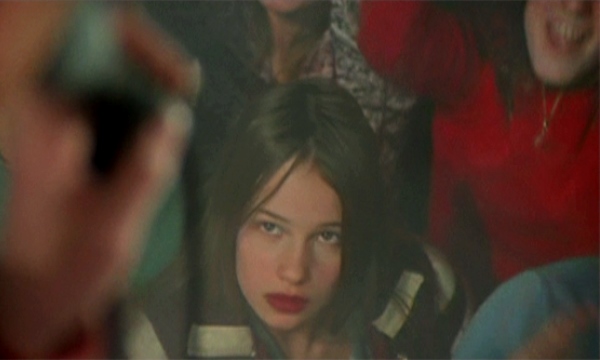
It’s like having your head washed in a toilet for a little more than two hours. Christiane F., from Germany, is one of the heralded foreign films of the early 1980’s, aggrandized by the shock value of graphically depicting 13-year old children helplessly hooked on heroin. Somehow in the DVD age, it has become unbearably difficult to track it down and find a legitimate copy (the film is notoriously known for having a cut that features terribly out-of-whack and embarrassing English dubbing; go the extra mile to find the German audio with English subtitles). I’m hear to tell you, that while not a masterpiece, it is a must-see that’s worth your while to seek out. Unsparing, explicit, striking in its blue-tones cinematography, searingly well-acted, at times agonizing.
Christiane (Natja Brunckhorst) slips into a nightclub called Sound that is a labyrinth of dispensed alcohol, hangout pockets, movie showcases, drug user corners, more and more corridors, more that’s seemingly endless. She meets various characters there, some of them longtime users and a few guys on the hunt to look for vulnerable young girls. Eventually, the core addiction is too costly to even hangout at the club. Forget dancing or people mixing, the band of teens just want to go off somewhere quiet and get high.
The film suggests a time in the early 70’s when train stations, specifically the Bahnhof Zoo Station, were a druggie barter zone and cruising spot for johns. Christiane at first shows up to offer love and support to her boyfriend Detlev (Thomas Haustein) who is there to find older men who want tug-jobs, then it’s a matter of weeks until Christiane moves from begging for loose change to turning tricks herself.
Where is Christiane’s mother in all this? True affluence is non-existent, but there’s middle class means within her family. But the problem is the mother, who appears to have a good job, believes in letting her daughter go out and live her life as an adult — as a way to grow up as an adult. Let the young go out and learn through their own mistakes, is the mentality. That low monitoring method also coincides with the mother’s preference at a time when, if Christiane is out the door, she can have more privacy with her new boyfriend.
When she does catch Christiane using heroin, the mother goes the cheap route, and suggests she and her boyfriend stay locked indoors to go through the withdrawals. The withdrawals are painful to watch, and you get probably the most vivid scene of projectile vomiting that serves the drama that I’ve ever come across.

“I can control my using,” is Christiane’s declaration at the beginning. Her druggie friends told her that no one can control it once you start. Once everyone is hooked, Christiane and her friends are too high to think about doing anything else but shooting up, and in the process, forget to take care of their bodies because drug using is one endless spiral. The number of blotches and bruised skin piles on. Christiane at one point breaks apart her mother’s apartment, tossing things left and right, looking for spare change to go out and buy. The most hideous scenes of the film come after, for at some point she uses a toilet bowl to clean her syringe.
Damn if “Christiane F.” doesn’t bring on a heavy litany of horrors. Let it be known it is specifically based on a true story. But it could be any reckless teen’s true story at any place in the world today, some nearly forty years later.
Note: The region-free Blu-Ray is often cheaper than the DVD, that’s the way to go as long as you have a region-free Blu-Ray player.
Grade: B+
138 Minutes. Rated R.
DRAMA / ADDICTION MOVIES / FOOD FOR THOUGHT
Film Cousins: “Less Than Zero” (1987); “Drugstore Cowboy” (1989); “Thirteen” (2003); “Lilya 4-Ever” (2003, Sweden).
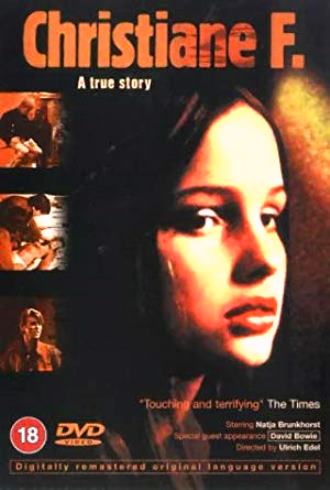
SCARECROW
We have seen all types of Al Pacino performances that suggest the breadth of his range. I hadn’t seen Scarecrow (1973) since I was 12-years old, but returning to it, I seemed to have gotten the final piece of the puzzle that truly defines the wizardry acting of Pacino, and the wild breadth of his range. Pacino has never really played a dumb character, but here as Lionel the drifter he is one. Really dumb, but done with realistic pathos. The walk is a little boyish, his entry into conversations klutzy as if he wasn’t quite formed for adulthood, a clownishness that is juvenile, and a naivete that explains why he’s been tugged around in life never making committed, focused decisions. This is a giant contrast to the gravitas he brought to “The Godfather” among countless others.
Gene Hackman might possibly give the better performance as Max, the other drifter that Lionel hooks up with (he won the Best Actor Oscar for “The French Connection” two years earlier, but Max was his most favorite character he says he ever played). Max is a ruffian, a blowhard, good with the ladies, but would rather pick a fight first. Lionel might be the first friend he comes across that might tame his belligerent ways.
The two of them hit the road with a two-stop plan. Lionel needs to go to Detroit to see the kid of his he’s never met. Following that, Max will take them to Pittsburgh to collect his savings and loans and, after that, open up a car wash. Do either of these guys know anything about operating a car wash? Probably not, but the two certainly seem to suggest having a strong blue collar work habit.
The film’s problem, as well as its deliberate design, is that it meanders. These guys never get to where they’re going because they lack, ahem, focus. When the two finally get their act together, the film decides to rush things so it can finally get to its dramatic destination. It’s easy to admire the film constantly, you can’t help but hold Pacino and Hackman in high regard for playing these raggedy men, but you also can’t help but sigh because you want them – and the film they’re in – to pick up a little faster. Pacino and Hackman, though, they’re the ones that make this a worthwhile film to succumb to forty-plus years later.
Directed by Jerry Schatzberg (“Panic in Needle Park”), the film shared the Grand Prize at the Cannes Film Festival in 1973.
Grade: B
115 Minutes. Rated R.
DRAMA / ADULT ORIENTATION / LATE NIGHT CHARACTER STUDY
Film Cousins: “Midnight Cowboy” (1969); “Vagabond” (1986, France); “My Own Private Idaho” (1991); “The Saint of Fort Washington” (1993).
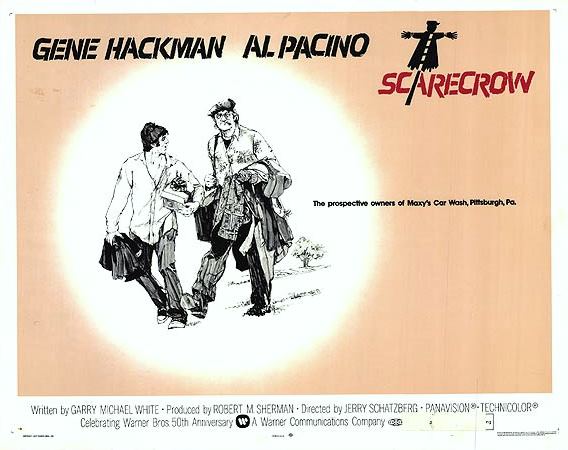
THE PLEDGE
“I made a promise, Eric. You’re old enough to remember when that meant something.”
Of the detective movies of solving the grisly crime of a young girl’s murder, there are few that are distinguishable in attempting to do more than the obvious. The Pledge (2001) was also one of the last times Jack Nicholson delivered a method performance that was outside of his own persona. He plays Jerry Black, a Nevada police detective whose retirement party is interrupted by the news that a young girl has been brutally murdered and left in the snow. Black is compelled to attend the murder site, then compelled to be the one to inform the grieving parents. Not before long, a mentally disabled and dangerous suspect (Benicio del Toro going full demented) has been arrested and is coaxed into a confession by another detective (Aaron Eckhart as a hotshot), and by inexplicable circumstance, the suspect recovers a gun within the police station. He is shot dead. As soon as possible, the precinct declares it a closed case.
Black, a single man with no family attachments, is supposed to go on a Baja California fishing trip as his retirement hurrah, but has some nagging suspicions that the real suspect is still out there. He is convinced and then obsessed, but when he talks to his former boss with his new collection of clues he gets laughed off (here I don’t actually believe that Black was expecting to not be laughed off, at least a little). He decides to go fishing off of Lake Tahoe instead so he can continue to look into the case. Furthermore, he is compelled to purchase a gas station and mini-mart to make it his stakeout – he believes the real killer will someday pass by and purchase gas, and has reason to believe that this killer is a tall gangly man who drives a long black car. This is how he will spend his retirement.
Then he meets a battered woman named Lori (Robin Wright Penn) with a daughter, and finds himself inviting them to live with him, no strings attached. The woman falls for him, and the daughter warms to him as well. Black has so long been an abstinent detective in his days that it’s a surprise he’s any good at relationships, but he is. Black is a man who hasn’t felt a hug of affection from a woman in a very long time, it’s almost foreign to him. But he’s gentle and non-threatening, and so a good match for Lori and her daughter.
Where Black goes wrong is when he convinces himself the killer has stopped by his gas station, and is making Lori’s daughter his next rape and murder target – that this killer is specifically scoping her out. Where he goes doubly wrong is when he decides to use the girl as bait to catch a killer. Since, you know, that’s wrongful endangerment to an innocent child.
The mystery of the film is whether or not Black is right in any of his assumptions. If he is, his methods are questionable and yet if his inferences are correct then he is setting himself up for being the man who was able to takedown a decades-long rapist and murderer of girls. What “The Pledge” turns out being though, in addition to being a mystery, is a study of a man who for too long habituated into solving crimes and predisposed into expecting the worse out of human nature, though these instincts get the better of him. “The Pledge” leers into an unlikely conclusion that is a whopping coincidence, but if whopping coincidences are to happen in the movies then at least be grateful to director Sean Penn for milking as much emotional truth as possible, as well as expertly bracing its themes of obsession being its own vortex.
 Nicholson being gung ho or traditionally charismatic is nowhere to be found, alas, he is a very internally sad man with an acute need to be the hero who brings justice to the world. He will let this case drive him to losing his composure. Robin Wright, at the time Penn’s wife, has never disappeared into a role like this, and looks like a weathered person who has spent a life surviving terrible abuse. These are great performances. In shorter roles, Harry Dean Stanton, Sam Shepard, Helen Mirren, Vanessa Redgrave, Tom Noonan and Mickey Rourke also do credible work. From beginning to end the movie carries us, for our hearts are pinned to the little girl lost in the snow.
Nicholson being gung ho or traditionally charismatic is nowhere to be found, alas, he is a very internally sad man with an acute need to be the hero who brings justice to the world. He will let this case drive him to losing his composure. Robin Wright, at the time Penn’s wife, has never disappeared into a role like this, and looks like a weathered person who has spent a life surviving terrible abuse. These are great performances. In shorter roles, Harry Dean Stanton, Sam Shepard, Helen Mirren, Vanessa Redgrave, Tom Noonan and Mickey Rourke also do credible work. From beginning to end the movie carries us, for our hearts are pinned to the little girl lost in the snow.
Grade: B+
124 Minutes. Rated R.
MYSTERY / ADULT ORIENTATION / LATE NIGHT BRAIN-TEASER
Film Cousins: “The Crossing Guard” (1995); “Insomnia” (2002); “Prisoners” (2013); “Three Billboards Outside Ebbing, Missouri” (2017).
THE BOUNTY
“Mr. Christian, your brain has received too much sunlight and your body overindulged in sexual excess.” – Captain Bligh
One of the nicest and more unexpected surprises I’ve had in months in the discovery of this Anthony Hopkins and Mel Gibson take on the English historical figures Captain William Bligh and Fletcher Christian. I had one of those moments, “I can’t believe I hadn’t seen this way earlier in my life!” The Bounty (1984) sets off as your usual high seas adventure in the old eighteenth century with blistered and discontent seamen warring the usual quarrels with each other (so the usual, but it’s not bad at that), only to come distinguishably alive when the ship disembarks in Tahiti. These English seafarers have literally crashed upon a paradise. It’s no ordinary paradise. Of this or any other century, it is a taboo paradise. I as a viewer had a shock: I don’t think there’s a paradise that exists in our current century that can equal this one. Beautiful naked women, folk song traditions, endless fruits, straightforward community sharing and trading, and a beach that is as splendid as any in our dreams of the South Seas.
It’s not a place that any lustful man would want to leave. Many of the men, and certainly Gibson at his most hunky period as Fletcher Christian, obviously don’t want to leave this most alluring place on Earth. Yet the formal and uptight Captain Bligh (Hopkins) insists that everybody must leave to continue on their circumnavigating around the world expedition on their ship, the HMS Bounty (His Majesty’s Ship). Captain Bligh is obviously a man of integrity, with unassailable loyalty to country, and he has the responsibility to adhere to the rules. While he understands the virile nature of men, he decides that the deserters must be punished just to keep order. This however sparks a major riff between the men, between the devout and the pleasure seekers.
 They make it back onto the seas to continue their voyage, where there is of course the mutiny with an out of control led by the ship’s first mate (Mad Mel!) taking over the steer. Fletcher wants to return to paradise forever, and give desertion rights to any man who chooses island life. The Tahitian King, not so welcoming to their return, thoughtfully explains why that idea is not so simple. He fears retribution by King George of England, and suggests that Fletcher take his daughter and relocate.
They make it back onto the seas to continue their voyage, where there is of course the mutiny with an out of control led by the ship’s first mate (Mad Mel!) taking over the steer. Fletcher wants to return to paradise forever, and give desertion rights to any man who chooses island life. The Tahitian King, not so welcoming to their return, thoughtfully explains why that idea is not so simple. He fears retribution by King George of England, and suggests that Fletcher take his daughter and relocate.
Admittedly, I have avoided seeing every version of this story. I learn that this was the fifth “Mutiny” film. Having seen it, I have no desire to go back and see every tame and creaky old version of the past. I can’t imagine drubbing my way through the 1935 version for instance, which couldn’t possibly deal with the sexual allure of what a paradise really meant. I understand that previous versions dealt with the contentious relationship between authority and underlings, with surplus emphasis of Captain Bligh simply painted as a blowhard martinet. Sorry, pass.
Historically, Christian Fletcher wanted more than just sex and relaxation – he attempted in various islands to piously spread Christianity. In this case, Gibson just wants to indulge in the lustful life. It’s definitely a flaw for the film not to investigate thoroughly with this late chapter history of Fletcher Christian’s evangelism, but the way that “The Bounty” goes about its own business, it nevertheless has an audacious way of saying what it says. I think only in the risk-taking of the mid-1980’s, when there was still some leftover do-it-for-art sensuality that defined the 1970’s, was a take like this able to actually make it to the screen. In today’s times, this kind of nudity and bold statement about man’s surrender to hedonism could not, and would not, be presented in a major Hollywood film.
In addition to the dignified acting by Hopkins and tenacious acting of Gibson, there are also superb early performances by both Liam Neeson and Daniel Day-Lewis who both come through vividly, and venerable appearances by Laurence Olivier and Edward Fox.
“The Bounty” was directed by the underrated New Zealander Roger Donaldson who made this his first Hollywood production, and has made other films that I truly admire: “Smash Palace” (1981), “No Way Out” (1987), “Thirteen Days” (2000) and “The World’s Fastest Indian” (2005).
Grade: A-
132 Minutes. Rated R.
HISTORICAL DRAMA / THINKING TEENS / FOOD FOR THOUGHT
Film Cousins: “Mutiny on the Bounty” (1935); “Mutiny on the Bounty” (1962); “Rapa Nui” (1994); “Master and Commander: The Far Side of the World” (2003).
LOVE AND DEATH ON LONG ISLAND
“Ronnie Bostock has brought me into contact with all I never have been.” – Giles
This is the John Hurt obscurity that became an essential must-see following the actors’ death. Love and Death on Long Island (1998) is a character study — and droll comedy — of a stuffy Brit longing for the unattainable in a world he knows nothing about. It should be impossible to make this film convincing, but so it is. Hurt’s Giles De’Ath is a creaky old British writer who despises anything modern, coming close to being the most boring human being portrayed in a movie since Anthony Hopkins in “The Remains of the Day.” Take that one: While Hopkins was a boring human who becomes dictated by duty, that film itself is endlessly fascinating to me probably because it risks it all and goes all in. “Love and Death” comprises that kind of risk-taking.
The way Giles turns out to be not that boring but a man with hidden fantasies is part of this tale’s strange charms. Indeed, his journey turns into spry comedy unexpectedly. I’m thinking the Giles character hasn’t been to a movie for thirty years. After accidentally locking himself out of his house, he decides to go see an E.M. Forster adaptation but takes him a few minutes to realize he has stumbled into “Hotpants College II.” It might as well been “Porky’s.” He haughtily grabs his coat to leave but is caught frozen when the image of a particular actor named Ronnie Bostock (Jason Priestley) stops him in his tracks. He is mesmerized.
Most of the subversive humor is derived from the idea that Giles is in denial about why he becomes obsessed with Ronnie. There are humorous exchanges between Giles and the employees at a video rental store when he starts going down the list of titles he must see, including ones called “Tex Mex” and “Skidmarks.” At home, a movie magazine clipping says, “‘Hotpants College II’ is a puerile romp without a single redeeming feature.” Yet Giles clamors overwhat a special actor Ronnie is with truthful nuances that rise above the material. He hints the thesis to his next book is about the unexpected findings of beauty in the world, now that he is an expert on beauty. What an open-hearted intellectual!
Yes, here is a man who is not sexual in the usual discernible way, and yet there are sparing hints of it for the rest of the film that he is for the first time in a categorically celibate life that he is infatuated with, well, a sex object. This triggers Giles on a quest from Britain to Long Island to stalk Ronnie Bostock, yet in his mind, he shall do it with good taste. Giles meets Ronnie’s girlfriend first in his trek (he is of course disappointed that a girlfriend even exists), and uses a great glossary of words to praise Ronnie’s talents so perhaps it can spark a get-together.
Giles gets leeway because he can come off as a renown writer of important works, so of course Audrey lets him in. Priestley, known then for the teen prime-time soap “Beverly Hills 90210” during the 1990’s, turns out to be pitch perfect as this guileless B-movie star with dude-like interests yet with serious thespian aspirations, and he loves rhetorical feedback from a guy like Giles. As for Giles, well, Ronnie could be less than dreamy in person and yet nothing can stop him from interpreting Ronnie as this dreamboat. There is a diner conversation at the end of the film that lays all feelings bare, and you just want the character to stuff a sock in it. In a ruefully funny way, stuff it, I mean. Hurt, from top to bottom and inside out, is absolutely brilliant the whole way through.
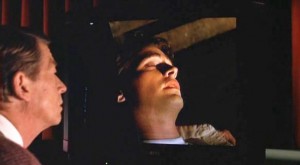 I should say Giles’ story hits me with some empathy. There are people in this world that would ask me with a cringe as to why an arty guy like myself would want to watch “Princess Diaries 2: Royal Engagement” and so I hide it, because I wouldn’t want them to know of my helpless lust for Anne Hathaway.
I should say Giles’ story hits me with some empathy. There are people in this world that would ask me with a cringe as to why an arty guy like myself would want to watch “Princess Diaries 2: Royal Engagement” and so I hide it, because I wouldn’t want them to know of my helpless lust for Anne Hathaway.
Note: “Love and Death on Long Island” was directed by Richard Kwietnioski whose career was sadly limited due to lack of commercial success, but did coax Philip Seymour Hoffman to give one of his best performances in “Owning Mahowny” (2003), also featuring Hurt in a great supporting performance. When it comes to Hurt, you look at all the Best Actor winners from 1998 and you have to wonder, from Ian McKellan in “Gods and Monsters” to Roberto Benigni in “Life is Beautiful,” how so many award group polls could have gotten it so wrong.
Grade: A-
103 Minutes. Rated PG-13.
COMEDY-DRAMA / ADULT ORIENTATION / SPRING AWAKENING
Film Cousins: “Gods and Monsters” (1998); “Chuck & Buck” (2000); “Owning Mahowny” (2003); “Moonlight” (2016).
EVE’S BAYOU
“The summer I killed my father, I was 10 years old.” – Eve
Here is one that plays even better today, a rare African-American family ensemble drama set in the Southern Gothic 1960’s. Eve’s Bayou (1997) plunges into the Louisiana backwaters so vividly that immediately we feel like we are seeing something fresh. Samuel L. Jackson is the popular community doctor who lives with his wife and children in an attractive home by the bayou. He’s too popular with the ladies, which causes friction with his wife and her kinfolk, and spurs jealousy between his daughters because one is more favored than the other. The narration over the first scene of the movie promises, of course, that Eve will commit a fateful act by the end of that hot Louisiana summer.
The themes are loaded topics: supposedly happy relatives nevertheless addicted to “family drama,” the strain of infidelity that runs trouble through the household that cause sibling rivalry and discord between daughters and mother, and general secrets and lies. Here’s a droll side note that just drummed up in my head: The year before this film came out, in 1996, the British film “Secrets & Lies” was the most acclaimed film of the year (while it has its’ tart moments, it’s very kitchen sink drab in retrospect). Twenty years later, nobody cares about that one and movie fans today are discovering “Eve’s Bayou” which was comparably overlooked in its time.
Yes, the story does delve into far-fetched hokum with voodoo and psychics that have premonitions of tragedy and catastrophe that is telegraphed for us before the plot gets there (keep in mind, there are always hooks and tricks to these things too). But with hindsight, wouldn’t there be a lot of working class psychics and mystics working these areas in that time period, too? Whenever it goes too far with this gimmick, you still can’t say the film doesn’t ooze with atmosphere.
It was quite a feat by first-time filmmaker Kasi Lemmons (Lemmons was once an actress who went on later to direct “The Caveman’s Valentine” and “Talk to Me,” both of which I recommend) to have made a torrid family drama about affluent African-Americans in a period setting no less, one that is visually glistening, with richly diverse characters of class and profession, to have put Jackson on-screen as a womanizer and yet put the narrative within the prism of a female point-of-view, and have nodded to the style of Tennessee Williams but still retained its own singular voice.
Lynn Whitfield is the matriarch projecting fake self-confidence and authority, dwelling in surface elegance, but it’s all veneer. It’s a terrific performance of a woman who nearly has it all, but doesn’t. The girls that drive the story are splendid, too, starting with Jurnee Smollett as Eve and Meagan Goode as the 14-year old Cisely who will not only protect her father under all circumstances but ready to make any other person suffer who blasphemies his name. The story only blows up into bigger dimensions as it goes along, because you wonder the hows’ and whys’ as to the sins we know Eve will commit. The girls love each other, too, and they are each others’ anchor, but this is the kind of story where the slightest misunderstanding between them can result in blow up tumult.
It’s crucial that Jackson is as prosperous and suave this believably. For all his character attributes, he is unkeenly aware to how his behaviors stir the pot of secrets and lies that besiege his family. It’s another underrated Jackson performance, in a career full of them. In this case, we know why his girls are drawn to him, and also as to why they compete so jealously for his approval.
“Eve’s Bayou” is a tragedy, but it is inevitable. It had to be.
Grade: A-
110 Minutes. Rated R.
PERIOD DRAMA / ADULT ORIENTATION / AFTERNOON FOOD FOR THOUGHT
Film Cousins: “The Color Purple” (1985); “Crooklyn” (1994); “Black Snake Moan” (2006); “The Great Debaters” (2007).
A NEW LEAF
“She’s primitive, she has no spirit, no wit, no conversation, and she has to be vacuumed every time she eats.” – Henry Graham
One of my favorite comedy surprises of recent years. A New Leaf (1971) has become an obscure, hard-to-find title. But since I found it, I can say it is my favorite Walter Matthau movie. Matthau is Henry Graham, a middle-aged ne’er do well who has never worked a day in his life. Henry is informed by his accountant that he is broke. His mean-spirited uncle gives him a loan with the provision that he forfeits all property if he can’t repay it in six weeks. With no work skills to speak of, his butler Harold (George Rose) advises him he can marry a rich girl to pay his debt before time runs out. Henry’s choices are rich hags and klutzes. Henry finds a gullible klutz with Henrietta (Elaine May, who also wrote and directed), who is so homely and helpless he could kill her.
The genius is in the scenario of fooling the rich woman and in the devious dialogue in which Matthau flatters this woman he despises. There are a number of howlingly funny scenes. One has Henrietta has dropped her tea cup twice at an upper class party and is admonished by the hostess, so Henry deliberately pours his own drink onto it. “Take your damn carpet to the cleaners, and send the bill to me!” he wails, and walks away a hero in Henrietta’s eyes. There is another priceless scene, after Henry has fast-tracked a wedding proposal, where his uncle spills the beans to Henrietta about his bankruptcy which has Henry quickly improvising to sway his future bride back onto his side.
They marry quickly, Henrietta pays Henry’s debt, and they go on a honeymoon where the first night isn’t romantic in the bedroom, but inept – Henrietta can’t get out of her Roman toga. Henry is committed to this graceless, guileless and total pushover of a woman who happens to have a lot of money. Henrietta’s saving grace is her work as a botanist, which propels a lot of trips into the woods. Henry first fires all of Henrietta’s domestic servants who have swindled her (talk about taking command of the castle!), then plots to kill her to reap inheritance and bring himself back to his bachelor way of life.
It’s a great comedy with a number of priceless scenes, and of course, Matthau is rakish in all intentions and May is just as terrific as a clueless wallflower whose eyes beam nothing but love for him. Now is the time, however, to tell you that May had a well-publicized bout with Paramount Pictures in post-production. May’s version was a cumbersome 180 minutes, featured two murders spurred by a blackmail plot, one death was acted out vengeance against an unscrupulous lawyer. Paramount executive Robert Evans took the print away from May and chiseled it down to 102 minutes. May tried to take her name off the film and unsuccessfully sued to keep the studio from releasing the film. Matthau has said he liked the studio cut better.
Yes, the studio cut – without ever having seen the May footage which she has never found a way to release – feels like the cut it should be. It leads to a fine resolution the way it is. Henry and Henrietta turn a new leaf when she convinces him that an unexpected union is nothing to sneer at.
After wading through a bunch of Matthau titles the last couple years, I’ve chosen “A New Leaf,” “Cactus Flower,” and “The Fortune Cookie” as my favorites of his. I’ve seen “A New Leaf” twice this year, though, and I can’t get enough of Matthau in it.
May went on to write and direct another cult classic “The Heartbreak Kid” (1972), but later on, was chastised for the embarrassing folly “Ishtar” (1987). May wrote some Mike Nichols films such as “The Birdcage” (1996) and “Primary Colors” (1998).
Grade: A-
102 Minutes. Rated G.
COMEDY / MILD & CHARMING / WEEKEND AFTERNOON MOVIE
Film Cousins: “Arthur” (1981); “Tommy Boy” (1995); “Rushmore” (1998); “Born Rich” (2003).
THE BOX

I enjoyed it more the second time around when I stopped trying to tie up all the loose ends.The Box (2009) is one to sit back and enjoy being alternately dazzled and confused without worrying about arriving at absolute clarity. Surrender to its trancelike and mysterious qualities and do not concern yourself with feeling that you need to know everything. Enjoy the spell that filmmaker Richard Kelly (“Donnie Darko,” “Southland Tales”) puts on you, let it end, and be content with its ambiguity.
A secret organization with sinister but undefined motivations toys with the people of Arlington, Virginia in the year 1976. In a black coat and with a disfigured face, Arlington Steward (Frank Langella) shows up at the door of the Lewis’ family offering them a box with a glass dome that covers a big red button. Arthur and Norma Lewis (James Marsden and Cameron Diaz) have 24 hours to decide whether to push the button. If they do, they will inherit $1 million dollars tax free. But elsewhere in the world someone random will die as a result. The consolation is the victim will be someone they do not know
Reoccurring visual motifs include characters bleeding from the nose and dispossessed people frozen in stone-face. Kelly is also obsessed with gateway portals: One character must guess the gateway to “salvation” or to “eternal damnation,” echoing homage that is reminiscent to “2001: A Space Odyssey.” The imagery is often startling and dislocating, and then sometimes just nonsensically weird. Big studio movies are rarely this weird, and that could be a plus if you are attracted to strange oddities.
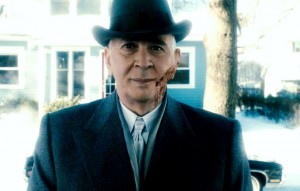 “The Box” hits some frightening notes and further perplexes you with enigmatic symbolism. Marsden and Diaz bring the right amount of disgrace to their characterizations after they make their initial immoral decision, and suffer in their guilt. Langella performs his role with an aura of shadowy malevolence and a clout of imperialist supremacy. Arlington is a spook, a seedy businessman, a mystic, and something of a boogeyman. No need for graphic violence, with Arlington and the movie itself, you’re chilled to the bone.
“The Box” hits some frightening notes and further perplexes you with enigmatic symbolism. Marsden and Diaz bring the right amount of disgrace to their characterizations after they make their initial immoral decision, and suffer in their guilt. Langella performs his role with an aura of shadowy malevolence and a clout of imperialist supremacy. Arlington is a spook, a seedy businessman, a mystic, and something of a boogeyman. No need for graphic violence, with Arlington and the movie itself, you’re chilled to the bone.
On a final note, Warner Bros. made it a big deal in the first-run theatrical ads at the time that it was based on a Richard Matheson story, the famous literary writer whose adapted works include “The Incredible Shrinking Man,” “What Dreams May Come” and “I Am Legend.” But “The Box” was originally a skimpy short story that was a set-up and a punchline told in five or six pages. This is more of a work by Kelly as author with a nod to Matheson if anything.
Grade: B
115 Minutes. Rated PG-13.
SCI-FI / MIND-BENDER / SATURDAY NIGHT WEIRDNESS
Film Cousins: “2001: A Space Odyssey” (1968); “Eraserhead” (1977); “Donnie Darko” (2001); “Timecrimes” (2007, Spain).
WAR OF THE WORLDS
Blow-it-to-smithereens creature feature with superficial metaphors. War of the Worlds (2005) teamed director Steven Spielberg and Tom Cruise together in a surefire light up the skies blockbuster formula. In a mindless way, the movie is rollicking excitement even when it’s hugely banal. The aliens’ motives are never that complicated – they want to terminate earthlings and take over the planet as their new habitat. By the looks of things, though, it would have been a lot simpler for them to take over Venus or Uranus where there would be no life forms to worry about relocating. But they chose Earth, so be it.
The freakish weather patterns forge an ominous sign. The skies are filled with looming gray matter, and in the center of its spherical apex an abnormal series of lightning bolts strike the streets of New York. We’ve seen this sort of weather phenomenon to hype things up in “Independence Day,” “Twister,” “Armageddon” and “The Core.” Cue in a bunch of typical shots of everyday people gawking at the skies above them. Tom Cruise, as crane operator and dad Ray Ferrier, remarks “how cool” to his two children (played by Justin Chatwin and Dakota Fanning). If Cruise is remarking to the special effects, then agreed, they are cool. The beings, which have been hibernating beneath the surface of the Earth, spring up from the ground and start zapping us.
The aliens in attack mode, operating and attacking in three-legged machine tripods, force entire communities to run, run, run for their lives. There’s not enough science to explain why Ray is the only one to get an automobile to operate on a highway stunted with stalled cars – is there a theory about electromagnetic retrograde somebody can explain? Ray’s daughter shrieks and whines a lot in terror, his son scoffs in rebellion to the whole alien invasion. They go on the run some more. Hopefully so Ray can reconnect his kids with his ever-bitter ex-wife (Miranda Otto). We’re supposed to care as to why they split up.
When a train on fire roars through a port city, there is collective community fear that there is no escape by transportation that’s going to work. People are going to have to trample on top of each other to get where they are going to go to next. Boarding a river ferry only seems like it will alleviate the problem, for survivors to get off their feet, away from bigger clusters of people. But then the aliens attack them while it is in the water, and the whole ship tipping over while bodies fall helplessly into the water is viscerally terrifying. Getting zapped is one thing, but there is peril in being crushed to death by wreckage or dragged under and drowned by various weights. Stunning action choreography, the lights, the sounds, the Spielbergian works.
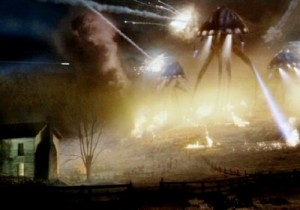 The battle of wills between Cruise and Tim Robbins (as a total nutcase, not subtle) in the basement is one section desperately stretched out a bit too long, almost as if there is the message that terror can be in had in too much hiding and avoidance. The events in Robbins’ basement allows the viewers to get closer to the naked alien as it infiltrates, and closer to its steel-saucer apparatus that it retreats to. If only Spielberg had allowed us to understand the enemy. They seem to zap half of us, and then capture and harvest the rest of us, even though there was no previous indication that the aliens needed our blood. Without understanding and comprehension of certain details, it’s no surprise that “War of the Worlds” as a whole leads to a practically arbitrary conclusion as well.
The battle of wills between Cruise and Tim Robbins (as a total nutcase, not subtle) in the basement is one section desperately stretched out a bit too long, almost as if there is the message that terror can be in had in too much hiding and avoidance. The events in Robbins’ basement allows the viewers to get closer to the naked alien as it infiltrates, and closer to its steel-saucer apparatus that it retreats to. If only Spielberg had allowed us to understand the enemy. They seem to zap half of us, and then capture and harvest the rest of us, even though there was no previous indication that the aliens needed our blood. Without understanding and comprehension of certain details, it’s no surprise that “War of the Worlds” as a whole leads to a practically arbitrary conclusion as well.
The story concluding on long-shot odds don’t seem remotely plausible (how did so many Boston brick-houses survive the mass alien zap devastation?). But the biggest gyp in storytelling sense in retrospect is to wonder why the filmmakers made Cruise’s one-dimensional flunky the front and center protagonist in the first place. Did he contribute anything special or become a miraculous man in statistics that merited him to be the film’s protagonist? Why not take the story point of view of a disgraced military man or general, or someone crucial to turning the tide of war against the aliens? I mean, a crane operator? Geez. Spielberg has enough of a camera eye to create some superficial allusions to 9/11 or panic in wartime, but it’s his basic ability at staging visceral thrills that gets us mindlessly involved in “War of the Worlds,” which otherwise is one of the dumber movies he’s made.
Cruise’s better sci-fi action movies are “Minority Report” with Spielberg, and the current “Edge of Tomorrow.” Better because they are brainier. But I won’t deny that “War of the Worlds” is sorta fun as an exercise in narrow escape death scenarios.
Grade: B
116 Minutes. Rated PG-13.
ACTION-ADVENTURE / CREATURE FEATURE / SATURDAY NIGHT GOOSEBUMPS
Film Cousins: “War of the Worlds” (1953); “The Thing” (1982); “Independence Day” (1996); “Transformers” (2007).
THE ASSASSINATION OF JESSE JAMES
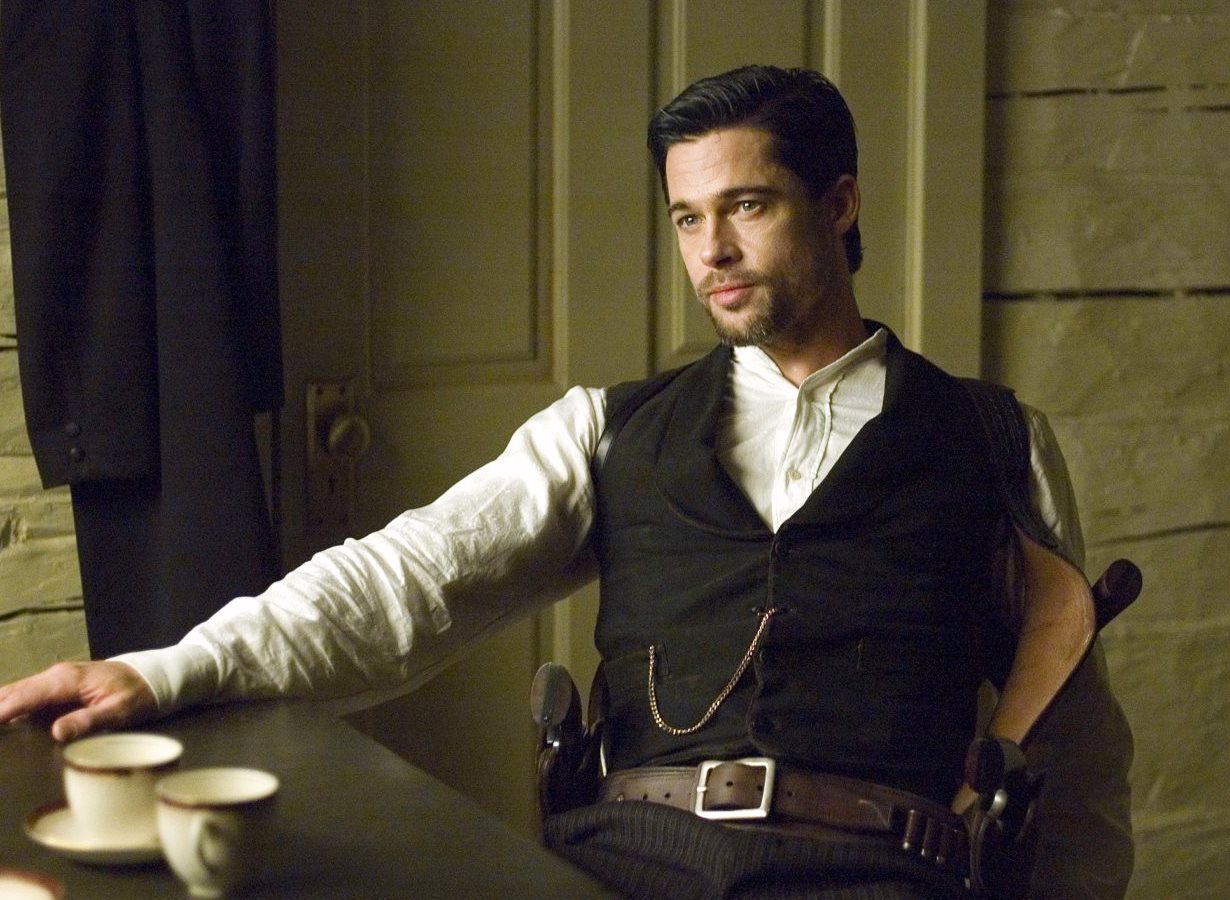
This one marked the beginning of the reinvented Brad Pitt career renaissance. The Assassination of Jesse James by the Coward Robert Ford (2007) was the one to me that began the Pitt hot streak (acting for big-time directors Tarantino, Malick, McQueen), which came to the end with one bad movie recently: “The Counselor” in October 2013. Taking on the legendary outlaw Jesse James, the film was a piece of history revisionism showing the outlaw as a family man with the modest dream of settling down.
The antiquated style is integral to its mood. Australian director Andrew Dominik (“Chopper”) and Oscar-nominated cinematographer Roger Deakins (“The Shawshank Redemption”), in collaboration, pulled off marvelous visual feats. Widescreen shots have a painterly elegance, while in some close-up shots, the edges of the frame are smudged and hazed that give off a crystal ball effect – like we’re eavesdropping through a time warp into the past.
The film turns back the clock so that we can see how differently people lived in the late 1800’s, for better or grubbier. How a family man’s breadwinning ambitions differed, how people bathed in aluminum tubs, how their idea of group male talk is conducted (humorous, uneducated twang). Most of these characters are criminals on the outskirts of society, but they have their homes – homes on the prairies where they are recluses for months until they ride into town for purposes of this and that, or to rob and steal.
As for crony Robert Ford (Casey Affleck, “Ain’t Them Bodies Saints”), his ultimate inner desire is to make love to his friend Jesse James’ wife, but we only comprehend this in how he gazes at her. The voice-over narration comments on Ford’s honor in what it means to be a gentleman hand in the household. To feel useful as an extra set of hands in the house is the honor itself for a man in that time period.
Most of the men have the usual characteristics of sadism that has been carried through the bloodline of generations. Other ordinary men are shoved into crime and required to adopt survival methods. The dialogue, such a problem with some viewers, is idiosyncratic, fanciful, and strange of its times. In group male talk, there is a discussion of how poetry is useless when it comes to romancing a whore. In a surprising scene where a criminal is seducing a lady, he talks gushingly of how beautiful her limbs are put together. In an era when there was no pop culture maxims to teach men how to compliment a lady, it’s not surprising that a man would talk about how beautifully attached her limbs are connected.
Jesse James (Pitt in greased black hair and mustache) was indeed the most famous criminal of them all, a legendary bank robber, whose exploits made countless newspaper headlines and trash dime novels – Pitt’s take on the character is just as complex and intelligently told. Up until 2007, Pitt’s bad movies had outweighed his good movies. Let’s take a moment to forget “Sleepers,” “The Devil’s Own,” “The Mexican,” etc. but there was at least “Legends of the Fall,” “Seven,” “12 Monkeys” worth praising in his career. Pitt makes Jesse James a vicious wild card – charismatic but cordial, full of violent contradictions. Yet the fact that Pitt contributed his talents by doing an atypical western, outside of studio convention rules, and directed by an Australian and photographed by an artist, was commendable by itself.
If you hadn’t noticed, the title announces itself on what is going to happen. Robert Ford is a fresh insecure lad, an admirer of Jesse who latches on and nudges his way into Jesse’s gang. Really he’s an unwanted fool who becomes the butt of jokes among the gang. 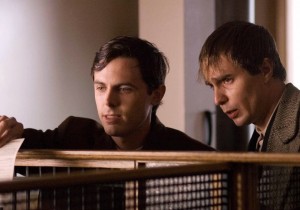 It’s easy to turn the tables on his mentor. Dominik directs with a fatalistic quality, the film plays like an elegy of Jesse’s death before his death is actually seen – we know what’s coming for him even though he can’t. Robert Ford will assassinate Jesse James, but the mystery will unfold as to why he shot him.
It’s easy to turn the tables on his mentor. Dominik directs with a fatalistic quality, the film plays like an elegy of Jesse’s death before his death is actually seen – we know what’s coming for him even though he can’t. Robert Ford will assassinate Jesse James, but the mystery will unfold as to why he shot him.
The film’s masterstroke comes in the fleshed-out final act – the mythology of how cowardice became synonymous with Ford’s name for the remainder of his life. I have turned on the DVD many times over the years just to watch the remaining 25-minutes, which is perfect elegiac storytelling, briskly told and stunningly shot.
The shade of disappointment with the picture is that Jesse’s criminal infamy is implied without letting us see the capers. There is only one train robbery in the film – an exciting one to say the least, dazzlingly photographed in the dark of night with gusts of train exhaust smoke blowing in the face of masked men. But it occurred to me that the film could have had a prologue that contained a montage of Jesse in his bad-boy glory days. Jesse’s outlaw legend is dramatized in hearsay.
But still, come on. “Assassination” is near majestic.
160 Minutes. Rated R.
Film Cousins: “The Wild Bunch” (1969); “Once Upon a Time in the West” (1969); “Pat Garrett & Billy the Kid” (1973); “Ain’t Them Bodies Saints” (2013).
RUNAWAY TRAIN
“No beast so fierce but knows some touch of pity. But I know none, and therefore am no beast.” – Shakespeare’s King Lear
Man versus machine action movie grounded in reality. Runaway Train (1985) is one of the best action thrillers of the 1980’s, it’s got depth plus fierce snowstorm scenery. Jon Voight and Eric Roberts garnered Oscar nominations for Best Actor and Supporting Actor respectively, rare for an action movie. They play Manny and Buck, two Alaskan convicts who hitch on a four-locomotive train that loses the driver to a heart attack. The lead car, an ancient piece of steel operating now at torrent speeds, has no walkway and after a first collision, is burdened by a doorjamb. A third survivor, a woman (Rebecca DeMornay) with some rail yard experience, offers advice on how they can slow down the train.
Early scenes set at the maximum security prison are among the best of their kind for a tough, merciless prison movie. I was recently impressed by the Spanish prison thriller “Cell 211” (2010), especially for its parade of truly vicious looking convicts. Manny and Buck are equally brutal enough for this prison hellhole. After Manny has served three years in the hole, the warden (implied) has provided a lackey prisoner a knife to stab Manny to death in exchange for special privileges. You can stab Manny in the gut and through the hand, but this is not the kind of guy who can be defeated by just a stabbing.
Voight has had a significant career, although it has been a dispersed one (he’s effective in about 1 of every 5 movies he makes). His Manny character really harkens back to his career-making performance of Joe Buck in “Midnight Cowboy” (1969), the only X-rated film to ever win Best Picture. Like Joe Buck, Manny is scarred by a terrible childhood and poor education, and has lived desperately rummaging for scraps. The difference is that Manny has been molded into a violent, merciless animal of a human  being. As for Roberts, he gave one of the greatest performances I’ve ever seen as a sociopath in “Star 80” (1983), finally got Oscar recognition for this movie, but has spent the rest of his career untapped and under-utilized in hundreds of rubbish roles. My myth-building theory: He was too great for his own good playing sadistic, cruel and aggravatingly panicky men in these early roles and could not break away from the stigma.
being. As for Roberts, he gave one of the greatest performances I’ve ever seen as a sociopath in “Star 80” (1983), finally got Oscar recognition for this movie, but has spent the rest of his career untapped and under-utilized in hundreds of rubbish roles. My myth-building theory: He was too great for his own good playing sadistic, cruel and aggravatingly panicky men in these early roles and could not break away from the stigma.
The prison break of these two guys is obligatory and inevitable, but the directing and physical structure of the scene is plausible just the same. Some men would not be able to survive in the Alaskan wilderness, but these guys hack it. Manny finds clothes, Buck is happy about some real shoes, and before long, they are on a train. The screenplay doesn’t waste time setting up the gimmick. The train takes off, the engineer suffers a heart attack, it is unmanned and on throttle for 90 mph. Some screenplays would have wasted ten pages before getting to the gimmick. Speed and velocity, unfathomable Alaskan locations that are so cold you’d think it was Antarctica, two battling convicts with short fuse tempers – this is all you need. Well, a third bystander character in danger and a fourth antagonist (the warden) is helpful in bringing tension.
The woman on the train is truly in danger of physical harm by these two guys, but is able to sway their attention onto the serious situation of a train possibly derailing if something is not done. But once the Alaskan prison warden is trailing them from a hovering helicopter, the two convicts might not necessarily want the train to slow down to a stop either. The film cuts away to a bunch of panicky radio dispatchers (Kenneth McMillan, T.K. Carter) directing railroad traffic, which is surprisingly effective as well as expository as to telling us what the technical stakes are about.
“Runaway Train” is simply effective for being a staggering visual experience. However, the film uses a final Shakespeare quote for closure, not depending on demonstration of action. Most action films wouldn’t be able to get away with it. Somehow, it’s an ending with the right touch because Manny’s fate seemed to be predestined from long before time. We’re fascinated by Manny’s relinquishment to his fate, and not as fascinated by some action gimmick. It works.
Grade: A-
Based on an unused screenplay by Akira Kurosawa (“The Hidden Fortress,” “High and Low”).
111 Minutes. Rated R.
ACTION / RACE AGAINST THE CLOCK THRILLER / LATE NIGHT CHILLS
Film Cousins: “The General” (1926); “Silver Streak” (1976); “Unstoppable” (2010); “Last Passenger” (2014, Great Britain).
ANTICHRIST

“You’re indifferent to whether your child is alive or dead.” – Charlotte Gainsbourg
Grief, Pain and Despair as only the uncompromising Danish filmmaker Lars von Trier can make it. Antichrist (2009, Denmark) is a tough film to watch, one of the dark (and depressing) ones, and yet it makes an indelible impression. In the opening pornographic moments, husband and wife Willem Dafoe and Charlotte Gainsbourg are making love while their toddler escapes from the crib, climbs to the windowsill, and falls out several stories to his death. This is all mysteriously, ironically beautiful – pornographic acts can be beautiful if done right with great lighting and camerawork, von Trier is (perhaps) saying. Many minutes after, the film is mucky and bleak visually, as the husbands acts as therapist to his inconsolable wife. In refusing to forgive herself, she goes crazy while on retreat in the woods and maims her husband in fear that he is going to leave her.
With all the austere emotional anguish, you can’t help look forward to the anticipating shocks and violence to happen between spouses. While the film is getting up to that point, the grimness of the weather and – dare I say “supernatural” evil – of their surroundings affect their choices. Dafoe and Gainsbourg are only referred to as He and She throughout, and what we know is that He is a therapist who is using his occupational strategies to extinguish depression from She. But the inevitable condescension is only abrasive in effect. The smarter He is about psychological issues, the less value of a person She feels about herself.
The cabin in the woods as a removed place to recover only encourages harm. There is something about being in the wrong environment, the wrong habitat that can bring upon psychological duress. And She is likely a bi-polar case, and schizophrenic, with dangerous capabilities. She only believes that in order to keep him, She will have sex with He. Except they are betrayed of the reassuring emotional intimacy – demons surround them while they embrace, visual symbolism per se. She is terrified of being rejected, of being abandoned. The abandonment is so terrifying (that’s the correct word here) that She will nail him to the ground. He will crawl away in pain, nonetheless, and she will hunt for him in the woods while he figures a way to fight back.
Von Trier, ever the theatrical showman when it comes to publicity, stated repeatedly that he was in a terrible depression himself when he made the film. He had a two month stint at a mental hospital right before filming began, and on-set repeatedly excused himself from the actors to go isolate himself with his tears. Von Trier is often over-dramatic, but damn if it hasn’t somehow lent him something in talent and vision when it comes to making films – and in this case, a film about grief, pain and despair (as well as marital retribution). His greatest film remains the harrowing romantic tragedy “Breaking the Waves” (1996), but in returning to “Antichrist,” there are times where he evokes the eerie dread and power of Stanley Kubrick’s “The Shining” (1980). Such comparison is high praise.
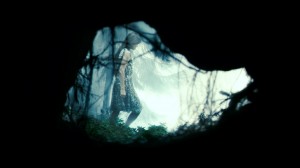 In the simplest terms, He tries to reason with She, but fails. First he tries to dodge her physical attacks, then he tries to hit back only as a matter of defense. But when He sees that She is going to kill him, there is only one way to end it, and that’s by countering by fatal means. Most couples in the scheme of things don’t really hurt each other in a lifetime, there are spats and feuds, but this is a case where spouses fall into a trap of disillusionment and end up physically hurting each other. I feel a haze of gloom while watching “Antichrist,” I felt anxiety and after a time, drained by it. My better conscience informs me I am better off watching films with positive vibes, but I suppose I still want to watch a film like this occasionally to know that I can still be shaken and upset by something.
In the simplest terms, He tries to reason with She, but fails. First he tries to dodge her physical attacks, then he tries to hit back only as a matter of defense. But when He sees that She is going to kill him, there is only one way to end it, and that’s by countering by fatal means. Most couples in the scheme of things don’t really hurt each other in a lifetime, there are spats and feuds, but this is a case where spouses fall into a trap of disillusionment and end up physically hurting each other. I feel a haze of gloom while watching “Antichrist,” I felt anxiety and after a time, drained by it. My better conscience informs me I am better off watching films with positive vibes, but I suppose I still want to watch a film like this occasionally to know that I can still be shaken and upset by something.
SPOILER ALERT AND WARNING: Reactions have been appalled and repulsed with “Antichrist” and disgust with director von Trier in this case involving two scenes of genital mutilation which is so horrifying that even I steered away and shut my eyes, while at the same time admiring the thematic extremes of what the director was going for.
108 Minutes. Unrated. Adults Only. Filmed in Denmark but all in English language.
PSYCHOLOGICAL HORROR / BLOODLUST / LATE NIGHT CHILLS
Film Cousins: “The Shining” (1980); “The War of the Roses” (1989); “Breaking the Waves” (1996, Denmark); “Dancer in the Dark” (2000, Denmark).
DUMA

You’re craving an animal in the wild movie that you haven’t seen. Duma (2005) is set in South Africa, and involves a British boy’s obstinate dedication to a pet cheetah. Xan (Alexander Michaeletos) and his parents (Campbell Scott and Hope Davis) rescue a baby cub from the road one night and bring him home to their prairie. Carroll Ballard, working with the same prosaic naturalism of “The Black Stallion,” “Never Cry Wolf” and “Fly Away Home” (my personal favorite), conjures up unforgettable montages of boy and wild animal communing together.
Call it survivalist adventure: Big wide-open horizons, the lustrous but treacherous deserts, the wild species habitat, and the boy and the cheetah in the middle of it. Xan resolves that he must return his pet to the wilderness plains that he came from once. Duma is near adult age, so to the savanna grasslands they go.
 The film doesn’t quite have the lyrical harmony in its middle passages that make Ballard’s earlier films so great, because it’s a little weighed down by a new relationship Xan makes with a drifter (Eamonn Walker) and their obligatory shifty friendship. No wonder, the drifter has a cloaked agenda until founded out. The film breathes best during such sequences as when Xan and Duma must outrun some hungry crocodiles, or convert a stalled motorcycle into a land yacht. Like so much of the rest of the film, these are stunningly beautiful set pieces.
The film doesn’t quite have the lyrical harmony in its middle passages that make Ballard’s earlier films so great, because it’s a little weighed down by a new relationship Xan makes with a drifter (Eamonn Walker) and their obligatory shifty friendship. No wonder, the drifter has a cloaked agenda until founded out. The film breathes best during such sequences as when Xan and Duma must outrun some hungry crocodiles, or convert a stalled motorcycle into a land yacht. Like so much of the rest of the film, these are stunningly beautiful set pieces.
I was incredibly disappointed when Warner Bros. decided to not release “Duma” into wide release the year it came out, considering that I’ve adored filmmaker Carroll Ballard’s other works. It had test runs in select cities, fared with decent ticket sales, and was pulled before it ever had a chance to reach an audience. The film’s afterlife seems is definitely rely on DVD rentals, it doesn’t show up on cable much. Grade: B+
100 Minutes. Rated PG.
FAMILY FILM / MOTHER NATURE / WEEKEND DINNER MOVIE
Film Cousins: “Born Free” (1966, Britain); “The Black Stallion” (1980); “Never Cry Wolf” (1983); “Fly Away Home” (1996).
THREE WOMEN
“I’m trying to reach toward a picture that’s totally emotional, not narrative or intellectual.” – director Robert Altman
Enigmatic, strange and ambiguous for people who want to see another variation of “Persona” (which came before) or “Mulholland Dr.” (which came after). Robert Altman’s Three Women (1977) is flatly, deadpan kind of weird and simply one of the weirdest of all films. It is either a struggle or a welcome challenge for a viewer to piece it all together. For me, it is not as great as either of the two aforementioned films, it’s self-consciously screechy (I’m talking about the audio effects, the clanking muzak), but it’s a fascinating puzzle for those who study the psychology of maladjusted people. That a film would even dare to be about maladjusted outcasts that don’t fit in is an accomplishment.
Shelley Duvall and Sissy Spacek star as workers at a nursing home in the California desert. Duvall is Millie Lammoreaux, a perpetual chatterbox who won’t stop long past others have long given up listening. Spacek is Pinky Rose (or Mildred), an outsider new to town, who is so childlike and juvenile that she doesn’t seem qualified to even work at this nursing home. Millie, always bugging people to the point they revolt, needs a new roommate and Pinky, desperate for a friend, jumps on the invitation.
Millie treats Pinky as her minion, and feeds her lies about how popular she is and adored by men. Edgar (Robert Fortier) is the only man around that listens to Millie and bothers to entertain her, but he does it in his own self-absorbed way – he’s a drunk, and he’s a selfish sonuvabitch we gradually learn. The third woman of the story is mysterious artist Willie (Janice Rule, often in a sun hat), pregnant, muted, and creates murals of godlike or reptilian creatures on the bottom of pools.
 Repeatedly, Millie is cheerful but clueless, inviting neighbors and locals to dinner parties she’s hosting but isn’t aware that she’s being stood up. Pigs in a blanket and chocolate pudding tarts are her idea of party spread sophistication, no one else’s. Millie has the gall to blame Pinky for her friends “not showing up,” and as a rebuke, welcomes drunk Edgar to sleep with her. (We have learned Edgar is the husband of Willie, the artist.) Pinky is devastated for being shunned as a pest, and what she does next, makes her end up at the hospital where she will lay unconscious.
Repeatedly, Millie is cheerful but clueless, inviting neighbors and locals to dinner parties she’s hosting but isn’t aware that she’s being stood up. Pigs in a blanket and chocolate pudding tarts are her idea of party spread sophistication, no one else’s. Millie has the gall to blame Pinky for her friends “not showing up,” and as a rebuke, welcomes drunk Edgar to sleep with her. (We have learned Edgar is the husband of Willie, the artist.) Pinky is devastated for being shunned as a pest, and what she does next, makes her end up at the hospital where she will lay unconscious.
Pinky’s parents arrive from out of town to see her at the hospital. “I’ve never seen them before,” Pinky harshly responds after she wakes up. Pinky, rebounding from the hospital stay, transforms into an entirely different person – sassy and bold, oozing self-confidence and trampiness. Edgar now switches his attention to Pinky over Millie, allowing Pinky to dominate her in the relationship.
Suddenly, we get an avante-garde sequence that supposedly is Pinky’s dream. The most critical thing I can say about this sequence is that it implies great trauma that took place long before the film’s starting events. Shown in the dream is Willie, the artist, foolishly in love with Edgar from long ago. But if it was Pinky’s dream, then how would she even have a subconscious inkling of Willie’s earlier life with Edgar if she didn’t know them? The answer, I think, is that Pinky has been a part of Willie and Edgar’s life all along.
After the strange dream, Edgar barges in, annoys Millie and Pinky, and says his wife Willie is giving birth. “Why aren’t you taking her to the hospital?” Millie asks. Willie gives birth from home, in a disturbing scene in the pitch black of night, and Altman fills the image with water, or secretion fluid during the birth scene. It feels pivotal to all their lives, a trauma that has engulfed them all.
Pinky, Millie and Willie all share something in common, their pathologies are crossed or not arguably, we don’t know. Do they all share the same traumas experienced within family? These are questions that Altman himself has not answered. And yet this is an invaluable film, it is disorienting and disturbing.
The one question I think you should ask: If the film has any one individual POV, which character do you think the film represents? If you have chosen one character of the three, what do you think it says about her damaged subconscious? In any circumstance, I don’t think any of these characters could survive in a major city, they are too damaged to fit in a common social circle.
Altman says the film came directly from a dream he had, and convinced the studio to bankroll his film without a finished script. The script was completed before shooting began, but dialogue was largely improvised and the dream interpretation was predominantly concentrated upon. Altman’s other hallucination-heavy avante garde piece “Images” (1972) is not nearly as intriguing as this one.
 I have my own interpretation, that could be right, could be wrong, or just different from anyone else’s. During the childbirth scene (which I think is a remembrance in the form of a dream), Millie and Pinky are sisters. Millie slaps her sister for not calling a doctor, but really has been slapping and scolding herself throughout the rest of her lifetime for not doing enough then. Could the baby born be Pinky, even though the dialogue said the baby died while being born? I think Millie was sexually abused growing up by dad (Edgar), was often socially unaccepted, mistreated her sister Pinky as a coping mechanism, and feared her mother whom she felt she betrayed.
I have my own interpretation, that could be right, could be wrong, or just different from anyone else’s. During the childbirth scene (which I think is a remembrance in the form of a dream), Millie and Pinky are sisters. Millie slaps her sister for not calling a doctor, but really has been slapping and scolding herself throughout the rest of her lifetime for not doing enough then. Could the baby born be Pinky, even though the dialogue said the baby died while being born? I think Millie was sexually abused growing up by dad (Edgar), was often socially unaccepted, mistreated her sister Pinky as a coping mechanism, and feared her mother whom she felt she betrayed.
Then the curious final scene. Millie and Pinky stay by mom after she is presumedly widowed. I don’t blame any of the three women for putting Edgar underneath a pile of tires for eternity, if that is what happened (or not). But then again, maybe the whole thing is a dream. Like Altman implied it was. Grade: A-
123 Minutes. Rated R.
PSYCHOLOGICAL DRAMA / MIND-BENDER / AFTERNOON WEIRDNESS
Film Cousins: “Last Year at Marienbad” (1961, France); “Persona” (1966, Sweden); “Images” (1972); “Mulholland Dr.” (2001).
ICEMAN
“He’s a man. Not a specimen. A 40,000 year old man who can teach us about ourselves. Tell us how we evolved.” – Timothy Hutton
Compelling hypothetical of what would happen if a prehistoric man was thawed out from a block of ice. Iceman (1984) is continuously interesting because it’s brainy, curious enough to raise ethical questions of whether they want to dissect him to study the body or understand the thought processes of the mind. The multi-ethnic actor John Lone, immersed into a role of primal and feral acting, plays the title character. The iceman is able to live and breathe, and so he is placed in a controlled environment that feels like the wilderness but is not, just like Jim Carrey was allotted an artificial habitat in “The Truman Show.” Timothy Hutton is the anthropologist interested in giving the iceman more freedom.
Having been years since I’ve seen this last, I was riveted by two developments. One, the thawing process, including the shedding of his damp fur clothing and the electrical shock reviving procedure of the human when they realize he has brainwave activity. Two, the controlled habitat scenes where you wonder how long it will take the Neanderthal to realize his surroundings are artificial. The Iceman will need some human interaction, which is met with Hutton and fellow scientist Lindsay Crouse. He is human, but he is also a dangerous creature from another history of time – and his hostility is difficult to tame ultimately. The film is most fascinating in observing how a Neanderthal would respond to modern machines and contemporary objects for the first time.
 Directed by Fred Schepisi (“A Cry in the Dark,” “Roxanne”), his Iceman doesn’t turn into a typical homicidal monster but is treated with caution and curiosity, with practicality and realism. The ending is beautiful but far-fetched, a climax that considers how a Neanderthal would respect a helicopter that he interprets to be a god in the sky. The iceman feels his destiny is to ride the helicopter so that he can reunite with his long lost family. I do feel a little cheated by the shot and editing choices of how he attaches himself to the helicopter. But it has a grandiosity to it nonetheless, and I took a leap of faith. As a final metaphor of the prehistoric man living by myth, it stirs the imagination. Grade: A-
Directed by Fred Schepisi (“A Cry in the Dark,” “Roxanne”), his Iceman doesn’t turn into a typical homicidal monster but is treated with caution and curiosity, with practicality and realism. The ending is beautiful but far-fetched, a climax that considers how a Neanderthal would respect a helicopter that he interprets to be a god in the sky. The iceman feels his destiny is to ride the helicopter so that he can reunite with his long lost family. I do feel a little cheated by the shot and editing choices of how he attaches himself to the helicopter. But it has a grandiosity to it nonetheless, and I took a leap of faith. As a final metaphor of the prehistoric man living by myth, it stirs the imagination. Grade: A-
Note: The title is not to be confused with the 2013 “The Iceman” with Michael Shannon as a professional hitman.
99 Minutes. Rated PG.
SCIENCE FICTION / THINKING TEENS / LATE NIGHT FOOD FOR THOUGHT
Film Cousins: “Quest for Fire” (1981); “The Clan of the Cave Bear” (1986); “Encino Man” (1992); “The Truman Show” (1998).
SCENES FROM A MARRIAGE
Sour experience of a film that was recently #82 on Entertainment Weekly’s 100 All-Time Greatest Films list and an original 4-star rating from Roger Ebert. Scenes from a Marriage (1974, Sweden) is the Ingmar Bergman film that I hadn’t seen until now, and gratefully so. If I had seen it first, I might never have bothered with his other work and I would have missed titles that mattered: “Wild Strawberries” (1959), “Persona” (1966), “Cries and Whispers” (1973). It concentrates on up close dialogues between a married couple on the fray: Liv Ullmann (as Marianne) and Erland Josephson (as Johan). There are several long episodes, which explains how it was first a 6-hour mini-series for Swedish television. For the rest of the world, it became a 168-minute diatribe on anguished marital friction and inner turmoil, and melancholic things are said like “Loneliness is absolute.” Leave it to the windbags on the internet to tell you how the theatrical version is different from the original 6-hour mini-series.
I imagined that most well put-together people today would turn this off after thirty minutes. What was worse for me, is that – while not entertaining – I was intrigued and compelled for two hours as a portrait of depressed bourgeois malaise, before I urgently decided that the film devolved into stinky-hooey B.S. Johan and Marianne’s big fight is a bleak downer, and it was then that I suddenly became aware that 2013’s “Before Midnight” was a way better film, even though I had reviewed it negatively. I mean “Midnight” opened with a lousy 12-minute shot of a stressed married couple in a car with a boring shot-composition choice, but it had a climactic hotel room fight that had some fearless truth to it when it came to escalating irrational ugly couples’ fights. I had felt soured though that I had loved Jesse and Celeste in the previous installments of the trilogy. Oh there I go… I have become completely sidetracked and have stopped talking about “Scenes from a Marriage.”
Johan and Marianne are boring, insufferable people who inhabit dreary art direction. I don’t care how much money these people have made, they haven’t done anything fun with the money they’ve made in their lives – they don’t go anywhere, they seem to live their lives in static rooms. Actually, I like Johan more even though he does something despicable: He comes home one day (in episode/chapter 3) and announces he is in love with a 23-year old named Paula, who is every bit as selfish and coveting, and that he is flying away to Paris with her in the morning. He has been bored for four years, waiting to escape his existence. His two children are too young to understand his decision, too, a fact he is blunt about.
Is it shallow of me to say that I can’t blame him? Marianne is a miserable bore of a human being (I’d rather jump off the highest cliff in Sweden than be married to her), a woman dissatisfied with every action imaginable, and too insecure to enjoy her sexuality. But how about that sexuality? After Johan leaves her, and they both move on with their lives and even marry others, they will return to each other’s arms and rekindle sexuality together during their reunions. I half expected a scene of Johan and Marianne taking turns performing oral sex on each other while they would come up for air and analyze their deepest thoughts.
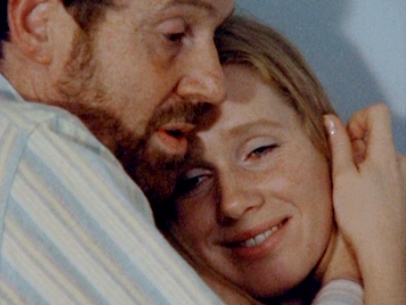 The film ends, by the way, on one of those Bergman-esque scenes of dreams and the interpretation of loneliness, with Marianne gasping for air after a bad dream (Oh no, she had stumps for hands!) and, boo hoo, not feeling that she’s ever been loved in her life. Dear God, the Bergman films of characters talking about their dreams were always grating, except for the erotic reverie recalled in “Persona.” That one sizzled the imagination.
The film ends, by the way, on one of those Bergman-esque scenes of dreams and the interpretation of loneliness, with Marianne gasping for air after a bad dream (Oh no, she had stumps for hands!) and, boo hoo, not feeling that she’s ever been loved in her life. Dear God, the Bergman films of characters talking about their dreams were always grating, except for the erotic reverie recalled in “Persona.” That one sizzled the imagination.
What does it all mean, though? Johan and Marianne needed to break apart from the mold of marriage, separate, and reunite to have a passionate love for each other all over again. Conventional confines of marriage was never going to make either of them happy, but informal sex-and-diatribe reunions seem to be what brings them happiness.
I wonder if the pretentious 18-year old I once was would have ate up this film. I am nearly twice as older, I have a carefree and charmed marriage, and have not had a single fight in my life that resembles one in “Scenes from a Marriage.” I think this is due to that neither me or my wife are anxious or high-strung, nor do either of us find enjoyment in watching angsty Swedish couples. I dunno, we seem to have an idea of how to make our own happiness. On the contrary, Bergman’s idea of marriage is man and wife digging their own separate infinite holes into terminal unhappiness.
Ebert, who I’ve cherished, called the theatrical film “One of the truest, most luminous love stories ever made,” but he hadn’t met his wife Chazz yet. If Ebert had found true love, he wouldn’t have seen this Bergman film as a love story but an all-out tragedy. Even as tragedy, “Scenes from a Marriage” fails for me. Grade: C-
168 Minutes. Rated R.
DRAMA / ADULT ORIENTATION / FRIDAY NIGHT BUMMER
Film Cousins: “La Notte” (1962, Italy); “Saraband” (2003, Sweden); “Revolutionary Road” (2008); “Before Midnight” (2013).
JACOB’S LADDER
“Ambivalence in human experience is no different than ambivalence in dying.” – writer Bruce Joel Rubin
Bizarre pull into the mind of someone who becomes disturbed by hallucinations. Jacob’s Ladder (1990) is a freaky psychological horror film that is visually one-of-a-kind, uncompromisingly an excursion into the metaphysical. Tim Robbins is a Vietnam Vet who has returned to civilian life as a postal carrier, previously divorced with one of his children fatally lost in an accident, now living with Hispanic hottie Elizabeth Pena for a girlfriend. Inexplicable events happen upon Jacob – trapped inside an underground subway, nearly run over by a car, body temperature shot up to 106 degrees Fahrenheit. Do some of these circumstances stem from after-effects of experimental drugs digested while on tour in Vietnam that has distorted his senses? Or are demons really after him? Director Adrian Lyne is justly famous for “Fatal Attraction” (1987), but “Jacob’s Ladder” with the motifs of whirring heads and faceless creatures, is his best film.
Lyne explores the thin line between life and death. His film looks at the everyday world and yet purports a mood that is just a little off from normal. The deliberate shambles and dilapidation of the production design is an effective choice. Perhaps David Fincher’s “Seven” (1995) also achieved the feeling of creating a somber cityscape that looks familiar, but isn’t particular of anywhere specific. That lack of everyday comfort provokes Jacob to go back and forth between memories of Vietnam and the present. He suddenly surmises a conspiracy theory that the government used experimental drugs on him and his platoon buddies when they were at war, further confirmed by a mysterious chemist (Matt Craven delivers a bravura monologue). But how much time has really passed since Vietnam and his present time as a postal carrier that this is just occurring to him now?
Jacob quickly loses trust in all his attachments. His girlfriend is more of a wish fulfillment than a logical mating selection, proper medical or psychiatric attention is elusive, his survivor friends from Vietnam equally paranoid. Scenes of “reality” carry with them a certain ambiguity. The film sticks with Jacob’s point of view, but that point of view too is unreliable. Jacob was functioning OK, but he arrives at the kind of condition where he might as well ask, “Am I dreaming?” Danny Aiello, as the trustworthy chiropractor Louis, is a little too perfect of a father figure and guru. Perfect in a way where you wonder if Louis is merely a conjecture.
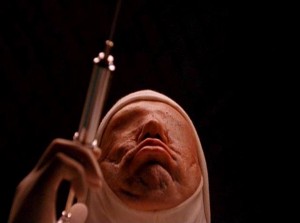 Remarkably, there are a number of chilling, nightmarish sequences. To choose a favorite scene could likely differentiate from another’s opinion. I would say the bathtub sequence with ice cubes piling on top of his freezing, panicked body, has always been unforgettable to me. The scene of Jacob on a gurney through a hellish hospital filled with crazies and littered with limbs on the floor has a potent darkness. One scene that doesn’t work, are government goons manhandling Jacob in the car, which was probably left in the film for story “continuity” purposes – I feel rigid continuity is not something the film needed, however. The “Ladder” monologue by that mysterious chemist is much more unnerving. And the ending, which challenges you to consider how far the mind can really go when it comes to our ability to displace ourselves, is ultimately thought-provoking and satisfying.
Remarkably, there are a number of chilling, nightmarish sequences. To choose a favorite scene could likely differentiate from another’s opinion. I would say the bathtub sequence with ice cubes piling on top of his freezing, panicked body, has always been unforgettable to me. The scene of Jacob on a gurney through a hellish hospital filled with crazies and littered with limbs on the floor has a potent darkness. One scene that doesn’t work, are government goons manhandling Jacob in the car, which was probably left in the film for story “continuity” purposes – I feel rigid continuity is not something the film needed, however. The “Ladder” monologue by that mysterious chemist is much more unnerving. And the ending, which challenges you to consider how far the mind can really go when it comes to our ability to displace ourselves, is ultimately thought-provoking and satisfying.
Bruce Joel Rubin is the screenwriter, who penned the mega-hit “Ghost” with Demi Moore and Patrick Swayze the same year as “Ladder.” Grade: A-
116 Minutes. Rated R.
PSYCHOLOGICAL HORROR / MIND-BENDER / SATURDAY NIGHT WEIRDNESS
Film Cousins: “Angel Heart” (1987); “Lost Highway” (1997); “The Jacket” (2005); “Shutter Island” (2010).
BODY DOUBLE
“In any movie, as soon as you see a girl, you’re waiting for her to take her clothes off. You’ll sit there and watch her forever for this to happen.” – director Brian DePalma
A thrilling violent mindbender that was ahead of its time. Brian DePalma’s Body Double (1984) is gleefully over the top as it traverses an everyman’s attempt to interfere with a woman in trouble. It takes a certain confidence for a director to cast someone as bland and wussy as Craig Wasson, an actor I can’t recall seeing in another film besides this one. Yet his very ineffectual qualities finally draws you in, and his hidden pluck even surprises you. DePalma’s film, a perverse mold of the Hitchcockian classics “Rear Window” and “Vertigo,” has Wasson’s struggling actor Jake Sully spy on a beautiful woman through her bedroom window, becomes aroused and captivated by her, and then finds himself following her because he believes she is a target of a hideously disfigured “Indian.” Much of the film progresses through pure cinema, which means the emphasis is not on dialogue but devout visual storytelling.
Wasson does not create a manly hero. He is introduced to us as to claustrophobic which disables him to perform as an actor on a movie set, he finds himself a cuckhold a few scenes later, bums his way into a housesitter gig, is portrayed as a shameless peeping tom,  and is generally an easy sucker to other’s schemes. Deborah Shelton nevertheless appears to be a great beauty and camera subject through that bedroom window, who is equally alluring when the hero bumps into her, and is of course, vulnerable enough to need a hero to rescue her. Besides retrieving her stolen purse, however, Wasson is not a very dependable hero.
and is generally an easy sucker to other’s schemes. Deborah Shelton nevertheless appears to be a great beauty and camera subject through that bedroom window, who is equally alluring when the hero bumps into her, and is of course, vulnerable enough to need a hero to rescue her. Besides retrieving her stolen purse, however, Wasson is not a very dependable hero.
Throughout the years, DePalma has joyfully indulged in R-rated eroticism. The striptease is erotic, and DePalma doesn’t edit too much, but lets the camera gaze upon the girl. Wasson has tunnel vision, he is obsessively into the woman in trouble, a ghastly act of violence takes place, and then his attention turns to somebody else. Melanie Griffith enters late into the picture as Holly Body, a porn star of such titles as “Holly Does Hollywood,” and coincidentally, dances the same way that Shelton danced her striptease. What is the connection, Wasson wonders. Wasson gets a job on the set of one of Holly’s movies, and undergoes a personality change after he slicks back his hair and poses as an “adult film producer.” But ultimately, “Body Double” is the plunge into the psyche of not a very cool guy. That takes some balls by a filmmaker to do that.
There are reasons I believe as to why DePalma’s film has been forgotten over the years. Graphic nudity, one gnarly and gratuitous act of violence, the world of adult films, the general untraditional narrative, and various weird and unlikely transgressions, keep it from airing on television or cable. Despite some rave reviews, those ingredients gave it a bad rap in its initial theatrical run. Critics were ready to gun DePalma a year after the ultra-violent “Scarface” was found to be very tasteless at the time. I think “Body Double” would have been more easily swallowed had it come after the critical raves of something like David Lynch’s 1986 film “Blue Velvet.”
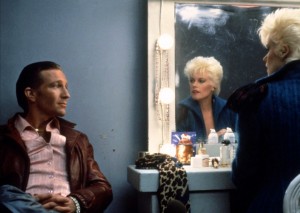 Exquisite and fluid camerawork is simply not appreciated enough, not unless you are a bona fide film buff. DePalma has been a visual virtuoso throughout his entire career, I can’t name a film in which he plays it safe. Viscerally, “Body Double” is a provocation that will disturb or trouble you, which are the kind of emotions ordinary movie watchers are turned off by. The more serious film buffs should be intrigued that a film attempts such things. Here is a suspense-mystery that is puzzling and weird, as well as sometimes tasteless. If you can believe it, DePalma was nominated for a Razzie award for Worst Director for it. I happen to think it’s one of his best films. Today, hipper filmgoers get it.
Exquisite and fluid camerawork is simply not appreciated enough, not unless you are a bona fide film buff. DePalma has been a visual virtuoso throughout his entire career, I can’t name a film in which he plays it safe. Viscerally, “Body Double” is a provocation that will disturb or trouble you, which are the kind of emotions ordinary movie watchers are turned off by. The more serious film buffs should be intrigued that a film attempts such things. Here is a suspense-mystery that is puzzling and weird, as well as sometimes tasteless. If you can believe it, DePalma was nominated for a Razzie award for Worst Director for it. I happen to think it’s one of his best films. Today, hipper filmgoers get it.
Lastly, I want to mention the song “Relax” by Frankie Goes to Hollywood is a weird but irresistible musical number (taking place on the porno set) that is quintessential DePalma humor. The song actually was overlooked at first until it became famous because of the movie. Grade: A-
114 Minutes. Rated R.
ADULT THRILLER / MIND-BENDER / LATE NIGHT WEIRDNESS
Film Cousins: “Rear Window” (1954); “Vertigo” (1958); “Dressed to Kill” (1980); “Blow Out” (1981).
THE REMAINS OF THE DAY
“Why Mr. Stevens? Why must you always hide what you feel?” – Ms. Kenton
The only Merchant Ivory production worth immortalizing. The Remains of the Day (1993) features Anthony Hopkins in the portrait of a butler who during his entire existence places care for his British master before his own life. Edward Fox is Lord Darlington, a stuffed shirt aristocrat, who is also a Nazi sympathizer pre-World War II. Emma Thompson is the head housekeeper Ms. Kenton whom he shares a fondness. She still believes in love, is anti-Nazi, but doesn’t leave the manor of Darlington Hall because she has no family and nowhere else to go. But she still has pride in her job, which to him matters admirably.
Mr. Stephens puts so much over-emphasis on serving Lord Darlington that duty takes priority over his father’s illness. Mr. Stephens also abides his master’s orders without challenging them. When two housemaids are found to be Jewish, they are ordered to be dismissed, which lead to certain life demise for the two young women. Some will find it difficult to go along with a film whose protagonist has no backbone. But he is so proper, though, with such dedication to precision and formality!
 What are the regrets of the older Mr. Stephens, you ask? The film uses a flashback structure, a tad unwieldy structure honestly, of Mr. Stephens travelling across England in 1958 to reacquaint himself with friend and comrade Ms. Kenton, who had a demure crush on his truly. He is asked by fellow Brits about how it felt to serve a Nazi sympathizer. Politics were never his forte, he confesses. But certainly he has a blithe opinion.
What are the regrets of the older Mr. Stephens, you ask? The film uses a flashback structure, a tad unwieldy structure honestly, of Mr. Stephens travelling across England in 1958 to reacquaint himself with friend and comrade Ms. Kenton, who had a demure crush on his truly. He is asked by fellow Brits about how it felt to serve a Nazi sympathizer. Politics were never his forte, he confesses. But certainly he has a blithe opinion.
And how about Ms. Kenton? Only a friendship was established between them, one muses, and yet there were the most subtle hints of longing. I think the film in retrospect is a portrait of a man terrified of sexual contact. Ms. Kenton would have been the one woman in the world who could have filled the void of providing some sort of contact. Mr. Stephens though has only ever been comfortable with mastering his occupational duties. The idea of a man afraid his entire lifetime of touching or feeling is incredibly sad.
When it is at its best, “Remains” is mesmerizing. I say this with a special nod to Richard Robbins’ music score which is always expressing chords of melancholy and evocations of lost connections. Kazuo Ishiguro, the author of the source novel, is of course equally responsible for such themes and moods.
 Christopher Reeve plays the American Mr. Lewis, who gallantly takes over Darlington Hall. Hopkins shares his final scene with Reeve, as he puts over-emoting concern to remove a trespassing pigeon from the manor. That’s the metaphor: the pigeon has more importance than his own life, at least that’s how he regards himself. Rigid and proper, with most emotions removed to uphold proper British “dignity,” makes Hopkins’ Mr. Stephens character a fascinating vexed character. To me, this was the best performance of Hopkins’ career with “The Silence of the Lambs” (1991), the exception.
Christopher Reeve plays the American Mr. Lewis, who gallantly takes over Darlington Hall. Hopkins shares his final scene with Reeve, as he puts over-emoting concern to remove a trespassing pigeon from the manor. That’s the metaphor: the pigeon has more importance than his own life, at least that’s how he regards himself. Rigid and proper, with most emotions removed to uphold proper British “dignity,” makes Hopkins’ Mr. Stephens character a fascinating vexed character. To me, this was the best performance of Hopkins’ career with “The Silence of the Lambs” (1991), the exception.
This is the only Ismail Merchant & James Ivory film that I outright love. “Remains” has appeal to big thinkers out there and is to be studied, admired and haunted by. I do prefer “A Room with a View” (1986) over “Howards End” (1992) however, if I had to choose another Merchant & Ivory film to recommend. Grade: A
138 Minutes. Rated PG.
HISTORICAL DRAMA / FOOD FOR THOUGHT / FALL MOVIE
Film Cousins: “The Garden of the Finzi Continis” (1970, Italy); “The Age of Innocence” (1993); “Atonement” (2007); “The King’s Speech” (2010).
INTERIORS
“I have nothing to live for anymore.” – Mom on her birthday
The first dead-serious Woody Allen film. Interiors (1978), influenced by the works of cerebral dramatist Ingmar Bergman, is the portrait of a family stunted in pretentiousness and over-intellectual mire. The central tragic figure is the mother Eve (Geraldine Page) who has spent a lifetime being a fastidious and meticulous homemaker. There is much refinement and yet lifelessness and sterility in the rooms she decorates. This has bored and alienated her husband Arthur (E.G. Marshall) who has asked for a trial separation. She is equally a burden to her three daughters . She loves her husband who has scorned her, and her alienated daughters, but she does not know how to love conventionally. She tries too hard fixing her childrens’ home designs and not enough time talking to them about their dreams and desires.
“Interiors” has many brilliant scenes of family dysfunction, acknowledging how WASPS can be more attuned to looks and presentation of materials than to human connection and keen sensitivity. But I no longer feel quite as strong about “Interiors” as I once did. The Diane Keaton and Richard Jordan marriage is overwrought, and Allen’s blocking of these two is quite maladroit. Angry and dissatisfied Swedish intellectuals unnaturally pacing back and forth, they seem, and less than true-blood Americans.
Mary Beth Hurt as the depressed and priggish daughter is the more interesting daughter, and she has an intelligent husband (Sam Waterston) who offers her advice on what to do for a living. Nothing makes her happy, though, as she searches for fault in her father, her mother, and her siblings, as well as mope about her own directionless life.
The third daughter is played by a narcissistic, coke-snorting Kristin Griffith who is an underwritten cliché. Her biggest act of abnormal behavior – in a film about uppity and abnormal behavior – is teasing one of her sister’s husbands into a seduction.
 We are foremost drawn, and devastated, by Page’s performance as the mother who only asks for “reconciliation.” This is a powerful performance of a woman whose own sense of perfection decomposes following her husband’s desertion of her. While she is a woman of high anxiety and incapable of normal calm and ease amongst loved ones, we still care for her as a human being who craves attachment to family.
We are foremost drawn, and devastated, by Page’s performance as the mother who only asks for “reconciliation.” This is a powerful performance of a woman whose own sense of perfection decomposes following her husband’s desertion of her. While she is a woman of high anxiety and incapable of normal calm and ease amongst loved ones, we still care for her as a human being who craves attachment to family.
Arthur says the separation is not irrevocable, but he certainly doesn’t hesitate to finalize the divorce when he meets a woman on a cruise ship (Maureen Stapleton). This isn’t a young tart he is in love with. Simply an older woman with vivacity and an unabashed embrace of life. With this blow, Eve’s purpose as a wife and mother has expired. In her mind.
“Interiors” is a hard sit, and is one of those more interesting to think about after it’s over than it is entertaining to watch. I will not return to it again for another twenty years, I don’t think, but I am certainly glad it exists because it was the first showcase of cerebral depth and dark drama for Woody Allen. In contrast, his current “Blue Jasmine,” I am sure now, is more humanly well-rounded and genuine, and therefore more impactful drama with this hindsight. Grade: A-
91 Minutes. Rated PG.
DARK DRAMA / EAST COAST TEENS / CEREBRAL WEEKEND VIEWING
Film Cousins: “The Passion of Anna” (1969, Sweden); “Cries and Whispers” (1973, Sweden); “A Separation” (2011, Iran); “Blue Jasmine” (2013).
THE MAN WHO FELL TO EARTH
“We’d have probably done the same to you, if you’d come ’round our place.” – Thomas Newton
If you want a film as different as can be, one that is a sci-fi allegory that challenges, then here’s one you likely haven’t heard of. The Man Who Fell to Earth (1976) is a strange one, often visually unique, teeming with symbolism that represents something meaningful. Rock star David Bowie made his film debut as an alien from another drought-plagued planet who came to Earth with a mission to ship water to his dying planet. The film’s director is Nicolas Roeg (“Walkabout,” “Don’t Look Now”), one of the most overlooked visionaries of the cinema. You don’t just see a narrative unfold with his films, you digest an entirely idiosyncratic mood with his work.
In summary, it has a similar outline to “E.T.” – an extra-terrestrial comes to Earth to explore, construct a purpose, and return home. Yet the film was somehow an allegory about the debilitations of alcoholism. The alien assumes the name Thomas Newton as he pursues his quest, gets sidetracked with booze and junk television (he views multiple T.V. boxes at once), becomes dependent on an earth woman – during this course abandons all idealism and forsakes his family back on his home planet.
The 1963 Walter Tevis novel doesn’t extrapolate as many themes as the movie. The book had an even interest with alcoholism and fear of nuclear war – a “paranoia” social concern that was long past dated in 1976. The Tevis novel is a spry, brainy-humor read, that wryly satirizes how an alien succumbs to human-like malaise. But the film accomplishes the same themes and more.
 Newton is a genius. He hires a lawyer (Buck Henry as Oliver Farnsworth) who specializes in patents to seal nine new inventions that will advance electronics throughout the world. Not all of Newton’s inventions are revealed to us, but some of them have to do with revolutionary electronics. Newton will surpass competitor corporations, says the lawyer. “Mr. Newton, you can take RCA, Eastman Kodak and DuPont, for starters.” In a few short years, he will become worth an estimated $300 million. Newton needs more, he explains, to build a space vehicle that can outdo NASA. The implied purpose is to carry water back home.
Newton is a genius. He hires a lawyer (Buck Henry as Oliver Farnsworth) who specializes in patents to seal nine new inventions that will advance electronics throughout the world. Not all of Newton’s inventions are revealed to us, but some of them have to do with revolutionary electronics. Newton will surpass competitor corporations, says the lawyer. “Mr. Newton, you can take RCA, Eastman Kodak and DuPont, for starters.” In a few short years, he will become worth an estimated $300 million. Newton needs more, he explains, to build a space vehicle that can outdo NASA. The implied purpose is to carry water back home.
Newton stays out of the public limelight and lets Farnsworth run his multi-million dollar corporation. While on holiday in New Mexico, he meets Mary Lou (Candy Clark), a sweet girl but a total birdbrain. She introduces Newton to the basics of American life: Church, sex, television – and alcohol – which will stymie his productivity. Mary Lou, once a hotel maid, is now Newton’s romantic companion who lives with him in his reclusive house where they eventually do next to nothing together. She is undemanding, however, which must fit Newton’s requirements for a low-maintenance relationship.
Unconventionally, the film goes on tangents with supporting characters. We Farnsworth and his closeted relationship with a gay partner, a government “fixer” (Bernie Casey, as a social climber black man), and a college professor (Rip Torn as Nathan Bryce) who has graphic sexual interludes with his students. Bryce is most fascinating, preoccupied with sex addiction – a radical story theme for 1976 – who lands a job working for Newton, and overcomes his sexual conquests because he has found an occupational interest that drives him. This element was not in the book. Newton and Bryce: one addicted to alcohol, the other to sex.
Bryce is the first to suspect Newton has extra-terrestrial origins. But the government becomes suspicious, as well, for they recognize Newton is too advanced for earthly contemporaries. None of this is spelled out overtly, but is implied and ambiguous.
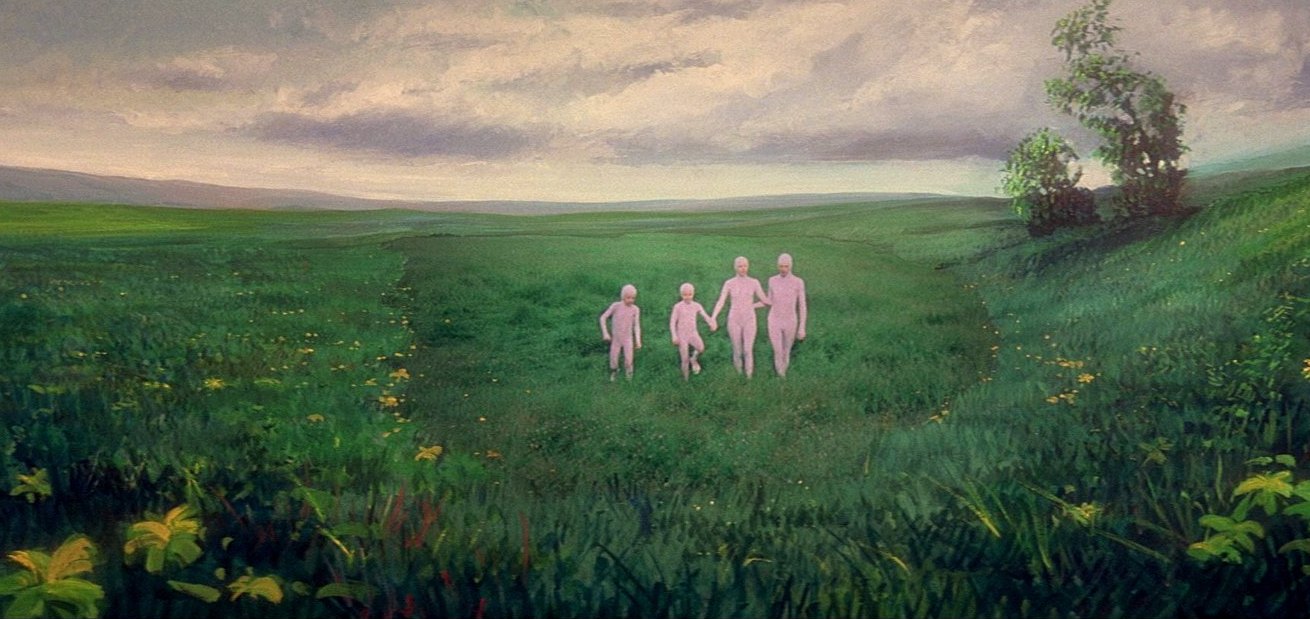 The film is more of a character study, anyway, emphasizing loneliness and displacement. The visuals get more trippy as Newton’s alcoholism progresses, and the baroque imagery suggests that Newton has psychic visions. We see the alien rituals (sex and mating perhaps?) back on his planet. The arid desert where his family dwells that suggests a simpler way of living than Earth. There are also shots of Newton in a trance where he somehow sees alien visits to Earth from a hundred years ago. I’ve seen this Roeg film three or four times over the years, and I recall that I found it bizarre and perplexing in my first viewing, but it’s all the more clear and delineated after seeing it in multiple viewings.
The film is more of a character study, anyway, emphasizing loneliness and displacement. The visuals get more trippy as Newton’s alcoholism progresses, and the baroque imagery suggests that Newton has psychic visions. We see the alien rituals (sex and mating perhaps?) back on his planet. The arid desert where his family dwells that suggests a simpler way of living than Earth. There are also shots of Newton in a trance where he somehow sees alien visits to Earth from a hundred years ago. I’ve seen this Roeg film three or four times over the years, and I recall that I found it bizarre and perplexing in my first viewing, but it’s all the more clear and delineated after seeing it in multiple viewings.
There are startling sequences that speak more of evolving cultural changes than plot, sometimes without Newton. Consider in 1976 how audacious it was to see a naked black man passionately kissing a naked white woman. Roeg makes this sequence lyrical and fervently alive, it is certainly a watershed moment in cinema.
We do get a big space shuttle launch sequence, done in a more quasi-documentary style, interspersing developments and new plot twists. But more intriguing are the scenes of Newton prodded by scientists. He is so numbed by alcohol that he can’t find the strength to defend himself in one scene, for the scientists don’t understand Newton’s dissimilar genetic makeup. This is as sad a moment as there is in film, and demonstrates how he has been broken by booze.
 The entire film doesn’t work. There are some admittedly annoying passages, particularly one where Newton plays with a gun. This scene might say something about how this alien’s gentle façade has now transgressed, but goes over-the-top. His relationship with Mary Lou descends into the pathetic quality of indifference, but Mary Lou doesn’t get much wiser by the end. Perhaps she represents American complacency.
The entire film doesn’t work. There are some admittedly annoying passages, particularly one where Newton plays with a gun. This scene might say something about how this alien’s gentle façade has now transgressed, but goes over-the-top. His relationship with Mary Lou descends into the pathetic quality of indifference, but Mary Lou doesn’t get much wiser by the end. Perhaps she represents American complacency.
But how singular this film is. Roeg takes boundless risks, sometimes goes too far, and one might complain he attempts too much. “The Man Who Fell to Earth” was radical for its time, and too radical for our times now. It would never get made today. If its originality is entrancing for you, it will likely be equally thought-provoking for you for a very long time. Grade: A
139 Minutes. Rated R.
SCI-FI & FANTASY / CEREBRAL / WEEKEND TRANCE-OUT
Film Cousins: “2001: A Space Odyssey” (1968); “Starman” (1984); “The Brother From Another Planet” (1984); “Cocoon” (1985).
WHAT DREAMS MAY COME
“I think it was the most important book I’ve written. It has caused a number of readers to lose their fear of death – the finest tribute any writer could receive.” – author Richard Matheson
This film has been adored more by educated non-movie people than it has been with critics.What Dreams May Come (1998) is a visually astonishing creation of Earth, Heaven and Hell by overlooked filmmaker Vincent Ward (“Map of the Human Heart”). By creating a paint-bucket heaven that smudges, smears, and puddles, the film won the Oscar for Best Visual Effects. Equally amazing are its trenches of hell, like two of Ingmar Bergman’s 1968 films “Shame” or “Hour of the Wolf” but with… expensive special effects.
Why did I look back at “Dreams” this week? I did because it is based on the novel by Richard Matheson who passed away this week at the age of 87 years old. He founded a number of sci-fi/fantasy projects that were new, original creations and trendsetters. His most popular work “I Am Legend” was made into three different adaptations, one starring Will Smith. At its time of publication, it was among the first of the zombie stories, popularizing the genre.
“Dreams” is on a deeper level. It covers a lot of ground in just 12-minutes, hitting high and low notes. First-meet, love, marriage, children – then untimely death (later flashbacks retrace their lives). It’s also a film that believes in reincarnation and past lives. After having already lost their two children, Robin Williams, the father Chris Nielsen, dies while being a good Samaritan. The wife Annie (Annabella Sciorra) is so stricken with depression that she cannot bear to go on. Suicides, however, go straight to Hell. Chris, in Heaven, must make his passage to Hell to bring his wife out of eternal damnation. Losing his mind, and succumbing to the pangs of Hell is a risk he will have to take, the angels tell him.
Ward and Matheson are sharing a cinematic vision. I believe they have the idea, or fancy, that in Heaven, people can be whomever they want to be – that it grows out of an individual’s imagination. “Hell is for who don’t know they’re dead,” observes Albert (Cuba Gooding Jr.). The Tracker (Max von Sydow), the scribe who can direct Chris in his journey, tells Chris that he will likely not make it.
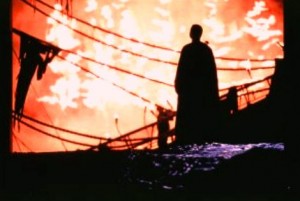 Of course, it is an inspirational fable about bravery and true love. A man loves a wife, and refuses to give up on her — risking his soul to eternal damnation to save hers before she is lost in an eternal void. There’s something a little dopey about his refusal to give up, but “Dreams” has been made with great passion and sincerity. The novel is known for its scientific approach while the movie is cinematically vivid and emotional. The dialogue is occasionally sappy, albeit life-embracing. To counteract that, there is homage to Faust, and most particularly to Dante’s Inferno: “For in that sleep what dreams may come… When we have shuffled off this mortal coil… Must give us pause.”
Of course, it is an inspirational fable about bravery and true love. A man loves a wife, and refuses to give up on her — risking his soul to eternal damnation to save hers before she is lost in an eternal void. There’s something a little dopey about his refusal to give up, but “Dreams” has been made with great passion and sincerity. The novel is known for its scientific approach while the movie is cinematically vivid and emotional. The dialogue is occasionally sappy, albeit life-embracing. To counteract that, there is homage to Faust, and most particularly to Dante’s Inferno: “For in that sleep what dreams may come… When we have shuffled off this mortal coil… Must give us pause.”
Why didn’t critics at large embrace this film? Perhaps because most critics feel sappinessdoesn’t belong in the movies, nor anywhere in real life. To me, that’s anti-spiritual and close-mindedness. Grade: A-
113 Minutes. Rated PG-13.
SPIRITUAL DRAMA / INSPIRATIONAL / WEEKEND TRANCE-OUT
Film Cousins: “Somewhere in Time” (1980); “Made in Heaven” (1987); “Map of the Human Heart” (1993, New Zealand); “After Life” (1998, Japan).
DAWN OF THE DEAD
“When there’s no more room in Hell the dead will walk the Earth.”
Spontaneously scary blood and guts, visually ravenous, and a sly commentary on our consumerist programming embedded in our human nature. Dawn of the Dead (1979) is the gory classic you must see at some point if you’ve bothered at all sorting through the zombie genre. It begins at a hysterical TV station on the heels of perhaps a final broadcast. The zombie phenomenon has taken over the country, but it isn’t quite all omnipresent… yet. TV technician (Gaylen Ross), her helicopter boyfriend (David Emge), and some guys from S.W.A.T. (Scott Reiniger and Ken Foree), aerially travel and land at atop a shopping mall. Why there? Because a mall has everything you need to live off.
Some zombies stagger about, but they’re easy for S.W.A.T. to pick off. “Why do they come here?” The answer: “Kind of instinct. Memory. What they used to do. This was an important place in their lives.” You should laugh when you hear this deadpan line. The heroes as well get too dependent on the shopping mall resort and never want to leave. A motorcycle gang (led by Tom Savini, who was the film’s makeup artist) wants some of the spoils too and desires to break into their safe haven.
Depraved humor includes amputations and torn veins, the zombies munching on lost limbs. The humor is also mocking, for I look at some of the undead who were unfortunate to die in the clothes they last had on themselves (take a look at the one Hare Krishna). These stumbling zombies are too slow to be an immediate threat against tactical firepower. But when the zombies attack in hordes, only so much ammunition can hold them off. I hope I don’t spoil it by saying there is a survivor at the end who options suicide at the prospect of losing the mall. Without the mall, what else is there!
 Most of the acclaim director George A. Romero received in his career was for his first film “Night of the Living Dead” (1968), which employed black & white cinematography to achieve a spooky, heightened claustrophobic feel – but frankly its’ ideas are limited. Romero cranked out a few other horror thrillers after it, nothing memorable, until he returned to zombies. “Dawn of the Dead” is the best of his [six] zombie movies, and a precedent for the countless spawns that came after. It’s his most socially metaphorical zombie picture, and the most entertaining. At the time it was considered the bloodiest movie ever made (no one under 17 admitted at the time). Today, it simply stands as the best of the zombie genre.
Most of the acclaim director George A. Romero received in his career was for his first film “Night of the Living Dead” (1968), which employed black & white cinematography to achieve a spooky, heightened claustrophobic feel – but frankly its’ ideas are limited. Romero cranked out a few other horror thrillers after it, nothing memorable, until he returned to zombies. “Dawn of the Dead” is the best of his [six] zombie movies, and a precedent for the countless spawns that came after. It’s his most socially metaphorical zombie picture, and the most entertaining. At the time it was considered the bloodiest movie ever made (no one under 17 admitted at the time). Today, it simply stands as the best of the zombie genre.
The 2004 Zack Snyder remake was a stampede of thrills, but lacked any social paradoxes and subtle ironies. Recommended, but make time for Romero first. Romero’s “Dead” played at the 1978 Cannes Film Festival with a 139-minute cut. A European version with more gore but excised scenes is 118-minutes. The official preferred director’s version and 1979 U.S. theatrical cut is 127-minutes. Seek out and own The Anchor Bay company “Ultimate Edition” which features all edited versions. Grade: A-
Director’s Cut: 127 Minutes. Rated R.
THRILLER / CREATURE FEATURE / SATURDAY NIGHT GOOSEBUMPS
Film Cousins: “Night of the Living Dead” (1968); “Zombie” (1979); “Day of the Dead” (1985); “Dawn of the Dead” (2004).
SUPERMAN
What makes it special is the mythical and mystical oomph. Superman (1978) is a visually astounding odyssey of planet Krypton, Earth and the galaxies in-between. Outer space looks gaseous in a fantastic way, thankfully not the appearance of a CGI painting, as the son of Jor-El travels light years in a meteor-shaped spacecraft that crashes to Earth. The superbaby is adopted and named Clark Kent by two elder guardians, will grow up in Smallville, and eventually exercises superhuman powers on Earth. The shorthand motto: Truth, justice and the American way.
I was amazed all over again by the exotic colors of planet Krypton, the stars and interstellar clouds, the airborne excitement of Superman whooshing to the rescue, the heartland of America and the Big Apple they call Metropolis. This was a phenomenal directing job by Richard Donner who would be fired (!) during the making of “Superman II” due to – typical – creative differences with producers Alexander & Ilya Salkind. Donner basically wanted things “serious” and “mythical” while the power players wanted more campy humor.
“Superman” is, in tact, a Donner film. Besides, Christopher Reeve had a bigger smile than immortality itself. So you already felt a certain kind of light-hearted, valorous buoyancy with him. That busybody Margot Kidder always made for a decent Lois Lane, and better in retrospect, after we witnessed Kate Bosworth ruin everything in the failed reboot “Superman Returns” (2006). Gene Hackman was gum-smacking as arch villain Lex Luthor, so perfect for that part that Kevin Spacey just mimicked Hackman during the same “Superman Returns” fiasco as well. Valerie Perrine does fine as the dumb sex kitten and girlfriend of Luthor, and Ned Beatty was a bumbling henchman.
What stirs the kid in you, more than anything, was the swooning and trombone-heavy music by John Williams, who cornered the market on great adventure movie scores for the following two decades. The ads promised, “You’ll believe a man can fly.” But it is your head flying high when Williams music soars. There is one or two too many scenes of Superman saving the people on his first night out, and it would have succumbed to hokiness hadn’t Williams music embraced the heroism and transcended it. The one clunker: Lois and Clark held up by a thieving gunman in a plaid jacket, something I could have lived without.
 Yes, I almost got a little tired of Superman stopping a bank robber by scaling a building, then thwarting a gang of bandits, then saving a jet whose engine gets blown out by weather. After such an epic exposition of how Superman came to be, not a lot of narrative time passes by in the second half. Superman becomes a tabloid sensation, he takes an interview with Lois Lane which ends on a romantic flight (Kidder never looked better than in that silk blue negligee-as-dress), and then he must stop Luthor from blowing up New Jersey and California from nuclear warheads. New Jersey is a decoy, with the San Andreas fault in California as the main target. If an explosion causes a ripple of earthquakes, the entire state will sink in the Pacific. This leads way to a series of walloping, exciting special effects achieved by back projection and moving matte shots. These are the kind of classic effects that you can’t artificially put together on a MacBook. It has been attained by real photography.
Yes, I almost got a little tired of Superman stopping a bank robber by scaling a building, then thwarting a gang of bandits, then saving a jet whose engine gets blown out by weather. After such an epic exposition of how Superman came to be, not a lot of narrative time passes by in the second half. Superman becomes a tabloid sensation, he takes an interview with Lois Lane which ends on a romantic flight (Kidder never looked better than in that silk blue negligee-as-dress), and then he must stop Luthor from blowing up New Jersey and California from nuclear warheads. New Jersey is a decoy, with the San Andreas fault in California as the main target. If an explosion causes a ripple of earthquakes, the entire state will sink in the Pacific. This leads way to a series of walloping, exciting special effects achieved by back projection and moving matte shots. These are the kind of classic effects that you can’t artificially put together on a MacBook. It has been attained by real photography.
“Superman” was altogether the first extravagant, expensive production for a Comic Book movie, and it remains glorious and awesome. Think fast: Name a comic book movie before it that had scale, that was good, that mattered. A very flimsy, campy 1966 Batman movie is all I could think of, off-hand. Honesty and virtue were qualities of Reeve, and of Superman as well. We will continue to get our “edgy” and jaded superheroes (too many of them), but we will always have our one sincere, honorable and genuine superhero: the 1978 Superman. Grade: A
143 Minutes. Rated PG.
ACTION & ADVENTURE / SUPERHERO / WEEKEND BLASTOFF
Film Cousins: “Superman II” (1980); “Superman III” (1983); “Superman IV: The Quest for Peace” (1987); “Superman Returns” (2006).
IRON MAN
”I came to realize that I had more to offer this world than just making things blow up.” – Tony Stark
A blast in the booty. Iron Man (2008) remains an ecstatic joy to see Robert Downey Jr. let it rip. Downey is the quintessential billionaire Tony Stark, the man inside Iron Man. Film after film, Downey retains his indie edge with his cocky and flippant personality without flipping the finger, either. He contributed that edge to the comic book blockbuster, and the genre itself found new standards because of him. We want a brilliant verbal dynamo as a hero, now we demand actors the quality of Downey to be a part of the tentpole blockbusters.
Born rich, Stark is a weapons magnate as passed down from his father. His business tour in Afghanistan goes awry, he nearly dies in captivity, but invents the suit – and the electromagnetic pulse – that lets him survive, and come alive as Iron Man. His M.O. with the weapons industry changes remarkably as a result. I realized that the recent “Iron Man 3” doesn’t have substance that equals the dramatic discoveries of this original. But what makes the plot gel is how Downey’s thoughtful motormouth considers the plot around him. Will his own weapons company lead to his own demise?
Running second in the joy department are those whooshing airborne scenes. You get the sense that Iron Man is travelling 100 mph with flying in the air, maybe it is 500 mph. Whatever the speed, Iron Man has the velocity of a missile. We have to look back at the old “Superman” movies to get the same airborne rush. The filmmakers should create an entire credit sequence of Iron Man flying across the planet in a future sequel installment. My wish.
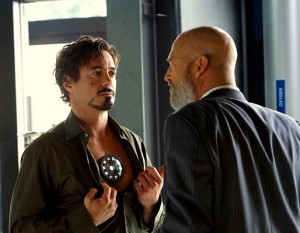 The secondary performances thankfully are pleasurable. Gwenyth Paltrow lends the film blush as Pepper Potts, possessing the classiness of the 1950’s with a 2010 academic brain. Jeff Bridges is Stark’s business partner Obadiah Stane, a smarmy bald guy with greed in his veins. Stane has spent a lifetime watching the stock ticker, and he won’t let Stark mess with their company shareholder value.
The secondary performances thankfully are pleasurable. Gwenyth Paltrow lends the film blush as Pepper Potts, possessing the classiness of the 1950’s with a 2010 academic brain. Jeff Bridges is Stark’s business partner Obadiah Stane, a smarmy bald guy with greed in his veins. Stane has spent a lifetime watching the stock ticker, and he won’t let Stark mess with their company shareholder value.
Not enough was made of Iron Man partner Rhodey a.k.a. War Machine (Terrence Howard), a minor clash of egos between them occurs but not much else. None of the “Iron Man” films really did, even with Don Cheadle as replacement.
Regardless, Jon Favreau (“Elf”) demonstrated himself (this time only) as a fantastic action director who expertly paced his actors through some skin-searing, death-defying motions. Favreau actually gives a damn or two about human vulnerability beneath all the explosive chaos, that’s what counts. We care more about the Quintessential Billionaire than we do about the superhero armor, don’t we? Grade: A-
126 Minutes. Rated PG-13.
ACTION & ADVENTURE / SUPERHERO / MINDLESS WEEKEND EXCITEMENT
Film Cousins: “The Incredible Hulk” (2008); “Iron Man 2” (2010); “The Avengers” (2012); “Iron Man 3” (2013).
THE DEEP END
“It’s $50,000. It is not the kind of thing that everyone can just go out and get.” – Margaret Hall
If you need a great movie about blackmail, this is it. The Deep End (2001) opens with a seedy nightclub scene in Reno (Mom attempts to bribe a man with the promise to stop seeing her son) and then settles into the unassuming everyday family life of waterfront Lake Tahoe. The mercurial Tilda Swinton (“Michael Clayton”) gives a Meryl Streep performance as the protective mother whose husband is away on Naval command. I say that because I think this film is a prime example of why Swinton is as great an actress as Streep. Here she plays a mom who covers up a killing that her son might have accidentally committed. Somehow we observe a dozen complex emotions and facial expressions at once by a virtuoso actress who is multi-faceted in every way.
Anybody who has ever been to Tahoe knows the community is circular around the lake. The road leads two ways, that’s definite. The police find the body of the night club owner Darby (Josh Lucas), and there’s mom driving by the scene marked by police tape. Hours later, she gets a visitor named Alek Spera (Goran Visnjic) at her door who demands $50,000 or he will go the police with a sex tape featuring Darby and Margaret’s son. Yes, the tape of homosexual fornication is a tad too graphic which may be the reason why “The Deep End” doesn’t get played on basic cable. You will have to seek it out on Netflix or a video store.
Swinton plays the blackmail scene with outrage, collected temper and concern for her son – she will do anything to get him out of trouble and to not embarrass him about his sexual preferences. He is 17 years old with a bright college future, equating to, Margaret will take the blame if she has to. Or she can pay and the problem will supposedly go away. Cashing out on loans and pawn shops doesn’t bring Margaret enough bounty, though, so what do you do when you can only come up with half the money?
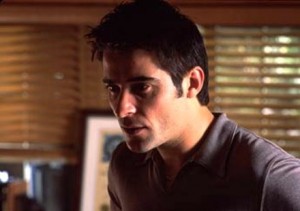 This was the second film by the directing team of Scott McGehee and David Siegel. Their tremendously effective new film “What Maise Knew” is their fifth film after nearly twenty years in the biz. They know concise camerawork, how to utilize natural settings to make it specific, and how to edit for effective tension. “The Deep End” has purpose and engagement scene after scene, familiarizing us with Tahoe (so if you’ve never been, you still get a thorough portrait locked in your mind), and then what rips our hearts as viewers is witnessing the deepening chasm of mistakes by Margaret that festers more trouble as well as altering the terms of blackmail.
This was the second film by the directing team of Scott McGehee and David Siegel. Their tremendously effective new film “What Maise Knew” is their fifth film after nearly twenty years in the biz. They know concise camerawork, how to utilize natural settings to make it specific, and how to edit for effective tension. “The Deep End” has purpose and engagement scene after scene, familiarizing us with Tahoe (so if you’ve never been, you still get a thorough portrait locked in your mind), and then what rips our hearts as viewers is witnessing the deepening chasm of mistakes by Margaret that festers more trouble as well as altering the terms of blackmail.
There is a terrific moment outside genre predictability when Margaret has a domestic problem, and Alex, who was there to do a shakedown routine on her, gets involved conducting CPR on a sick family member. This inexorably pulls down his façade as a tough mobster and it turns him into an understanding human being. The problem is that Alex’s associate Nagel (Raymond Barry) is less than sympathetic. The subterfuge must go on, money is money and it is heartless. A
99 Minutes. Rated R.
TWISTED DRAMA / THINKING MAN’S THRILLER / AFTER HOURS VIEWING
Film Cousins: “Blood Simple” (1985); “After Dark My Sweet” (1990); “Notes on a Scandal” (2006); “Mother” (2009, South Korea).
ZARDOZ
“Zardoz your god gave you the gift of gun. The gun is good. The penis is evil. The penis shoots seeds and makes new life to poison the Earth with the plague of men.” – God Zardoz
Set in the Year 2293
A landmark in flamboyantly awful sci-fi movies. Zardoz (1974) has Sean Connery running around in a loincloth in the debauched future of 2293, categorized as a Brutal. Having smuggled aboard the floating stone head that is the God Zardoz and defeated its Eternal ruler Arthur Frayn (Niall Buggy), the Brutal lands the flying aircraft that is the stone head into the Vortex (it’s an invisible dome city) which the privileged Eternals occupy. The Eternals are made up of a bunch of impotent men and flat-chested women, who have become bored with their monotonous existence. Connery, as prisoner Zed, is a welcome change-of-pace but is to be disposed of after they are done studying him. Some of them want him dead, but some of the other bored people realize Zed is their salvation, and reckon he is the only one that can change them into Mortals. Eternal life sucks, you know.
This description is conventional review writing, believe it or not. The key message I want to tell you is that this is among the most out-there, impossibly WEIRD movies ever made (How?? How?? Who let this happen??). Every now and then, I have found descriptions in film books that it was supposed to be a futuristic “Spartacus” but I’ve never been able to find the connection. I can’t find any coherent connections to anything, really. It’s some kind of fable of a virile adventurer overthrowing a totalitarian society that has grown ineffectual, I guess. To keep Eternals in line, the punishment is “aging” them if they offend their peers.
Until the infiltration into the Vortex, the hero Zed was a prototypical killing machine on horseback who exterminated undesirable men and women who populated the Earth. We see a flashback where he discovered books at a ruined library. Guy Montag discovered books in “Fahrenheit 451,” we recall, the discovery was that knowing books held truth about the deception of society. Zed discovers L. Frank Baum’s “The Wonderful Wizard of Oz” and so learns that his entire society is built on a lie, a construction that came from that book’s plot.
Now amongst the Eternals, Zed becomes one of these outsiders who knows too much. Naturally, angry and fearful Vortex women want him dead. So why don’t they just do it? There seems to be a number of efforts to pummel him when pinned down under a plastic sheet or suffocated under a blanket, but Zed just shimmies out and runs again (often hiding in the Vortex museum, cue the symbolism).  Consuella (Charlotte Rampling) leads the search party, but without legitimate story transition, she falls under a romantic spell. Beethoven’s Seventh Symphony is played on the soundtrack during the montage where the two ultimately spawn a child and grow old together.
Consuella (Charlotte Rampling) leads the search party, but without legitimate story transition, she falls under a romantic spell. Beethoven’s Seventh Symphony is played on the soundtrack during the montage where the two ultimately spawn a child and grow old together.
Despite all the weirdness, only a few shots in the movie court excitement. Too much is stifled, the visuals coarse not cool, the ideas annoying not mind-blowing. The Tabernacle is an artificial intelligence that sucks Zed inside the “crystal” where odd memories play out on a projection screen. That’s just one among many story concepts that is introduced late and comes out of nowhere, and is there just to be annoying.
Please observe for a moment that “Zardoz” could have only been made and existed in one period in film history, the far-out and porn-content-as-mainstream experimentation period of the early 1970’s when radical hippies were attending movies that defied the status quo. Director John Boorman got creative license following his hit “Deliverance” (1971), a grown-up thriller worth seeing. But Boorman can’t even embrace the camp ludicrousness of his ideas. It’s not really a far-out adventure he’s going for, instead he intends his “Zardoz” to be a turgid cerebral allegory.
A few of you readers out there must see something like “Zardoz” at one time or another (or choose the less turgid “Barbarella” or “The Adventures of Buckaroo Banzai” if you must). When you see a movie like Tom Cruise’s “Oblivion,” about a futuristic earthling who also learns the world is built on a sham construction, you should be thankful that you’ve seen a movie that at least has a clear message and comprehensive storytelling. “Oblivion” is not a 5-star movie because it doesn’t achieve an enormous fresh impression, but deserves 3-stars because it has visuals worth seeing and has a comprehensive story with enough meat on its bones.
“Zardoz” is a movie to dread because you watch it haplessly with no idea what its’ director is trying to say with it. Once in awhile you need to see a movie so bad and suffocating that you realize how relatively decent others are in comparison. Grade: D
105 Minutes. Rated R.
SCI-FI & FANTASY / MINDBENDER / BAD MOVIES WE HATE
Film Cousins: “Barbarella” (1968); “The Boy and His Dog” (1976); “Deathsport” (1978); “Kaboom” (2011).
KINSEY

“The gap between what we assume people do sexually and what they actually do, is enormous.” – Alfred C. Kinsey
Enlightening for our new generation to understand how our elders were brought up on the issues of sex. Kinsey (2004) is a tremendous film that not only considers sex in the 20th century but considers, and brilliantly recognizes, our changes of value systems in the generation gap as well. This is a mature and adult film that discusses sex freely, and alas, demonstrates sexual behavior freely. Graphic without being too in-your-face.
Although there is never a direct comparison in the film, Kinsey shares something in common with Playboy publisher Hugh Hefner: he grew up in a repressed home where displays of affection such as hugging were disapproved. It makes sense that men like these became preoccupied with sex in their profession, as it stemmed out of a desire to compensate for the lack of affection that they experienced as young boys.
Liam Neeson stars as Kinsey, who plays him as a credibly uptight repressive turned renegade against the outdated “morals” of America. He appears as a fastidiously dressed intellectual who projected the very image of strait-laced with his bow-ties and meticulously neat suits. His background? Kinsey was browbeaten by his puritanical father (John Lithgow) at a young age to be neat, upstanding, and chaste to God.
 Remaining a virgin well into his adult age, Kinsey started his career as an Indiana university professor and researcher of gall wasps, an insect that he knew more about than women. Attractive student Clara McMillen (Laura Linney, who received the film’s one Oscar nomination for best supporting actress) is the first to break his rigid exterior. They have a brief and awkward courtship before they get married. The wedding night is a disaster. They visit a professional doctor in order to get information on how to resolve their bedroom problem.
Remaining a virgin well into his adult age, Kinsey started his career as an Indiana university professor and researcher of gall wasps, an insect that he knew more about than women. Attractive student Clara McMillen (Laura Linney, who received the film’s one Oscar nomination for best supporting actress) is the first to break his rigid exterior. They have a brief and awkward courtship before they get married. The wedding night is a disaster. They visit a professional doctor in order to get information on how to resolve their bedroom problem.
Following successful consummation, sex becomes an obsession in the Kinsey household. Kinsey is eager to share his bedroom knowledge with anyone that will listen. Kinsey appoints himself as a campus advisor to young married couples whom are confused and uneasy about sexual practices. When he receives a research grant, he goes to work collecting data on men’s and women’s sexual activities in the same skillful method that he collected data on gall wasps. The results of his search are unpredictable, enlightening, beguiling.
Kinsey teaches a sex course that is unlike anything that is being taught anywhere else in the country. The rest of the country is learning that abstinence is the best sexual practice, and that sex brings disease – our forefathers were being taught fear. Masturbation was evil. Oral sex was evil. Pre-marital sex was evil. Anything but the missionary position was evil.
People would still practice the “forbidden,” but they were taught to feel shame about it. Kinsey took away some of that guilt when he shared research with the world of what Americans practiced in the bedrooms. He also created a barometer that revealed what was truly normal. There was controversy, even notoriety. But America might still be living in a Victorian age if it weren’t for him.
Directed and written by Bill Condon (“Gods and Monsters”), the film continues to dramatize the transformative period when people began to talk openly about sex (Kinsey’s research assistants are guileless in conversations about sex to a fault). “Sexual Behavior in the Human Male” became the highly regarded statistical manual released in 1948, while the female volume came out in 1953. The findings, of course, ignited an uproar. Such as the statistic that half of married women had had premarital sex and that 37% of American men had had at least one homosexual encounter. Kinsey’s most angry opponents were the ones that declared the survey as morally absent and irresponsible. So yes, the film openly deals with issues of homosexuality, bisexuality, marital infidelity, masturbation and oral copulation – nothing goes unmentioned.
People were still shy when this film came out in 2004, leaving it barely attended. I can imagine the general audience fear: Those topics are embarrassing! What the film does, if given the chance, is approach such taboos tastefully and with reserve for intelligent contemplation. The film doesn’t ridicule anybody except sex criminals.
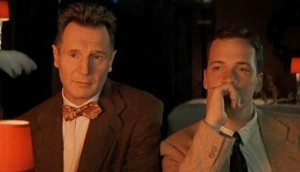 Kinsey experiments with homosexuality with fellow researcher Clyde Martin, played by Peter Sarsgaard. But it was his wife Clara who taught him the necessity of restrictions, boundaries and loyalty. The film ends wistfully, though a little more epilogue impact could have immortalized the film more potently. Co-stars include Oliver Platt as the Indiana University President, Timothy Hutton and Chris O’Donnell as research recorders, Tim Curry as an uptight academic, Dylan Baker as a chief at the Rockefeller Foundation, and William Sadler as a gloating sex deviant. Grade: A
Kinsey experiments with homosexuality with fellow researcher Clyde Martin, played by Peter Sarsgaard. But it was his wife Clara who taught him the necessity of restrictions, boundaries and loyalty. The film ends wistfully, though a little more epilogue impact could have immortalized the film more potently. Co-stars include Oliver Platt as the Indiana University President, Timothy Hutton and Chris O’Donnell as research recorders, Tim Curry as an uptight academic, Dylan Baker as a chief at the Rockefeller Foundation, and William Sadler as a gloating sex deviant. Grade: A
118 Minutes. Rated R.
HISTORICAL DRAMA / FOOD FOR THOUGHT / SPRING AWAKENING
Film Cousins: “Gods and Monsters” (1998); “The Century of the Self” (2002, Great Britain); “A Dangerous Method” (2011); “Hysteria” (2012).
BLUE VALENTINE
“In my experience… the prettier a girl is, the more nuts she is, which makes you insane.” – Dean
Far more accomplished than I first gave it credit for. Blue Valentine (2010) portraits the acrimony, and disintegration, of a young married couple besotted with flashbacks of their poetic enchantment in their beginning. Why might you want to see this, you ask, it sounds so unpleasant? Perhaps it will trigger recall of all the toxic relationships of your past, and you will ask yourself with a new evolved sense of self-recognition, “Why did I put up with that at the time?” or perhaps, you will consider with eerie admittance the awful relationship you are in now, and you need a good prodding to escape from the trap you’re in.
I have always recognized Ryan Gosling and Michelle Williams as method actors, but on my second viewing I really noticed their brilliance of getting into flawed, self-sabotaging personalities. I might have thought the movie was meandering, too, in my first viewing. Now I see it more clearly: In the present, it depicts the final three days of their marriage, and then goes back in episodes to depict the optimistic beginning of how Dean and Cindy met. Going to the “Future Room” at a sex motel to patch up a marriage is not going to work when one of you doesn’t feel like having sex.
They meet in a convalescent home while visiting old folks. Dean can’t stop thinking about Cindy, then he runs into her on a bus, and goes full-throttle into a series of pick-up lines. That works. They make love. But Cindy finds out she’s pregnant from her previous boyfriend, the kind of guy who doesn’t get why he was dumped (Hey dude. Saying “What the f&#% is your problem” is not a relationship fixer.) Dean will marry Cindy even if it’s not his kid, yet it’s so apparent that not being the biological parent bothers him.
In the present, it doesn’t occur to Dean that he’s married, has a kid, and has a drinking problem that should have been solved before they tied the knot. Cindy is irritated that he so casually throws away “potential” at growing as a human being. But Dean is happy moving furniture and painting houses. Dean loved at one time that Cindy was a nurse, but that doesn’t seem so true after he threatens her job security.
 I said in a previous review that I admired “Blue Valentine” immensely but that there is a limit to how much you can love the movie because Dean and Cindy are idiots. Well, in hindsight, I change my opinion slightly. Decent people can turn into idiots when they’re trapped in toxic love. It’s not a good sign when Cindy rejects Dean sexually, and Dean rejects any respect for Cindy’s job. Marriage counseling might have salvaged something, but these two create a portrait of all the things not to do if you want to save a relationship.
I said in a previous review that I admired “Blue Valentine” immensely but that there is a limit to how much you can love the movie because Dean and Cindy are idiots. Well, in hindsight, I change my opinion slightly. Decent people can turn into idiots when they’re trapped in toxic love. It’s not a good sign when Cindy rejects Dean sexually, and Dean rejects any respect for Cindy’s job. Marriage counseling might have salvaged something, but these two create a portrait of all the things not to do if you want to save a relationship.
The artful cross-cutting, penetrating and wounding dialogue, mood-altering light design is the work of young filmmaker Derek Cianfrance. His new film “The Place Beyond the Pines” opens in two weeks and it is the kind of triumph that cements his status as one of the most exciting new filmmakers on the scene. When I saw it I knew I had to revisit “Blue Valentine” again right away, and I see now that the film has a fresh, immediate relevance to its subject. With these two films, I’m already excited to see new Cianfrance films like I look forward to P.T. Anderson, Van Sant or Payne. He’s got me that primed. Grade: B+
112 Minutes. Rated R.
DARK DRAMA / PSYCHODRAMA / FALL MOVIE
Film Cousins: “New York New York” (1977); “Revolutionary Road” (2008); “500 Days of Summer” (2009); “Goodbye First Love” (2012, France).
ABOUT A BOY
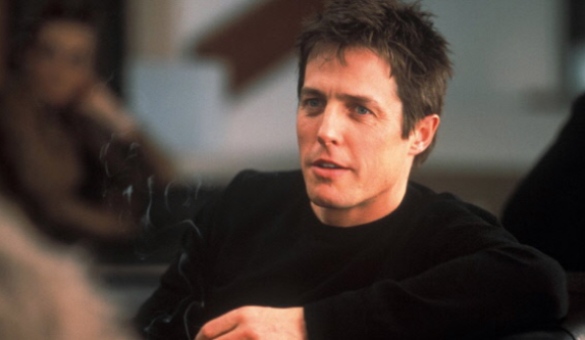
“In my opinion, all men are islands.” – Will Freeman
Endearing comedy about a 38-year old bachelor who has never held a job. About a Boy (2002) isn’t about Hugh Grant (as Will Freeman) getting one. He lives off of eternal royalties from the song “Santa’s Super Sleigh” that was composed by his late father, and so he lives his days vegging on the couch, spoiling himself on fashion, and dating pretty but superficial women. He meets one pretty woman by posing as a single father at a support group, gets a date with a strong-minded woman (Rachel Weisz) and she points out to him that he hasn’t a passion or drive for anything because he lives vainly. This bugs him.
Will gets drawn into the lives of a depressed single mom (Toni Collette) and her 12-year old geek son Marcus (Nicholas Hoult). The actor himself is hopelessly geeky, about as potent as Kool-Aid. He plays a kid who likes girls but is nevertheless an effeminate peach of a lad. Marcus harasses Will because he knows he’s a fraud single parent, and in exchange for keeping his mouth shut, he wants Will to teach him how to be a winner, or at least how to be less of a loser. Teaching him to wear a different hat perhaps.
The egotistical bachelor goes through a seasonal change. Going through life without working or caring for something eventually leaves one spiritually desolate. It doesn’t have to be a job for a paycheck, but even a well-off guy like Will must feel the need to be responsible for something. And so his mentoring of Marcus into a cool kid becomes his occupation.
The goal for Marcus is to get up in front of the school auditorium and sing “Killing Me Softly,” a girly soft ballad that is all mush. Will tries to stop him, but the lesson here is: If you can’t stop him, join him. I have no idea how the Nick Hornsby novel reads, but I imagine it whisks along amicably. The movie does that, too, but the bonus is seeing these actors’ dimples.
For a lark, I thought I’d print Will’s explanation of his daily regimen:
I find the key is to think of a day as units of time, each unit consisting of no more than thirty minutes. Full hours can be a little bit intimidating and most activities take about half an hour. Taking a bath: one unit, watching countdown: one unit, web-based research: two units, exercising: three units, having my hair carefully disheveled: four units. It’s amazing how the day fills up, and I often wonder, to be absolutely honest, if I’d ever have time for a job; how do people cram them in?
Grade: B+
COMEDY / MILD & CHARMING / WEEKEND WITH A GLASS OF WINE MOVIE
100 Minutes. Rated PG-13.
Film Cousins: “Three Men and a Baby” (1987); “High Fidelity” (2000); “Bridget Jones’s Diary” (2001); “Alfie” (2004).
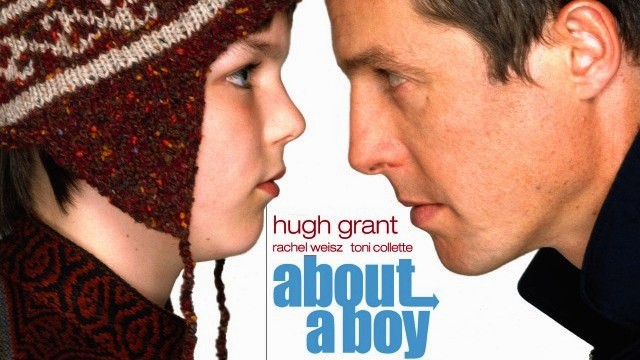
THE GRIFTERS
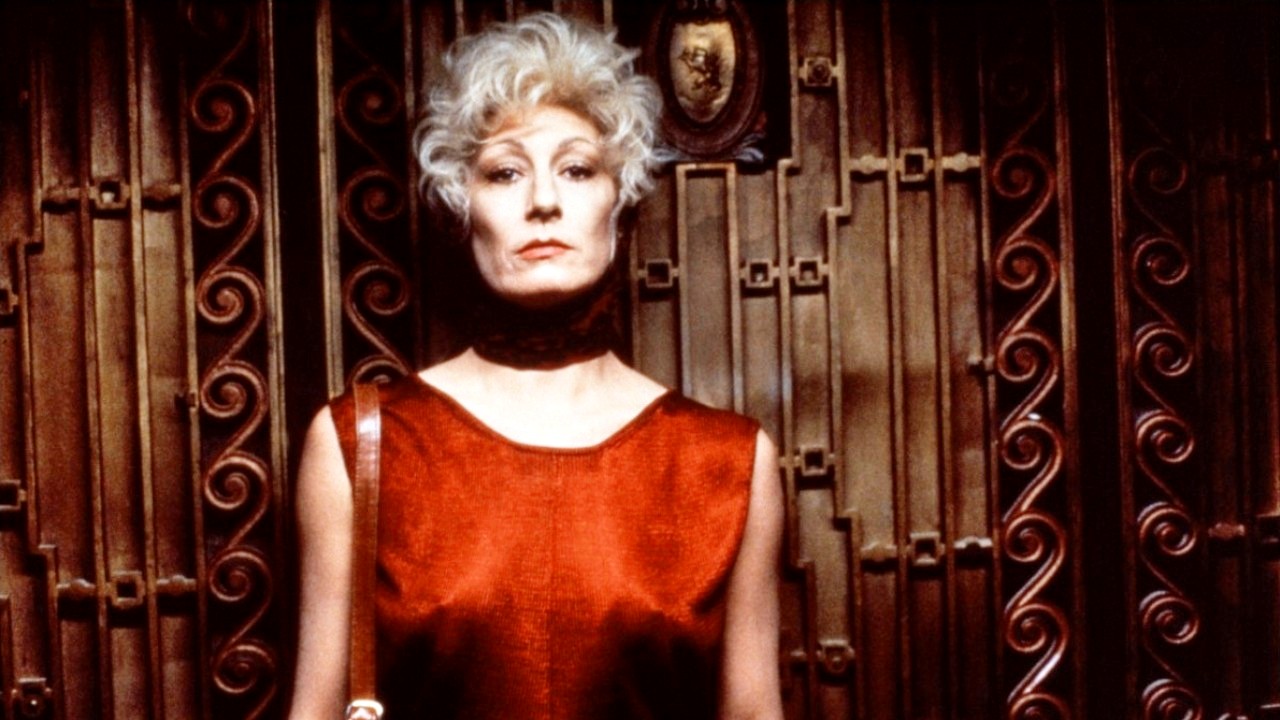
“You’re working some angle and don’t tell me you’re not, because I wrote the book.” – Lilly Dillon
The seedy world of the con artist game film noir style, based on the novel by Jim Thompson. The Grifters (1990) informs us that there are two different kinds: the short con and the long con. Roy Dillon (John Cusack, marvelously subtle) is a maestro of the short con. Dice games. Pool games. Typically, he walks into a bar to ask for a beer, flashes a $20, slides it under his wrist, slides the bartender a $10 bill. At a crucial point in time he gets caught by the wrong bartender, and is forced to the hospital. It is there that his mother Lilly (Anjelica Huston) and girlfriend Myra (Annette Bening) will meet and mark the beginning of a new tricky trajectory. Roy’s mother has always been a racketeer at the horse track, his girlfriend a maestro of the long con – one that requires set-up money, weeks to orchestrate, big pay-offs that are riskier law-breakers.
Something is clearly wrong when Lilly and Myra meet when they visit Roy in the hospital. These two women hate each other, but the more we observe them, the more we think of how similar they are to each other. At one point at an Arizona motel under shrouded light, they are a mirror image of each other. The director is Stephen Frears (“Dangerous Liaisons,” “Hero”) who must have been very aware that he was making a film about not only two women competing for Roy but also competing for his money.
The Oedipal complex theory is a nasty but ingenious theme in the story, one written by novelist Jim Thompson (“After Dark My Sweet,” “The Killer Inside Me”) and adapted by Donald Westlake (“The Hot Rock,” “The Stepfather”). Roy might have an inkling that something’s up with his tart girlfriend, but he’s less than cautious. He doesn’t know that she sells her body for money, anywhere or anytime! Myra does let him know that she was involved in high-stakes cons stooping stock market investors. Why tell him now? Myra propositions Roy to join her for the long-con, all she needs is money to set-up shop.
 Certainly one can’t help but notice Bening’s body, and here is an actress that is also weirder, kinkier, and just more fiercely cunning than she’s ever been. Sex is nice, but love an improbability when it comes to her. She turns Myra into one of the most unforgettable femme fatales. Huston is an infallibly gritty actress when it comes to Lilly, whose condescending speech to others comes off like pelting stones. Pat Hingle, as her mob boss bookie, is the only one who strikes terror into her. Warning to the faint at heart: Hingle’s character commits violence against women.
Certainly one can’t help but notice Bening’s body, and here is an actress that is also weirder, kinkier, and just more fiercely cunning than she’s ever been. Sex is nice, but love an improbability when it comes to her. She turns Myra into one of the most unforgettable femme fatales. Huston is an infallibly gritty actress when it comes to Lilly, whose condescending speech to others comes off like pelting stones. Pat Hingle, as her mob boss bookie, is the only one who strikes terror into her. Warning to the faint at heart: Hingle’s character commits violence against women.
Lilly with instinct knows that Myra is capable of tripping up anybody, including her son. Lilly, let’s face it, was one of those young women like Myra – a one-time tart, now cougar. Lilly knows: Cash is absolute to the grifter who has no loyal ties, and by the end love is dispensable. To a grifter, love is just playing an angle. Grade: A-
114 Minutes. Rated R.
Film Cousins: “House of Games” (1987); “After Dark My Sweet” (1990); “The Kill-Off” (1990); “Confidence” (2003).
STUCK ON YOU
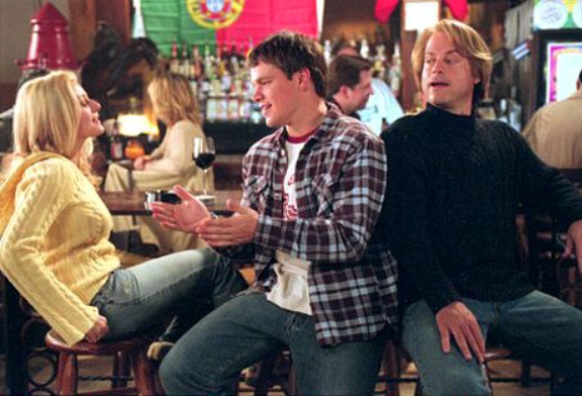
Funny and feel-good, a combo that is all but absent now. Stuck On You (2003) is a reminder as to when the Farrelly Brothers mojo was working. They’ve had a couple of amusing, sophomoric movies since then such as “The Heartbreak Kid” and “Hall Pass,” which are not without their bumps and cold sores. But this was really their last one where it felt they had a stride of confidence working throughout the picture. It’s not a relentless laugh riot, but you might feel an affection for it. Not even great by comedy classic standards, but it is a welcome laid-back nice one.
Matt Damon and Greg Kinnear starred as conjoined twins at the hip who have happily succeeded at just about everything, especially hockey. They flip burgers at their own café, but now one of them has Hollywood dreams. The alpha brother Walt (Kinnear) wants to go become a television and movie actor, and he luckily meets up with Cher. Bob (Damon) has a longtime online girlfriend who doesn’t know he’s a twin, a pairing that’s so embarrassing and unseemly that it’s a surprise that they eventually look cute together.
 Eva Mendes (importantly!) is the hot gal pal whose simple wisdom shines through. Meryl Streep (Walt’s dream come true celebrity sighting!) is awesomely hip in her two scenes. Seymour Cassel and Griffin Dunne are equally droll as Hollywood industry types. Perhaps this movie is successful because it allows Walt and Bob to make friends in all the right places.
Eva Mendes (importantly!) is the hot gal pal whose simple wisdom shines through. Meryl Streep (Walt’s dream come true celebrity sighting!) is awesomely hip in her two scenes. Seymour Cassel and Griffin Dunne are equally droll as Hollywood industry types. Perhaps this movie is successful because it allows Walt and Bob to make friends in all the right places.
Originally an idea was tossed around to have Jim Carrey and Woody Allen as the conjoined brothers. I would have liked to have seen that version, too. But I’m glad to see Damon in this deep end goofy project, since as funny as he is, he’s often committed to too many stark dramas. This is the one time we really get to see Damon play insecure, self-doubting, and even a little dopey. Kinnear’s career is hit and miss, but he’s an appealing actor whose unlikely cockiness, opposite his twin, makes this funnier. His blowout hairstyle compliments his can-do attitude, a very integral cosmetic choice.
The Farrelly Brothers must have felt at ease watching these two guys have fun with each other, since the chemistry is so bouncy. There is only one masturbation joke that I could recall, and it’s a good one. Criticizing his brother, Walt says, “Last night it was like trying to sleep next to a paint-shaker.” Everything is in good moderation here. The Farrelly Brothers movies today have regressed back into all raunch, all grossness, all the time. The unremitting gross factor that is their “Movie 43” became their career debacle this weekend. It’s time for the Farrelly Brothers to look back to this gem from 2003. Grade: B+
118 Minutes. Rated PG-13.
Film Cousins: “Dumb & Dumber” (1994); “Kingpin” (1996); “There’s Something About Mary” (1998); “Shallow Hal” (2001).
PSYCHO
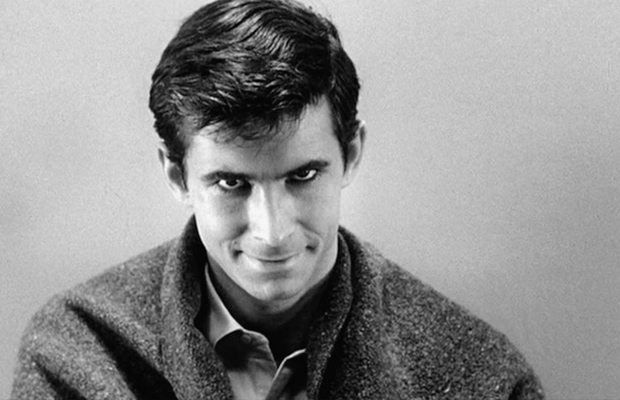
“I was directing the viewers. You might say I was playing them, like an organ.” – Alfred Hitchcock
Watershed cinema. Alfred Hitchcock’s Psycho (1960) changed the way deranged killers were perceived outwards in our real world and the way inwards movie genre clichés were bent and reshaped. Norman Bates, as played by Anthony Perkins, is a quirky and even gushy normal-seeming guy with hidden subversions and deviances. He is one of the most famous psychopaths of the movies, up there with Hannibal Lecter. Perhaps this is due because we acknowledge his exterior intellect first. That Norman could hold up a polite conversation with Marion Crane (Janet Leigh) is a reminder that mentally ill people can feign normalcy when necessary. You have to be able to look for the clues. Marion sees a few stuffed birds. Marion acknowledges artificial laughter from the man, as if he were desperate for acceptance. The audience gets a whoopee of extra private insight, when we learn that Norman is a peeping tom. And that he wanted with zeal to be as much a matronly mother like his own that he began dressing up like her.
The whopping plot twist surprise is what makes the heart stop during your first view of “Psycho.” Brought up on cookie-cutter television series and generic three-act movies, the first whopper truly is a WTF moment. But it goes beyond there. My favorite two shots by Hitchcock are of a flushing toilet and of a car that doesn’t quite sink to the bottom of the mote. Impassive black & white cinematography made it all the more viscerally effective.
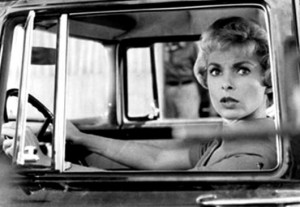 Marion is hiding a secret too, the $40,000 she has run off with. Nobody knows her whereabouts or that she ended up at a roadside motel, aptly “Bates Motel.” Marion is horrible with secrecy, and it’s after that conversation with Norman that she might be having a change of heart and might return the money. Her lover Sam Loomis (John Gavin) is bland and lacks a strong opinion – a great excuse for Hitchcock to select a bland actor. Marion’s sister Lila (Vera Miles) is also bland and middling – in this case a mistake in casting.
Marion is hiding a secret too, the $40,000 she has run off with. Nobody knows her whereabouts or that she ended up at a roadside motel, aptly “Bates Motel.” Marion is horrible with secrecy, and it’s after that conversation with Norman that she might be having a change of heart and might return the money. Her lover Sam Loomis (John Gavin) is bland and lacks a strong opinion – a great excuse for Hitchcock to select a bland actor. Marion’s sister Lila (Vera Miles) is also bland and middling – in this case a mistake in casting.
Of course, the greatness of “Psycho” is usually summed up in its foremost snuff scene; we feel it more because of the artistry involved. The shower sequence, requiring 78 edits for 45 seconds of film, remains a landmark for the psycho genre. I think those superfluous edits however mean something more: that Norman didn’t just like to kill, he liked to torment while he was killing. Making his victim recognize they were going to die – and feel helpless during it. Norman doesn’t just have a dirty mind, he has a wicked mind. Another man dies, slashed, taking a long flight down to the bottom. This is torment.
 But if “Psycho” isn’t quite the masterpiece to me that it is to other critics it’s because I always felt Hitchcock was merciless in crafting pure terror except for the climax in the cobwebby basement where he holds the camera on skull and bones, with shadow silhouettes dancing before our eyes – Hitchcock surrendered too much mercy to his audience. For all the shocking macabre of most of the picture, this final confrontation lacks slashes, nicks and the inevitable blood. I just see two actors playing tug-of-war.
But if “Psycho” isn’t quite the masterpiece to me that it is to other critics it’s because I always felt Hitchcock was merciless in crafting pure terror except for the climax in the cobwebby basement where he holds the camera on skull and bones, with shadow silhouettes dancing before our eyes – Hitchcock surrendered too much mercy to his audience. For all the shocking macabre of most of the picture, this final confrontation lacks slashes, nicks and the inevitable blood. I just see two actors playing tug-of-war.
When I recall “Psycho” I picture Norman Bates stuttering silently, I can almost see the skeleton flapping his jaw underneath the skin. I have these eternal memories of Norman, with the aid of ghastly black & white. Revisiting “Psycho,” I like the first 80 minutes best. Grade: A-
109 Minutes. Rated NR, mature audiences only.
Film Cousins: “Peeping Tom” (1960, Britain); “Frenzy” (1972); “The Texas Chainsaw Massacre” (1974); “American Psycho” (2000).

CHOPPER
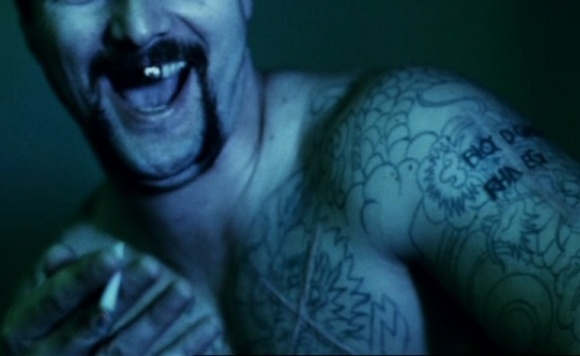
“I sold 250,000 copies. And I can’t even spell. I’m semi-bloody illiterate.” – Chopper Read, Aussie criminal
I’m not going to tell you who the main star is because if you know it spoils the fun a bit, mate. Chopper (2000, Australia) is the story of a sadistic, psychopathic criminal who became famous for his street rep and even more famous when he went to prison and became a tell-all celebrity whose exploits were told with a kind of fervid mania (Australians tuned in to see him and read about him because he was so wacko). It was the first feature film made by the bold Andrew Dominik (his other credits are “The Assassination of Jesse James by the Coward Robert Ford” and the current “Killing Them Softly”) who has more style than not. Here’s a writer-director who has an ear for bizarre, surly lowlife language.
You’re interested because you’re into crime stories and character studies, and well, this flick is a bizarre one-of-a-kind entry. The violence itself is blunt and indifferent, not built on exciting chases or showdowns. Dominik does more to focus in on character to make up for the fact that this was a low-budget indie – most of his framing is done with a planted camera with scenes that absorb in and around bars, alleyways and decrepit apartments that occupy druggies. Chopper, whether he appears to have a plan or not, hustles through the swine-infested Australian underbelly for a living. Certainly a strange breed of man, Chopper often comments about himself in third person.
All the while you’re going, “Who the #$&% is this actor playing him!” If you do happen to know who it is, you’re still floored by the transformation because nothing else he ever did was as close to meathead as Chopper Read. If you don’t know, it’s vexing that here is an actor who has gone on to become a viable midrange star in American movies. Oh sure, if you must know, you can go spy imdb or Netflix for the actor’s name. Make your own spoil, will you. As for this article, this is the only time I’m not going to state a lead actor’s name in a review.
The man of Chopper Read is an intricate, unfathomable mystery because he is too crazy to understand in a conventional way. His nickname itself is a myth with five or six floating theories as to why he became known as “Chopper.” Insights are limited on a man this deranged, but I will add this: Chopper did not appear to be an “organized” criminal. He had associates and a sewing circle, but really he was his own lone-wolf violent psychopath who pounced on the weak and exploited cash opportunities. One that could barely read. Grade: B
90 Minutes. Unrated but for adults only.
Film Cousins: “The Square” (2008, Australia); “Bronson” (2008, Britain); “Animal Kingdom” (2010, Australia); “Killing Them Softly” (2012).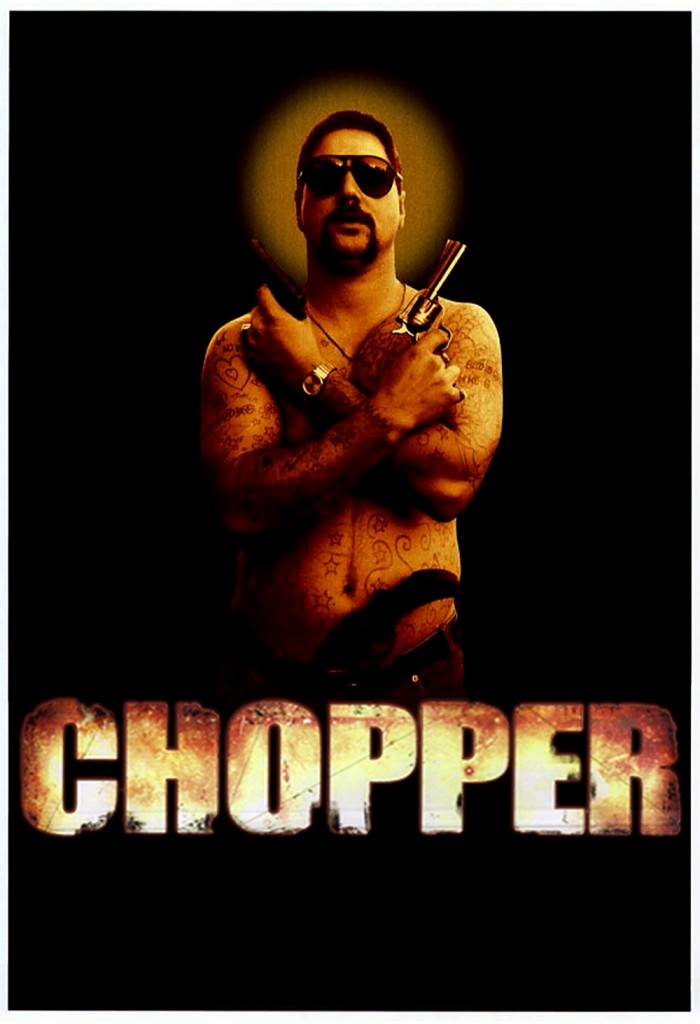
FEARLESS

“You want to kill me but you can’t!” – Max Klein to God
Regards the euphoria felt upon surviving certain death. Fearless (1993) features Jeff Bridges as San Francisco architect Max Klein, who survives a plane crash and even comes away as a hero to other passengers on board. Amid the wreckage aftermath, he quietly disappears. He doesn’t call home to his wife (Isabella Rossellini). Instead, the story considers how a man escapes death and now selfishly lives to his own whims, living life as if investigating a new philosophy. Chucking responsibilities off to the side; accepting a new state of grace that eliminates money, rules, and his social roles. This was startling drama when I first saw it in the 1990’s. Today, I find it just as compelling as before but standoffish and even self-absorbed. Still, it’s an interesting picture albeit often downbeat. The director is Peter Weir (“The Year of Living Dangerously,” “Witness”).
Bridges returns home to his wife and child, has a psychiatrist (John Turturro) and a lawyer (Tom Hulce) hounding him for good and bad reasons, and is completely smug in all of his interactions. Except one: Crash survivor Carla (Rosie Perez, Oscar-nominated) falls into a deep depression after losing her baby in the fiery plane, and Max falls in love with “saving” her. A deep friendship is forged, with an intimate bond that is stronger than the one he has with his wife. Nothing inadequate with her: She is patient, an intellectual, a ballet teacher for occupation, a thoughtful parent. Being shut out by Max makes her finally lose patience.
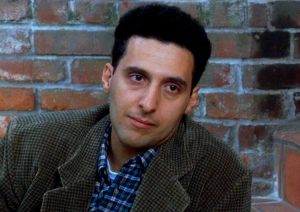 The lawyer says “I know, I’m terrible!” with gleeful capriciousness, asking witnesses to embellish their remembrance of the tragedy. He wants Max to testify on behalf of widows of the dead that he saw hideous death before his eyes and perhaps use Max’s suicidal behavior to get more money for his family. The lawyer takes issues with the crash’s dead babies as an equation for settlement money from the airline. Max and Carla know that money can’t bring back a life. Dr. Bill Perlman, Max’s psychiatrist, has a sensitive capacity to understand this too, but can’t belong to the club. It’s a terrific performance by Turturro really (pic, left), as a man with heightened sagacity and yet a bashfulness that inhibits himself from truly living life to its limits.
The lawyer says “I know, I’m terrible!” with gleeful capriciousness, asking witnesses to embellish their remembrance of the tragedy. He wants Max to testify on behalf of widows of the dead that he saw hideous death before his eyes and perhaps use Max’s suicidal behavior to get more money for his family. The lawyer takes issues with the crash’s dead babies as an equation for settlement money from the airline. Max and Carla know that money can’t bring back a life. Dr. Bill Perlman, Max’s psychiatrist, has a sensitive capacity to understand this too, but can’t belong to the club. It’s a terrific performance by Turturro really (pic, left), as a man with heightened sagacity and yet a bashfulness that inhibits himself from truly living life to its limits.
Max’s suicidal behavior however is intentional, like he is challenging God. He acts in a way of someone who has come to believe they are invincible. If a plane crash can’t take his life, then why not live recklessly? We see the fragments of the plane crash through interval flashbacks, put together in entirety by the film’s close, and come to figure out the post-traumatic stress syndrome that accounts for Max’s behavior. It’s about time for God to shoot Max down to Earth to live like the rest of us again.
As for the plane crash, it is awesome in its horror and is for a few moments surreal (Max has reinterpreted his own memory of what happened). And yet, the movies have gotten better, more technically vivid – “Flight” in theaters now has a more stupendous one. Grade: B
124 Minutes. Rated R.
Film Cousins: “Hero” (1992); “Alive” (1993); “White Squall” (1996); “Flight” (2012).
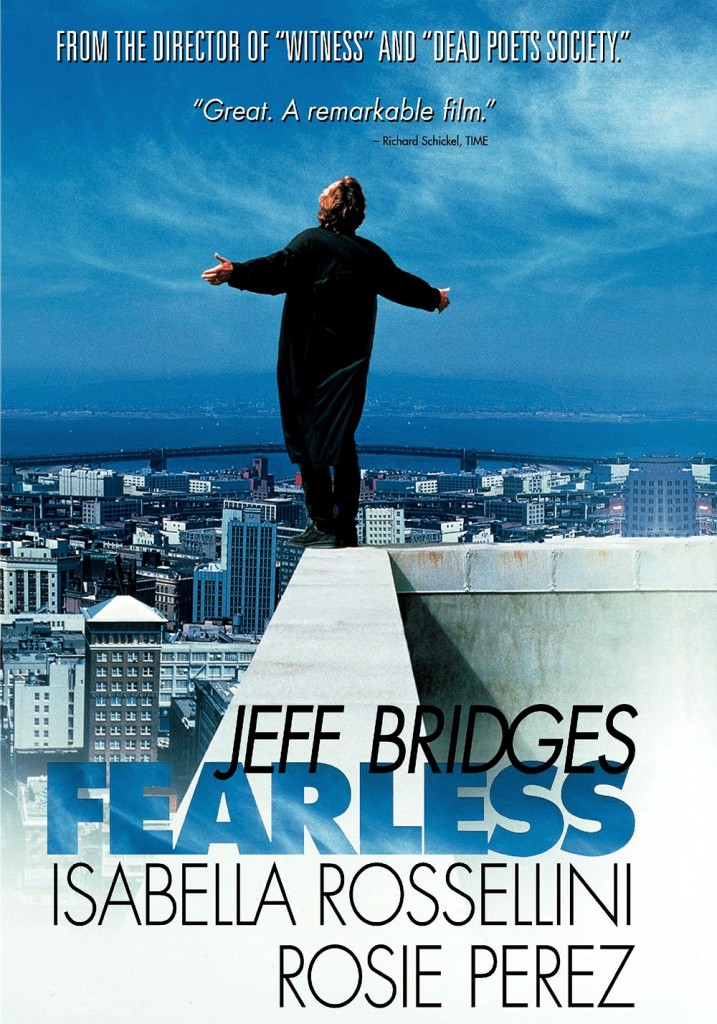
INVASION OF THE BODY SNATCHERS

I keep seeing these people, all recognizing each other. Something is passing between them all, some secret. It’s a conspiracy, I know it.” – Brooke Adams
Oozing with dread, a great Halloween scarefest. Invasion of the Body Snatchers (1978) is riveting for any time of year, and artistically, it has a unique vision of complete world takeover. Donald Sutherland and Brooke Adams are San Francisco Health Inspectors that catch on that pod people from another planet are replicating and replacing human beings. They get you in your sleep!
The movie is two hours of breathless paranoia that tugs at our suspicions from the get-go because the notice of odd, aberrant behavior in random people that we glimpse. By the time bureaucratic agencies decline in favor of more organized replacement agencies the tension gets white knuckle.
Director Philip Kaufman takes the city of San Francisco and turns it into a sealed vortex with no way out. It gets freaky when the aliens scream to alert their own kind! The matter-of-fact approach is what is so spine-tingling.
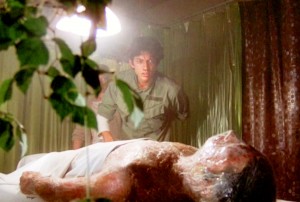 Cinematographer Michael Chapman did some of the best cinematography work ever done in a horror film outside of “The Shining.” You see a lot of venomous colors like greens and ultraviolet purples in the film, but you also get that deliberately blurry and darkness feel that you see in the best noirs. Kaufman is the top genius here, going on to direct “The Right Stuff” (1983) and “The Unbearable Lightness of Being” (1988). Veronica Cartwright, Jeff Goldblum, Art Hindle and Leonard Nimoy co-star.
Cinematographer Michael Chapman did some of the best cinematography work ever done in a horror film outside of “The Shining.” You see a lot of venomous colors like greens and ultraviolet purples in the film, but you also get that deliberately blurry and darkness feel that you see in the best noirs. Kaufman is the top genius here, going on to direct “The Right Stuff” (1983) and “The Unbearable Lightness of Being” (1988). Veronica Cartwright, Jeff Goldblum, Art Hindle and Leonard Nimoy co-star.
Four times. “Body Snatchers” has been made into four incarnations with each film approaching the story from a fresh angle, with particularly different characters and geographical settings. This 1978 version remains the best. The 2007 release “The Invasion” (featuring a deplorable ending!) with Nicole Kidman and Daniel Craig, was the only failure in the group. Special note: the 1994 version by director Abel Ferrara is very underrated. Grade: A
117 Minutes. Rated PG.
Film Cousins: “Invasion of the Body Snatchers” (1956); “Dawn of the Dead” (1979); “Body Snatchers” (1994); “The Invasion” (2007).

MIDNIGHT EXPRESS
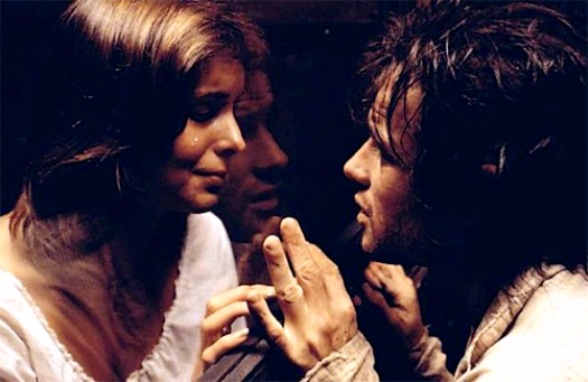
Midnight Express (1978) has been perceived through the years as either a 70’s prison movie classic or as an overcooked melodrama of injustice. The film, directed by Alan Parker and penned by first-time screenwriter Oliver Stone, caused quite a stir at its 1978 Cannes Film Festival premiere and divided critics. The studio lacked faith in its box office potential due to its harsh themes, and almost demanded a commercialized ending (that was discarded), but audiences found it a sensation anyway. It is overcooked, and even inaccurate. But rousing anyway. The film was nominated for several Academy Awards including Best Picture and Director, and won for Best Screenplay by Stone and Best Original Score by Giorgio Moroder.
Parker and Stone have confessed to taking major dramatic liberties in telling the story of Billy Hayes (Brad Davis, a startling newcomer at the time in a role meant first for Richard Gere), an American tourist condemned to a Turkish prison for attempting to smuggle dope out of the country. Billy Hayes and his girlfriend Susan (Irene Miracle) are on their way back to the States. Billy tapes drugs wrapping around his torso to smuggle it past authorities but is caught at the plane tarmac.
Billy has the opportunity to cooperate with authorities, but he blows it and finds himself thrown into the filthiest prison you’ve ever seen. On the first night Billy, while freezing in his stone-cold cell, attempts to steal a blanket and consequently is caught – he is bound upside down and beaten severely.
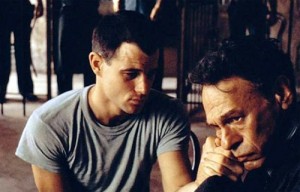 It gets worse from there, and Billy is sentenced to four years of incarceration replete with rampant homosexuality, frugal bartering, substance abuse and madness. Billy’s father (Mike Kellin) makes a long-trip visit: “I don’t want you to get stupid and pull anything. They can play with your sentence.” In strenuous survival conditions, Billy has to play good for the next four years or face an excessively protracted prison sentence that could last for decades. The film features inflammatory supporting performances by Randy Quaid and John Hurt as longtime locked-up fellow prisoners. Parker’s superb direction is feverishly propelled by Moroder’s powerful electric music score.
It gets worse from there, and Billy is sentenced to four years of incarceration replete with rampant homosexuality, frugal bartering, substance abuse and madness. Billy’s father (Mike Kellin) makes a long-trip visit: “I don’t want you to get stupid and pull anything. They can play with your sentence.” In strenuous survival conditions, Billy has to play good for the next four years or face an excessively protracted prison sentence that could last for decades. The film features inflammatory supporting performances by Randy Quaid and John Hurt as longtime locked-up fellow prisoners. Parker’s superb direction is feverishly propelled by Moroder’s powerful electric music score.
Parker and Stone confessed to taking dramatic liberties (the “madhouse” scene didn’t happen in the chronology as presented in the film) and stretching the truth. The Turkish wardens and guards are unremittingly unmerciful, but aren’t there prisons all over the world that are actually unmerciful? This remains a story of a young man’s resilience through inhumane conditions.
If there’s anything to love about ’70’s cinema, the true Golden Age of Hollywood, is that movies routinely dared to explore tough subject matter that bucked the system. This maverick attitude pertains to “Midnight Express.” Grade: A-
129 Minutes. Rated R.
Film Cousins: “Papillon” (1973); “Brokedown Palace” (1999); “Bus 174” (2002); “Argo” (2012).

HARD EIGHT

“Never ignore a man’s courtesy.” – Sydney
The first Paul Thomas Anderson feature. Hard Eight (1997) has technical cleverness for a low-budget indie, but it does crucially benefit from the casting of Philip Baker Hall, John C. Reilly, Gwyneth Paltrow and Samuel L. Jackson as Jimmy. The movie is more than a genre homage, it’s the real stuff since Anderson (“Boogie Nights,” “The Master”) seems to know in detail the beat and language of street hustlers and gamblers. The original title was “Sydney,” so close to becoming released with that title that theatrical posters were printed.

Sydney is the name of the old hood played by Hall. Self-assured, you’d hardly guess that he needs anybody in this life. But he picks up a penniless drifter with face buried in lap outside of a coffee shop. He offers to buy this drifter John (Reilly) some breakfast, and to pitch him an offer. He teaches him a scheme on how to get a Las Vegas room by manipulating a player’s rate card. This is the beginning of a long friendship, one of mentor and protégé.
Sound motifs are important in the film, you might recognize the chime-bells beckoning hell – the same gong sound used in “Boogie Nights.” We hear it at the opening when Sydney and John meet. And again, to signal that perhaps Sydney has gone too far in befriending someone unwisely. Sydney is shrewd, street smart and poised. Which has us wondering why he would position himself to be in the middle of trouble with people beneath him.
 Paltrow’s character is a cocktail waitress who moonlights as a hooker. Jackson is a small-time hood with a suitcase full of guns, and is generally badass in a way that Morgan Freeman was in “Street Smart” (1987). Sydney wants small things from these people, one of these things is respect, which he earns with subtlety. His generosity is noted, but by the end, you realize that he’s buying something back that isn’t paper currency.
Paltrow’s character is a cocktail waitress who moonlights as a hooker. Jackson is a small-time hood with a suitcase full of guns, and is generally badass in a way that Morgan Freeman was in “Street Smart” (1987). Sydney wants small things from these people, one of these things is respect, which he earns with subtlety. His generosity is noted, but by the end, you realize that he’s buying something back that isn’t paper currency.
“Hard Eight” isn’t the master symphony of Paul Thomas Anderson, but it is an interesting and savvy little film. If you’re looking to be a completist of his work, then it’s something you have to catch up to. And another Anderson regular Philip Seymour Hoffman pops up, and this I promise is the only time you will see him with a mullet. Grade: B
93 Minutes. Rated R.
STREET DRAMA / MOODY CHARACTER STUDY / MONDAY-THURSDAY NIGHT DRAMA
Film Cousins: “Mean Streets” (1973); “The Killing of a Chinese Bookie” (1976); “The Color of Money” (1986); “Boogie Nights” (1997).
LIFE LESSONS

“It’s art. You give up, you were never an artist in the first place.” – Lionel
One of Martin Scorsese’s most raging, hormonal, triumphant achievements is without a doubt Life Lessons (1989) with Nick Nolte as Lionel Dobie. Wait – you’re a Scorsese fan and you’ve never heard of it? Actually it is a short film segment in the anthology film “New York Stories,” with two entries by Francis Ford Coppola and Woody Allen that are so mediocre they are not worth discussion. But the Scorsese film is undervalued, and worthy of his career highlights.
Just like Jake LaMotta in “Raging Bull,” Scorsese’s protagonist Lionel is a madly possessive man anxious over his own feelings of sexual inadequacy. But he trumps up his self-importance to masquerade his own doubts. He blasts rock ‘n’ roll while he’s working, or thinking. The particular favorite is Procol Harum’s “A Whiter Shade of Pale,” thus, the theme song. I forever associate that song now on the radio to this film when I hear it.
It’s true that every few years I play “Life Lessons”and find something new. It became more apparent, with an illuminated importance, that the crucial detail of the film is that Lionel pays to have a live-in girlfriend. The vainglorious artist first titles this woman as his assistant, but always, there gestates expectation for more. Paulette (Rosanna Arquette) has made him swear that sex is over between them, but Lionel insists that she remains there. She is a protégé artist herself, and stays for the career guidance.
Lionel gives his reasons, but really, he can’t seem to paint without a breathing human being in his high-priced studio loft. He needs the noise and aggravation of another human to motivate him. Now that she has moved back in, he can work on his gigantic canvas that begins with pencil etching. At first it doesn’t even appear to be a good art piece, but I’ve always been in awe in the process of creative art how something meager can transform. The painting gets better and better as he colors it in and adds distinctive details – a masterwork painting comes to life.
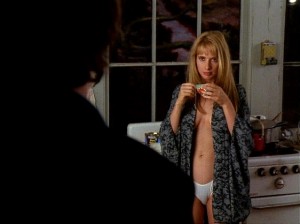 When Paulette is too quiet Lionel goes to her upstairs bedroom to bug her, to snoop. He doesn’t call it snooping, he calls it concern. Yet he drops in hints that he wants to reignite the passion between them. Paulette has other romantic interests, including a young performance artist (Steve Buscemi) who is also in his own way self-absorbed. Lionel is fueled by this inchoate competition, and eventually they meet. At the art exhibits it is conveyed that Lionel is a beloved world class artist. Yet he is willing to cave into self-humiliation to win this unattainable assistant, one who is temporary, drama-starved, and emotionally selfish anyway.
When Paulette is too quiet Lionel goes to her upstairs bedroom to bug her, to snoop. He doesn’t call it snooping, he calls it concern. Yet he drops in hints that he wants to reignite the passion between them. Paulette has other romantic interests, including a young performance artist (Steve Buscemi) who is also in his own way self-absorbed. Lionel is fueled by this inchoate competition, and eventually they meet. At the art exhibits it is conveyed that Lionel is a beloved world class artist. Yet he is willing to cave into self-humiliation to win this unattainable assistant, one who is temporary, drama-starved, and emotionally selfish anyway.
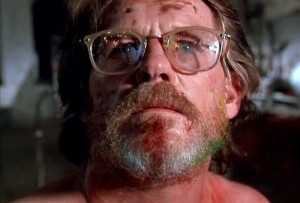 Lionel becomes a case study of a man who goes through way too much trouble for superficial love. Nolte, shrouded in a shaggy beard, speckled by art paint, and pitifully groveling, is transformed into this role in the way DeNiro did with “Raging Bull.” With Lionel, however, he pays for girls to be an assistant, a muse, and likely sexpot. They cannot be whores, because to him it is consensual. He offers life lessons that are “priceless,” he says as a lure. His ideas are meant to have worldly sophistication. We see him in the way he doesn’t see himself. An old man getting older.
Lionel becomes a case study of a man who goes through way too much trouble for superficial love. Nolte, shrouded in a shaggy beard, speckled by art paint, and pitifully groveling, is transformed into this role in the way DeNiro did with “Raging Bull.” With Lionel, however, he pays for girls to be an assistant, a muse, and likely sexpot. They cannot be whores, because to him it is consensual. He offers life lessons that are “priceless,” he says as a lure. His ideas are meant to have worldly sophistication. We see him in the way he doesn’t see himself. An old man getting older.
As for “A Whiter Shade of Pale,” for me, I think the song means something differently than it probably means to Lionel. I increasingly feel with repeat viewings that Lionel doesn’t see himself very clearly. Grade: A-
45 Minutes (“Life Lessons”). 130 Minutes (Entire “New York Stories). Rated PG.
Film Cousins: “New York, New York” (1977); “Raging Bull” (1980); “After Hours” (1985); “Personal Velocity” (2002).
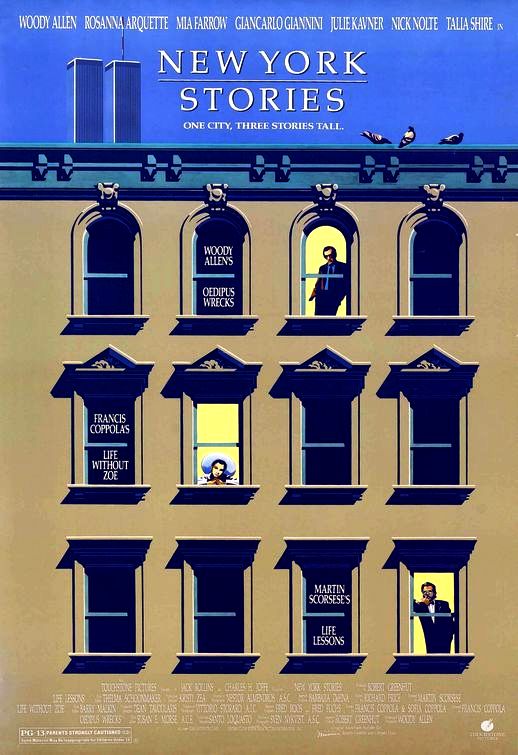
KOYAANISQATSI

Hopi Indian translation: “Life Out of Balance”
For those of you lucky enough to have experienced Ron Fricke’s “Samsara” so far it might interest you to [re]discover the first film of its kind, Koyaanisqatsi (1983). Godfrey Reggio’s trailblazer of wordless socio-geopolitical documentary was the first of a trilogy that also included the equally wondrous “Powaqqatsi” (1988) and the sadly disappointing “Naqoyqatsi” (2002), which relied on media archives gimmicks. The world’s complexity and diversity is largely on display in this first triumph which features an abundance of dazzling and accelerated scenes of modern technology on hyperspeed.
 Usage of anamorphic wide lenses, time-lapse photography, and multi-split images contributes to the film’s escalating power. The argument against the technique is that the coolness factor gets in the way of the message against globalization. We’re all smart enough to cut apart the ideas and figure that out on our own, I say. The film is an entertaining rush of free association images and ideas.
Usage of anamorphic wide lenses, time-lapse photography, and multi-split images contributes to the film’s escalating power. The argument against the technique is that the coolness factor gets in the way of the message against globalization. We’re all smart enough to cut apart the ideas and figure that out on our own, I say. The film is an entertaining rush of free association images and ideas.
Having served as cinematographer and conceptual writer, Fricke continued on to make his own films including “Chronos” (1985); “Baraka” (1992) and the current “Samsara.” So which one is best? I was ready to say that I can’t possibly choose a favorite, that  even in their similar techniques they contain their own special qualities. But “Samsara,” shot in high-resolution 70mm, is the best-looking in its sharpness, and frankly, covers more square ground of the Earth, has more exotic peoples with a thorough examination of idiosyncratic traditions of other-worldly cultures.
even in their similar techniques they contain their own special qualities. But “Samsara,” shot in high-resolution 70mm, is the best-looking in its sharpness, and frankly, covers more square ground of the Earth, has more exotic peoples with a thorough examination of idiosyncratic traditions of other-worldly cultures.
But really, they should all be enjoyed, every title mentioned here. For cinephiles out there, yes, you could argue that “The Man with the Movie Camera” (1929, Russia) and “L’Age D’or” (1930, France) can be viewed as inspirational predecessors to the wordless socio-geopolitical documentary form. Grade: A
87 Minutes. Unrated.
Film Cousins: “The Man with the Movie Camera” (1929, Russia); “L’Age D’or” (1930, France); “Powaqqatsi” (1988); “Baraka” (1992).
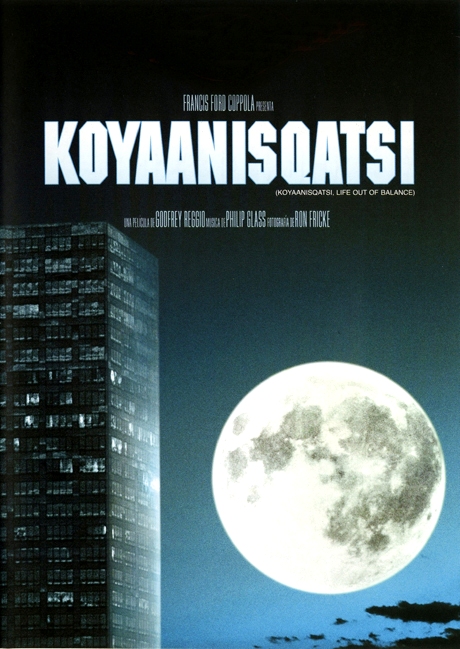
THE UNTOUCHABLES

“Isn’t that just like a wop. Brings a knife to a gun fight.” – Malone
Big, rouble-rousing, even unashamedly corny. The Untouchables (1987) is broad and showy, known most for its expensive retro-design of Prohibition Chicago. Cops and robbers fight dirty, the bootleggers execute dissenters and blow-up businesses, but otherwise – this is an immaculately spick and span city, a kind of vogue metropolitan city. Kevin Costner is the straight-arrow Eliot Ness; Sean Connery (in a deserved Oscar-winning role) is an Irish-American cop with wiseacre chops; Andy Garcia is a sharpshooter; Charles Martin Smith is a deskman who comes up with the idea to nail gangster Al Capone (Robert DeNiro) for income tax evasion.
The first absurdity is watching Capone speak in hammy soliloquies, some of them not making sense even if you slowed down the movie and read the subtitles. DeNiro plays Capone as a capricious fat king with minions fetching everything for him. He lives in a hotel and appears to be all his, with no other guests. At the end of a monologue about “Enthusiasms” he takes a baseball bat to the head of one of his subordinates. The script is credited to David Mamet who has written more grown-up stuff; this time, it feels the only time he’s written a script at a junior high school level.
How sensational though are Brian DePalma’s set pieces, like the Union Station staircase sequence with a baby stroller rolling down uncontrollably while men on opposite sides exchange gunfire – this is inspired from a scene in the 1925 Russian film “Battleship Potemkin.” The raid at the Canadian border has multiple gung-ho moments. And Ness chases after Nitti (Billy Dragon) on courthouse rooftops. All of this action stuff is lifted up by Ennio Morricone’s exuberant, swirling score – perfect match to the hop and flow of DePalma’s visuals.
Look at this after you stumble through the new “Lawless” Prohibition movie and you will see there is no comparison. That one, so geriatric. Versus this one, so corny but flamboyant. And the biggest difference is that “Untouchables” has magnificent sets while the current “Lawless” takes place in non-descript forest towns with nothing interesting to look at. You may wish that it had more hardnosed facts, but you’re never humbug with “Untouchables.” Grade: B
119 Minutes. Rated R.
VIOLENT DRAMA / MALE AGGRESSION PANDEMONIUM / WEEKEND THRILLS
Film Cousins: “The Public Enemy” (1931); “Scarface” (1932); “Public Enemies” (2009). “Lawless” (2012).
UNSTOPPABLE
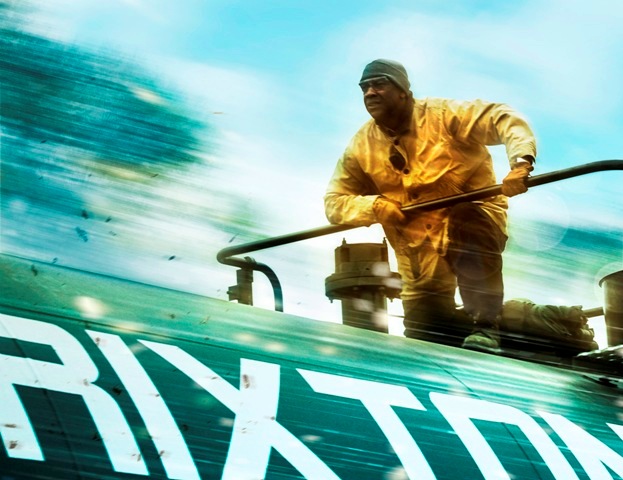
Disaster and wreckage fans will dig it most. Unstoppable (2010) is a man versus machine action movie grounded in reality, depicting an unmanned full-throttle train with no brakes. Denzel Washington (“Book of Eli”) and Chris Pine (“Bottle Shock”) are railroad men whom must stop the train before it crosses a dangerous elevated S- curve in Stanton, Pennsylvania. If it hits the curve, the speeding 39-car train carrying highly flammable toxic material will crash and doom the town’s 700,000 population. This is the best movie Tony Scott ever made in a career that also included “Enemy of the State” (1998), “Crimson Tide” (1995) and “True Romance” (1993).
 [Over] discerning movie fans will find that some particular exposition is genre cheeseball, but if you can laugh at it all and still get psyched over the next wave of juggernaut excitement, the results can be hella fun. This isn’t just a train. “We’re talking about a missile the size of the Chrysler building,” Connie Hooper (Rosario Dawson) says at dispatch.
[Over] discerning movie fans will find that some particular exposition is genre cheeseball, but if you can laugh at it all and still get psyched over the next wave of juggernaut excitement, the results can be hella fun. This isn’t just a train. “We’re talking about a missile the size of the Chrysler building,” Connie Hooper (Rosario Dawson) says at dispatch.
Frank Barnes (Washington) is the veteran engineer with three decades of experience under his belt. He isn’t running a daycare center. Will Colson (Pine) is the new conductor who was able to slide his way into the job byway of nepotism. Will doesn’t like working at a retirement home. They have their differences. Naturally, friction occurs between man of experience and man of inexperience. Each of them undergoing negligible family problems at home.
The alternative ways of commandeering, blockading and hindering the full throttle locomotive lends plenty of danger. Quick solutions are needed to stop the train before it collides head-on with a commuter train full of school children and other prospective casualties. As the worst of disasters becomes imminent, it seems that Barnes and Colson become the last line of defense. Barnes and Colson run their analog train backwards so they can latch onto the runaway train, a feat of tug–of-war.
 Scott lends the torrent of images a suitable velocity without over editing or over cranking his cameras. Heaps of the action is captured by a helicopter news camera that provides us with cohesive overhead images giving the story mechanics some objective credibility. This was the final movie made by Scott, and the fifth one where he collaborated with star Denzel. Grade: B+
Scott lends the torrent of images a suitable velocity without over editing or over cranking his cameras. Heaps of the action is captured by a helicopter news camera that provides us with cohesive overhead images giving the story mechanics some objective credibility. This was the final movie made by Scott, and the fifth one where he collaborated with star Denzel. Grade: B+
Note: Scott, 68, died this past weekend (8/18/12) when he jumped off a harbor bridge in San Pedro, California after learning he had inoperable brain cancer. He is survived by his brother Ridley Scott, director of “Prometheus” and “Gladiator.”
98 Minutes. Rated PG-13.
ACTION & ADVENTURE / RACE AGAINST THE CLOCK THRILLER / WEEKEND THRILLS
Film Cousins: “The General” (1926); “Silver Streak” (1976); “Runaway Train” (1985); “Under Siege 2: Dark Territory” (1995).
STRANGER THAN FICTION

“No, no. It’s not schizophrenia. It’s just a voice in my head.” – Harold Crick
Funnyman Will Ferrell temporarily grew up for Stranger than Fiction (2006), a comedy-drama, or sophisticated comedy before he regressed again to ubiquitous potty-mouth roles. This is one of those ingenious concept fantasies about a man who awakens one morning to find that his life is being narrated by a far-off voice that he can’t explain. Emma Thompson supplies the voice, and little do we know if she is an angel from above, or someone just like us. She is revealed as living novelist Karen Eiffel.
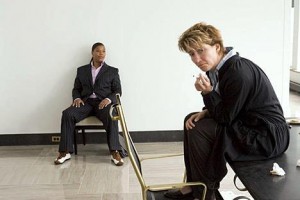 Harold Crick is haunted that everything he does is mirrored word for word by Thompson’s narration. It becomes particularly vexing when Thompson’s voiceover forecasts Crick’s impending death that could come anytime soon.
Harold Crick is haunted that everything he does is mirrored word for word by Thompson’s narration. It becomes particularly vexing when Thompson’s voiceover forecasts Crick’s impending death that could come anytime soon.
The crucial character flaw of Crick is that he is a painfully dull IRS man that plans out every daily activity to the precise minute, succinctly a routine-guy that never breaks his monotonous lifestyle. Perhaps Dustin Hoffman, as a literary scholar can help uncover the mysterious origin of the voices can break Crick out of his shell. Or perhaps Maggie Gyllenhaal (“Secretary”), a carefree pastry shop owner whom is to be audited by Crick can make him into a happier man.
This is fun and inventive. The voices in Crick’s head is what is driving him batty, it is what is catapulting him towards irrational behavior that is alien to him. It’s also really what is driving the film. When the film takes a lower-gear to normal mode – putting Crick’s character to the test of interpersonal relationships minus the voice-over narration – everything about “Stranger than Fiction” becomes too ordinary.
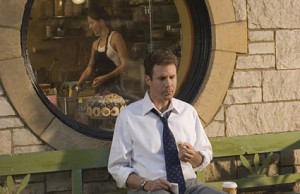 Director Marc Forster (“Monster’s Ball,” “Finding Neverland”) has a real knack in pleasantly blending fantasy into realistic settings. And his film is crisply shot too – we feel immersed into Crick’s everyday hygienic world. The movie that Forster has made is clever and mildly appealing, yet the mild quotient informs us that the movie is playing it too safe. “Being John Malkovich” is an example of a movie that kept escalating the twists the further along it went. If “Stranger than Fiction” misses out on classic status, at least it has become a watchable and pleasant effort.
Director Marc Forster (“Monster’s Ball,” “Finding Neverland”) has a real knack in pleasantly blending fantasy into realistic settings. And his film is crisply shot too – we feel immersed into Crick’s everyday hygienic world. The movie that Forster has made is clever and mildly appealing, yet the mild quotient informs us that the movie is playing it too safe. “Being John Malkovich” is an example of a movie that kept escalating the twists the further along it went. If “Stranger than Fiction” misses out on classic status, at least it has become a watchable and pleasant effort.
As for Ferrell? It was a low decibel performance that disarmed some audiences waiting for him to break out into wild and antic mode. He deserved credit to sticking to his meek and socially inept character who evolved into a lovable crumpet of a man. I wish we had more of this from Ferrell instead of the one-note mouth pooper he’s become. Queen Latifah and Tom Hulce also have meaningful supporting roles. Grade: B
113 Minutes. Rated PG-13.
Film Cousins: “Harvey” (1948); “Being John Malkovich” (1999); “Synedoche, New York” (2008); “Ruby Sparks” (2012).

BAD LIEUTENANT

“I’m sorry, Lord. I’ve done so many bad things.” – Lieutenant
When is NC-17 necessary and why is it used at all? Bad Lieutenant (1992), with extreme adult material, was one of the first NC-17 movies that matters. Harvey Keitel, in a hellbent tour of self-destruction, plays a very lousy and immoral human being who uses his NYPD badge to commit reprehensible acts. He is high on cocaine or mellowed on heroin, which he either steals from crime scenes or trades with corner hustlers. He is into degraded sex. He gambles on the L.A. Dodgers to beat the New York Mets coast series with double-down recklessness. His married life no longer means anything to him. The sooner he drops his boys off at school the faster he can snort his morning coke. Following all this character detail, he is then placed as head investigator of the rape of a nun. In an interview session, the nun forgives her attackers. The lieutenant does not comprehend this kind of forgiveness, this kind of absolution. Even if he has been to Church.
Keitel went through his own gilded age with one head-turning, gritty indie performance after another in “Reservoir Dogs” (1992), “The Piano” (1993); “Pulp Fiction” (1994), “Imaginary Crimes” (1994), “Smoke” (1995). Without a doubt, “Bad Lieutenant” is the most powerful of all his performances. He has the improbable but persuasive scene at the 42-minute mark where, out of rage, he pulls out a gun in his own car and blows a hole through his radio when the Dodgers lose. That’s a frenzied, the-man-has-lost-it sight that has to be seen to believe. And can’t be seen anywhere else.

The loss of Catholic faith is a theme that has been compared to the cinema of Scorsese, and the notions of moral lines and religious guilt can be compared to “Raging Bull” (1980) and “GoodFellas” (1990). The “Bad Lieutenant” filmmaker is Abel Ferrara, who even in his exploitation days made art before box office product. Ferrara shot his 1992 magnum opus “Lieutenant” in raw, blotchy colors and with shabby, semi-disoriented camera movement. I believe Ferrara made this film for his own personal demented reasons – to lash out the frustrations of the ferocious urban man ready to die through over-indulgence of his own vices – and not to particularly “copy” Scorsese. The comparisons are legitimate but are not self-conscious and shouldn’t be mistaken so.
You can’t get this kind of material in regular movies. Nor, do I believe, should it be spoon fed for mass consumption. I’m glad most kids don’t need this film, and that it is barred in its own special category of NC-17 and that it is “exclusive.” Some viewers of adult age might find this film too high stress.
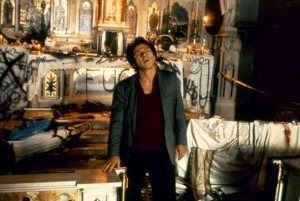 But the young adults who grew up with raging fathers, under the shroud of alcoholism or drug abuse in their house, can pluck deep meaning from this film, and therefore transcend it. Or perhaps you’ve lived such a coddled safe life that you hunger to know how the sleazy inner-city addicts live to us in contrast. It is with films like “Bad Lieutenant” where we come to understand uncontrollable, horrible men – and their pitiable efforts to salvage some last shred of humanity in their twilight hours. For Keitel’s Lieutenant, it’s to not avenge the nun’s rapists but to ingrain fear into these assailants so they will never commit sin again. Grade: A-
But the young adults who grew up with raging fathers, under the shroud of alcoholism or drug abuse in their house, can pluck deep meaning from this film, and therefore transcend it. Or perhaps you’ve lived such a coddled safe life that you hunger to know how the sleazy inner-city addicts live to us in contrast. It is with films like “Bad Lieutenant” where we come to understand uncontrollable, horrible men – and their pitiable efforts to salvage some last shred of humanity in their twilight hours. For Keitel’s Lieutenant, it’s to not avenge the nun’s rapists but to ingrain fear into these assailants so they will never commit sin again. Grade: A-
Note: This past weekend opening of “Killer Joe,” directed by William Friedkin and starring Matthew McConaughey, is the latest NC-17 film to take advantage of harrowingly artistic and thematically unhinged material.
96 Minutes. Rated NC-17.
Film Cousins: “Henry: Portrait of a Serial Killer” (1990); “Requiem for a Dream” (2000); “Bad Lieutenant: Port of Call – New Orleans” (2009); “Rampart” (2012).

BUS 174

“They do it because we fail to deal with social exclusion, racism, and other kinds of stigmatization.” – Sociologist Luis Eduardo Soares
Disenfranchised, neglected, the forgotten. The documentary Bus 174 (2004) is a glimpse into a life so devalued, that of Sandro do Nascimento, that he jumped onto a bus in Rio de Janeiro with the intent to rob the occupants, eventually took the passengers hostage as the pressure escalated, and instigated a crisis that was filmed on television and ended in horror. The television cameras aggravated the inevitable tragedy. The fated 22-year old acted violently for the cameras. He wanted to put on a show, it made him feel powerful knowing the TV cameras were protecting him. “He had nothing to lose,” the hostages recalled.
We get plenty of appropriate volunteers in the police department, SWAT, social workers, homeless denizens, and jailers to comment in retrospect. I will not be coy about it however. Sociologist Luis Eduardo Soares is the best interviewee in the film. “There are two ways of producing social invisibility. One can be made invisible if his presence is neglected. And one can be made invisible if we cast a stigma over him, replacing his singularity with our prejudices,” Soares says, “We only see what we project, and not who they really are.”
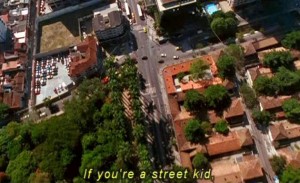

From an early age, Sandro learned to hustle. He was a street urchin who witnessed boys and girls his age beaten by police, neglected by an unkind civil system that knocked down their progress, and tossed them away as outcasts. Sandro has a social worker, an aunt, and an adopted mother who speak on his behalf in the film. He would appear like a nut with a gun when we see the live footage of the TV news start the film. But according to his sympathizers, Sandro had optimistic dreams that would have been constructive to society, but opportunities failed him. Sandro was wrong to sniff glue and snort coke that would take him off course. And true, he was likely very high the day of the hostage crisis – an inevitable end to a short, hopeless life.
“The boy exchanges his future, his life, his soul, for an ephemeral and fiery moment of glory,” Eduardo explains, continuing, “The small glory of being acknowledged, valued, of praising his self-confidence.”
Sandro was probably a good kid at some point, hungry for recognition, but only had chance of good progress through six years old, until his mom was butchered in front of him. Subsequently he became a street kid to survive. And years later, he was handicapped by narrowed options.
 Police came, he knew he was doomed. He had been to jail before, which in Rio are not like our American jails but are instead abysmal dungeons. Thirty at a time locked into one cell, inmates toppling each other, sleeping on hard floors, rotten food and dirty water consumed, temperatures beyond 100-degree Fahrenheit (Yes, you get the visuals). No, Sandro was never going to go back there. What happened on Bus 174 is at once an inexorable tragedy and yet a fated gestation on social malfunction, and the hypocrisy of the higher social classes shunning the dwellers of the lower depths without extending graces to understand them. Grade: A-
Police came, he knew he was doomed. He had been to jail before, which in Rio are not like our American jails but are instead abysmal dungeons. Thirty at a time locked into one cell, inmates toppling each other, sleeping on hard floors, rotten food and dirty water consumed, temperatures beyond 100-degree Fahrenheit (Yes, you get the visuals). No, Sandro was never going to go back there. What happened on Bus 174 is at once an inexorable tragedy and yet a fated gestation on social malfunction, and the hypocrisy of the higher social classes shunning the dwellers of the lower depths without extending graces to understand them. Grade: A-
120 Minutes. Rated R.
Film Cousins: “Dog Day Afternoon” (1975); “Pixote” (1981, Brazil); “City of God” (2002, Brazil); “Sin Nombre” (2009, Mexico).

U-TURN
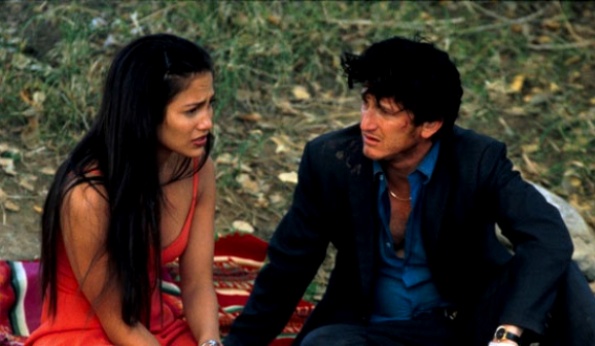
“A man who has no ethics is a free man.” – jealous husband Jake (Nick Nolte)
Oliver Stone’s trippy visual lark occupied with boneheads and lowlifes. U-Turn (1997, 125 Minutes, R) is kinda amusing as a no-way-out of hell, an artistic detour, featuring Sean Penn as a scuzzball named Bobby Cooper stuck in neutral while on his way to Las Vegas to pay-off debt to gangsters. Misfortunes begin when the radiator of his vintage red Mustang convertible blows in the hick town of Superior, Arizona. While waiting on the town mechanic (Billy Bob Thornton, the filthiest of rednecks), he gets entwined with a mocha-lips femme fatale (Jennifer Lopez) in a shoulder-strap orange dress. Jealous husband (Nick Nolte), a raging buck-toothed paranoid, naturally wants Bobby the drifter to kill his wife. There will be money.
This is a nightmare comedy melded in dirt, grease, sweat, bloodstains and Jon Voight’s mucous. Nothing is substantially important nor is there a political denunciation to be found – this was Stone’s ditty following the meaningful track record that included “Born on the 4th of July” (1989), “JFK” (1991), “Natural Born Killers” (1994) and “Nixon” (1995). His current flick “Savages” is both, a drive-in movie like this one and a statement about the drug war polemic.
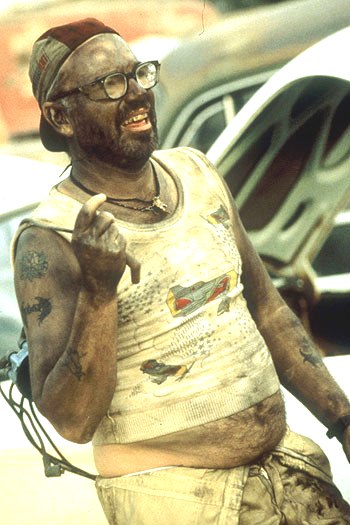 “U-Turn” is minor and inconsequential in retrospect, but it is a peek at what Stone’s black humor is like. His flick inextricably teeters on the annoying – the loud, gnarly, grating business of Murphy’s Law, i.e., nothing goes right for Bobby. For you to qualify for this, the sick, twisted honcho in you wants Bobby to jump through tedious hoops; somewhere the primitive within us finds that entertaining. You’re the type who thinks it’s funny when the s#*% hits the fan. You think vultures are interesting animals. Get it?
“U-Turn” is minor and inconsequential in retrospect, but it is a peek at what Stone’s black humor is like. His flick inextricably teeters on the annoying – the loud, gnarly, grating business of Murphy’s Law, i.e., nothing goes right for Bobby. For you to qualify for this, the sick, twisted honcho in you wants Bobby to jump through tedious hoops; somewhere the primitive within us finds that entertaining. You’re the type who thinks it’s funny when the s#*% hits the fan. You think vultures are interesting animals. Get it?
Writer John Ridley, who adapted from his book, provides the twists and turns while Stone applies his fiendish wild coyote sense of humor to each karmic debacle. Also on sight are Joaquin Phoenix, Powers Boothe, Claire Danes, Liv Tyler and Julie Haggerty as an assortment of weirdos. Grade: B-
125 Minutes. Rated R.
Film Cousins: “Detour” (1945); “Blood Simple” (1985); “Wild at Heart” (1990); “Red Rock West” (1994).

ALIEN
“In Space No One Can Hear You Scream”
One of the classics in shuddering claustrophobia scenarios with a monster on the loose. I implore you to see Alien (1979, 117 Minutes, R) before the new summer blockbuster “Prometheus” comes out, a prequel that will precede events of the Alien series. It’s dated in exactly two ways, and visionary and durable in limitless others. The original cast included Harry Dean Stanton, Ian Holm, John Hurt, Sigourney Weaver, Tom Skerritt, Veronica Cartwright and Yaphet Kotto. The director is Ridley Scott, who went on to make “Blade Runner” (1982), “Gladiator” (2000) and “Black Hawk Down” (2001). “Prometheus,” opening June 8th, will be his first return to directing an entry in the sci-fi saga since the original.
The computer screens with the green lettering is outdated – it would have been better if Scott never showed you any screens. The computers, with “Mother” as the operating and interactive hard drive, must have looked “futuristic” at the time. Also, the commercial spacecraft “Nostromo” has too many unnecessary buttons and thingamajigs on the walls that don’t look like they are used for anything.
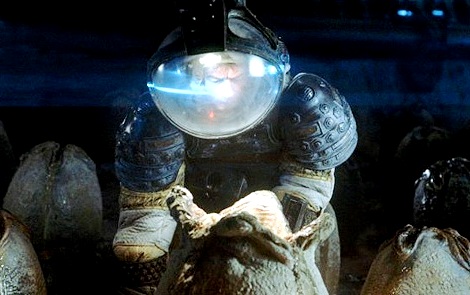 That’s it when it comes to gripes. Though I’m not sure that last one is even worth griping about. What I admire about Scott though is how he put in all this hardware in the background that mystifies us. He has placed a crew of refinery contractors in the middle of it, most of them bummed by their work conditions. They want to go back to Earth, but they are sidetracked to go survey a planet. We see a humongous cadaver of an alien lifeform – consider that it might have been a non-violent lifeform. There is an atmosphere of post-destruction, so we consider there must be a destructive, violent species in the vicinity. One crew member is lowered down a hatch and finds green mist layered on a field of ominous eggs. One of them hatches, then springs onto the crew member’s helmet and as a parasite eats through the helmet and attaches onto his face.
That’s it when it comes to gripes. Though I’m not sure that last one is even worth griping about. What I admire about Scott though is how he put in all this hardware in the background that mystifies us. He has placed a crew of refinery contractors in the middle of it, most of them bummed by their work conditions. They want to go back to Earth, but they are sidetracked to go survey a planet. We see a humongous cadaver of an alien lifeform – consider that it might have been a non-violent lifeform. There is an atmosphere of post-destruction, so we consider there must be a destructive, violent species in the vicinity. One crew member is lowered down a hatch and finds green mist layered on a field of ominous eggs. One of them hatches, then springs onto the crew member’s helmet and as a parasite eats through the helmet and attaches onto his face.
To bring the man with an attached crab-octopus thing onboard would be an act of breaking quarantine, according to Ripley (Weaver). Her orders are disregarded, and the injured man is brought aboard. Ash (Holm), the chief scientist officer, is intently curious about the circumstances and has plans to lock-box the creature so it can be returned to Earth for the merits of science and research. The crab-octopus thing sheds its skin and disappears to morph into something else. If you’ve never seen “Alien,” then I’m not going to tell you what happens next. I hope I whet your appetite by telling you that electric prods and flamethrowers are no match for it. The creature designer who worked on the film was H.R. Gigor whose self-proclaimed vocational title in life was “Swiss Surrealist.” It’s a perfect creature because it has an impervious defense mechanism to persist survival.
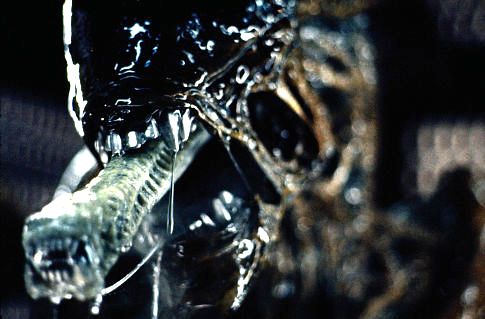 “Alien” continues to be timelessly effective because of the hysteria that Scott invokes. He does this by creating mood within the set decoration which is suffocating, cold and labyrinthian in form. He doesn’t cut his film up into jagged little pieces. Instead by allowing his long shots to breathe, the mood is able to envelop you like vapor. I think the movie is supercool to look at (watch it in the dark, with an icy drink in hand. Really, to maximize your enjoyment, just do it). It’s sweaty and dank at times, appropriate for this being a blue-collar expedition. The camera glides in a way that is both stirring and goosing – you start watching out for every turned corner.
“Alien” continues to be timelessly effective because of the hysteria that Scott invokes. He does this by creating mood within the set decoration which is suffocating, cold and labyrinthian in form. He doesn’t cut his film up into jagged little pieces. Instead by allowing his long shots to breathe, the mood is able to envelop you like vapor. I think the movie is supercool to look at (watch it in the dark, with an icy drink in hand. Really, to maximize your enjoyment, just do it). It’s sweaty and dank at times, appropriate for this being a blue-collar expedition. The camera glides in a way that is both stirring and goosing – you start watching out for every turned corner.
The genre is Horror, but it’s much more than horrifying. Once you’ve seen “Alien” a couple of times you become jaded that it’s no longer as horrifying. But it always remains interesting, because good sci-fi is interesting. For starters, the seven crew members don’t all love each other. You see the tolerance wear down as the stakes get more intense. Parker (Kotto), the jubilant black guy, is the most likeable of all the characters – he is the jester and peacemaker. He’s not afraid though to say though that the situation is bull****.
There’s the issue that the crew is being used for collateral damage by an Earth corporation that is willing to put human lives at risk in the name of space exploration. If the company cared more about these people, they would have supplied them with an interstellar spaceship that came with more of that cool leather padding on the walls in every room and corridor. On a good night, you can’t stop thinking about this stuff. There’s no escape really for anyone, since the crew is helplessly drifting out in the endless outreaches of the galaxy. Outer space is the ultimate abyss.
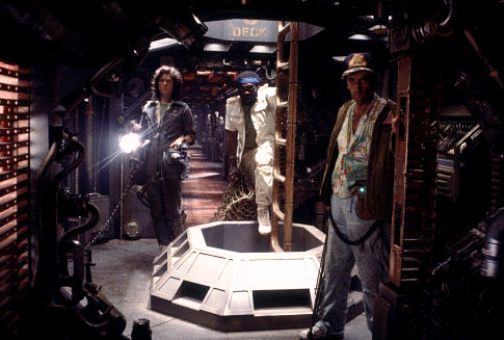
Scott’s box office smash – grossing $104 million in 1979 dollars – was followed by “Aliens” (1986), by director James Cameron, which abandoned the isolation and suspense approach in favor of action roller-coaster thrills, tops for its genre. Then came David Fincher’s “Alien 3” (1992) which I’d call an interesting misfire, it doesn’t add much to the series as it should have but it has some good things in it. “Alien: Resurrection” (1997) was a fiasco, a witless dead-end. “Prometheus” is a good fresh start. Grade: A
Film Cousins: “The Thing” (1982); “Aliens” (1986); “Alien 3” (1992); “Alien: Resurrection” (1997).

FLASH GORDON
“Did you like it? I fell asleep after we did it.”
“I’m not even sure what was going on.”
“In what way? There’s the bad guys and then there’s Flash.”
“I’m not sure what Flash Gordon really did. Other than crash his ship into the evil lair at the end.”
Flash Gordon (1980, 111 Minutes, PG) would be forgotten, or continued to be forgotten, if it weren’t for Seth MacFarlane’s ribald references to it in his movie “Ted” which opened this weekend. It is one of those expensive cheese-o-ramas that would go filed under worst movies ever or awesome bad movies, depending on who you are.
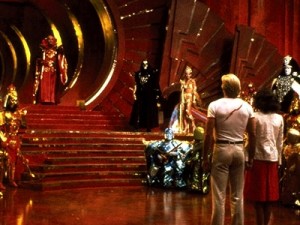 In this shameless comic book x-stasy, Earth gets showered by “hot hail” in the opening sequences, and it’s up to New York Jets quarterback Flash Gordon (Sam J. Jones), his babe (Melody Anderson), and a scientist (Topol) to fly through the galaxy and avenge the attacking alien planet. Freddie Mercury of the British rock band Queen not only sings the cover tune, but composed most of the music. The lavish set design is so outrageously gaudy it makes Oliver Stone’s “Alexander” and Tarsem Singh’s “Immortals” look tame in comparison.
In this shameless comic book x-stasy, Earth gets showered by “hot hail” in the opening sequences, and it’s up to New York Jets quarterback Flash Gordon (Sam J. Jones), his babe (Melody Anderson), and a scientist (Topol) to fly through the galaxy and avenge the attacking alien planet. Freddie Mercury of the British rock band Queen not only sings the cover tune, but composed most of the music. The lavish set design is so outrageously gaudy it makes Oliver Stone’s “Alexander” and Tarsem Singh’s “Immortals” look tame in comparison.
There isn’t a better mindless movie to watch on a mind-putty night. I was exhausted after a day of other movies, driving parents around (yea, I’m editorializing personal stuff here), a long cardio walk with the wife, an epic dinner, tweeting, popping foot blisters. We wrapped up some ice packs in a blankie to cool the summer heat, put on “Flash Gordon” in the bedroom, not my living room surround-sound theater, and plunked back on six cushy pillows and my teddy bear. My head was as blank as a one-year old this day. All for the better.
On the alien planet Mongo, where Emperor Ming (Max von Sydow) uses molecule-disintegrating laser guns on his enemies, Flash gets into an immediate football mode by breaking henchmen’s faces with a round green ball. I have no idea why Flash is executed twice, but a goddess, a.k.a. Princess Aura (Ornella Muti), gives him the resurrecting kiss of life. Once resuscitated, Flash gets the gift of telepathy 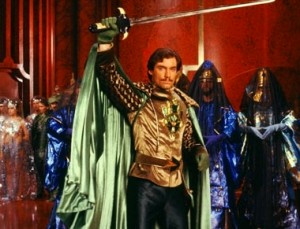 (he hardly uses it) and engages alliances with another jungle men resistance group led by Prince Baron (Timothy Dalton, very wooden). While some men have wings, Flash eventually gets a hovering jet ski that dodges the castle’s multi-rotor laser guns that shoots off in un-tangential directions.
(he hardly uses it) and engages alliances with another jungle men resistance group led by Prince Baron (Timothy Dalton, very wooden). While some men have wings, Flash eventually gets a hovering jet ski that dodges the castle’s multi-rotor laser guns that shoots off in un-tangential directions.
Geez, “Family Guy’s” Seth MacFarlane could make fun of this all day. In a loving way. If his power clout increases, he should do a remake, something like “Flash Gordon: The Queen Rock Opera” or “Flash Gordon: Attack of the Clones.” Please don’t turn this camp classic off until you get to the ending. Grade: C+
93 Minutes. Rated PG.
Film Cousins: “Barbarella” (1968); “Super Inframan” (1975, China); “Logan’s Run” (1976); “Ted” (2012).
ELLA ENCHANTED
Anne Hathaway, with her beaming eyes and long locks, has the perfect looks for a princess fantasy, and you know what? She made one, it just got terribly overlooked. Ella Enchanted (2004) is Hathaway’s chance to play radiant and adorable, aww, her chance to play Cinderella. In a genial Medieval Times kingdom that’s kid-friendly enough, Hathaway is impeded with a spell of obedience given to her by a fairy godmother at birth. Throughout any adventure in her life, whenever someone tell her something that sounds like a command, Ella obeys with bodily compulsion, voilá a clang on the soundtrack. Vivica A. Fox is the mischievous fairy godmother too stubborn to lift the curse.
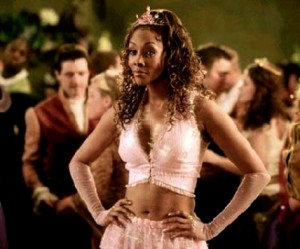 Many families, or more specifically mothers and daughters, likely enjoyed “Brave” this past weekend. That’s good, and they can likely enjoy another good time with this silly cup of tea. While Merida the Scottish princess found no interest in men of any age, Ella stubbornly admits to a crush, the dashing bachelor Prince Charmont (Hugh Dancy, British accent). The Prince, and all the other boys, are easier to tame than the snotty girl competition in this fantasy.
Many families, or more specifically mothers and daughters, likely enjoyed “Brave” this past weekend. That’s good, and they can likely enjoy another good time with this silly cup of tea. While Merida the Scottish princess found no interest in men of any age, Ella stubbornly admits to a crush, the dashing bachelor Prince Charmont (Hugh Dancy, British accent). The Prince, and all the other boys, are easier to tame than the snotty girl competition in this fantasy.
Take for instance Hatie and Olive (Lucy Punch and Jennifer Higham). These two are impending step-sisters who exploit Ella’s inducement to obedience, the kind to make her slap herself and stand on one leg (Yes, mild family movie stuff). Ella’s a good girl, for all she wants is to be a volunteer humanitarian on behalf of ogres and elves, the deemed social outcasts. That, and stop her father Sir Peter (Patrick Bergin) from re-marrying unwisely and bringing in these snotty pests into their family.
 Sometimes the curse works to better purpose. “Stay right there,” the Prince says, and so Ella does. Ella gets caught up in the adventures of a Prince who will never let her go, and while she uses that time to convince the Prince that he needs to change social order when he becomes King, she to her own surprise falls in love with him. But the evil Prince Regent Edgar (Cary Elwes) and his CGI snake Heston whom together are treacherous in their scheme to overthrow the kingdom and destroy Ella’s mainspring valiant love.
Sometimes the curse works to better purpose. “Stay right there,” the Prince says, and so Ella does. Ella gets caught up in the adventures of a Prince who will never let her go, and while she uses that time to convince the Prince that he needs to change social order when he becomes King, she to her own surprise falls in love with him. But the evil Prince Regent Edgar (Cary Elwes) and his CGI snake Heston whom together are treacherous in their scheme to overthrow the kingdom and destroy Ella’s mainspring valiant love.
All of this works in the tradition of “The Wizard of Oz,” and although it is not near that standard of greatness, it is a likeable and happy entertainment that exclaims the righteousness of girl power. Knowingly pop-referential, Hathaway gets to show off his singing and dancing gifts with “Somebody to Love,” and the more impressive finale “Don’t Go Breaking My Heart” which is a fabulous Bollywood number which comprises the entire robust and cheerful cast. Grade: B
96 Minutes. Rated PG.
Film Cousins: “The Wizard of Oz” (1939); “The Princess Bride” (1987); “Shrek” (2001); “Enchanted” (2007).
SWIMMING WITH SHARKS
“Shut Up, Listen and Learn.”
It’s been 15 years since I first laid eyes on Swimming with Sharks (1995), the Hollywood satire about an abusive executive and his lackey assistant. What I never forgot – nor most any indie cinephiles have neither – was Kevin Spacey’s performance as Buddy Ackerman who is nobody’s buddy. “You’re nothing! If you were in my toilet I wouldn’t bother flushing it. My bathmat means more than you!” This became a curious revisit after the release of the new “Horrible Bosses” which undoubtedly recalls Spacey reprising the same performance.
Revisiting it was a disillusionment, it was outdated. The story outline is gimmicky with Frank Whaley pointing a gun at boss Spacey after invading his home, first strapping him to a chair and then hastily torturing him – these segments are interrupted as it flashbacks to events of Whaley getting stomped on by Spacey in the past year.
“Swimming with Sharks” isn’t necessarily a bad movie, because you’re glued to the episodes of the boss treating his assistant like a cockroach and scenes of other cutthroat movie biz at play. In other words, every time Spacey gets to volcanically blow steam it’s nastily appealing. But everything else about it is kind of annoying, including Whaley’s would-be sizzle with a producer played by the tart Michelle Forbes and the ceaseless optimistic promises of the gullible Whaley believing he will be promoted after he earns his way through slave work.
The idea of a lowly employee tying his boss to a chair and making him talk is an exhausted cliché, and this movie plays it out to even worse effect. These scenes are accompanied by a caustic and shrill music score that telegraphs yuppie thriller! Buddy talks and reveals the vulnerability within and has a sad-sack story to boot, which is over-the-top. But the revenge stuff has a despondent pulse (in other words, zero pulse) that doesn’t meld with the bitchin’ and bitin’ black comedy stuff and the result is a movie that is a disproportionate hodgepodge. Kevin Spacey is what makes it worth watching, but if Spacey wasn’t in it the movie it wouldn’t have been worth watching.
 With hindsight, I definitely prefer “Horrible Bosses” (pic right) with its pop commercialism infused with a zany edge. I am thankful for Kevin Spacey setting the groundwork with “Swimming with Sharks” which paved him a career for playing pompous honchos with a scathing sarcasm. Buddy Ackerman might be the original horrible boss, but Spacey over time got better scripts and therefore better mileage out of maltreating his inferiors, e.g., “Horrible Bosses.” Reprise, yeah maybe. But cooler movie. Swimming with Sharks: B-. Horrible Bosses: B.
With hindsight, I definitely prefer “Horrible Bosses” (pic right) with its pop commercialism infused with a zany edge. I am thankful for Kevin Spacey setting the groundwork with “Swimming with Sharks” which paved him a career for playing pompous honchos with a scathing sarcasm. Buddy Ackerman might be the original horrible boss, but Spacey over time got better scripts and therefore better mileage out of maltreating his inferiors, e.g., “Horrible Bosses.” Reprise, yeah maybe. But cooler movie. Swimming with Sharks: B-. Horrible Bosses: B.
101 Minutes. Rated R.
Film Cousins: “A Shock to the System” (1990); “The Player” (1992); “Office Space” (1999); “Secretary” (2002).
DEAD RINGERS
Currently lauded for “A Dangerous Method” about the professional breakthrough years of Sigmund Freud and Carl Jung, the reputable David Cronenberg is without doubt one of the great filmmakers. Nevertheless he started out with making horror films about attacking bugs, zombie feastfests and the awesomeness of telekinetic powers. Yet even when he made the great gross-out “The Fly” (1986) it had this rich sexual paradigm that bespoke of the pleasurable highs of carnal degradation. Dead Ringers (1998) is really though his first out-and-out film about sexual dysfunction, a twisted film where Jeremy Irons plays twin gynecologists with depraved tastes.
It’s a cold, cerebral horror film – an unorthodox description, I know. Irons is amazing in a dual role where the twins he plays act nearly alike, with one slightly more dominant than the other. How he subtly varies his nuances so you can tell Elliot and Bev apart is a high wire feat in acting. Genevieve Bujold plays TV actress Claire Niveau, a woman who is shared sexy-kinky by both brothers without knowing it, embarrassingly stumbling onto the truth.
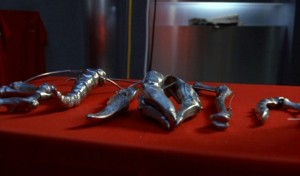 With a sleek metallic design, the Mantle twins occupy a state-of-the-art gynecology facility that assists to enable infertile women to conceive. The glossy perfection of their work stations contrasts with their messy personal lives. Together, they are proud misogynists (They like the words “Mutant Woman”). Bev however would never get laid without his brother’s help, so Elliot routinely warms them up. Bev is then supposed to go “act” like his brother on a subsequent date.
With a sleek metallic design, the Mantle twins occupy a state-of-the-art gynecology facility that assists to enable infertile women to conceive. The glossy perfection of their work stations contrasts with their messy personal lives. Together, they are proud misogynists (They like the words “Mutant Woman”). Bev however would never get laid without his brother’s help, so Elliot routinely warms them up. Bev is then supposed to go “act” like his brother on a subsequent date.
Elliot and Bev have done this before, but never has Bev been so swept away by a woman before. The new woman Claire is a woman of taste, intelligence, and yes, kinkiness (observe the rubber hose bondage scene). She also introduces Bev to her drug habit which includes tranquilizers and speed. The habit destroys Bev’s work ethic, calling for Elliot to take over the majority of occupational duties. The absence of Claire plays an important significance: for once, Bev is too lonely to cope and yet out of first-time antipathy rejects his brother.
They say that twins share something second nature with each other, they share not only an empathy for each other’s well-being but instinct enmeshed moods. Elliot’s plan to help his brother is to temporarily get hooked on drugs as well, so they can share the recovery and withdrawals together. The symbiosis is too powerful, however, and one’s downwards spiral begets the brother’s.
“Dead Ringers” is not a normal movie, but as a Cronenberg fan this was a dark pleasure to revisit. Its coldness is unprecedented, and cannot be sought for uplift or conventional excitement. I endlessly admired Irons, and as an exploit of tomfoolery, sometimes you don’t know if the woman in question is attended to by Elliot or Bev. You must figure it out by your own inspection! But really, it’s squirmy and rather hideous. Watch it with cold fascination. B
116 Minutes. Rated R.
TWISTED DRAMA / ADULT ORIENTATION / SATURDAY NIGHT GOOSEBUMPS
Film Cousins: “Sisters” (1973); “M. Butterfly” (1992); “Crash” (1996); “Twin Falls Idaho” (1999).
LE FILS
Serious patience required. So artsy in its naturalism it’s grueling, but not only is this particular film worthwhile, it’s worth getting acquainted with all of the Dardenne Brothers’ work. Their entire film of Le Fils (2002, France, also known as “The Son”) has the camera in medium shot within three feet or so of Olivier (Olivier Gourmet), a Belgian who teaches carpentry to young apprentices at a community center. He tells a social worker that he doesn’t have room to take on another student, and so the new kid is rejected. Then he sees the new kid, Francis (Morgan Marinee), and insists now in granting him entry. He obsessively watches Francis’ behavior around the center, often stalking from behind. This is odd because we know that Olivier is a good man with some unknown heartache, who conducts himself with patience and goodwill towards all, who takes his job seriously… and hasn’t thought about hurting anyone for a long time.
(SPOILER ALERT) In fact, he has only thought perhaps of hurting one person for a long time – out of anger, out of an unforgiving heart. That person he has thought about hurting is the boy that strangled his own son to death five years ago. That boy is Francis. Reasonably, Francis does not know that Oliver is the father of the boy he killed years ago. He has just spent five years in juvenile delinquent lock-up.
Olivier, a willowy figure with bumps and bruises, bespectacled, going bald, isn’t the most attractive man. One afternoon, he has a fairly attractive woman over. You wonder what is the nature of their business. It turns out she was his ex-wife. He must have been a happier man at one point, and by stretching that possibility, you might see how they were once married. They exchange some pleasantries, but he lets her go. He doesn’t have the heart just yet to tell her of the horrible coincidence of Francis coming into his life. She will find out later and respond with aghast.
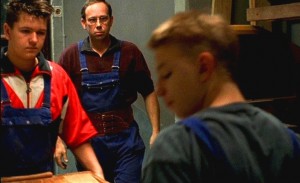 You gather that the nature of the movie is not quick to tell all, that it sticks to the ordinary and mundane, to make us watch with observance of Oliver and Francis and allow the motivations and thoughts behind the characters gradually, naturally unveil themselves. Olivier welcomes the boy to join him on a Sunday visit to the lumberyard, just the two of them. Francis can learn special tricks of the trade in this exclusive teacher/pupil outing. The suspense of the movie is wondering whether Olivier’s intentions are of malice or of goodwill. Francis naively discloses that he is in such bad needing of a mentor, a father figure, that he asks Olivier if he would be his adopting parent.
You gather that the nature of the movie is not quick to tell all, that it sticks to the ordinary and mundane, to make us watch with observance of Oliver and Francis and allow the motivations and thoughts behind the characters gradually, naturally unveil themselves. Olivier welcomes the boy to join him on a Sunday visit to the lumberyard, just the two of them. Francis can learn special tricks of the trade in this exclusive teacher/pupil outing. The suspense of the movie is wondering whether Olivier’s intentions are of malice or of goodwill. Francis naively discloses that he is in such bad needing of a mentor, a father figure, that he asks Olivier if he would be his adopting parent.
This is incredulous to Olivier, who fumes, but uses this as a chance to probe the boy with questions so he can get to the heart and soul of this kid who ruined his life years ago. As the drive to the lumberyard continues, the unassuming inquiry continues. Everything is unfolded in as approximate to “real time” as possible, with few jump cuts. Olivier, fumbling about with words, gets to a moment to ask the boy if he’s sorry about what he’s done.
The Dardennes always direct their films with a quasi-documentary verité style. If their films are indeed grueling, it’s only because they require undivided attention to follow the brisk nuances. B+
103 Minutes. Unrated.
Film Cousins: “The 400 Blows” (1959, France); “Rosetta” (1999, France); “L’Enfant” (2005, France); “The Kid with a Bike” (2011, France).
JACK’S BACK
Devious mystery smartly told. Jack’s Back (1988) is an early James Spader starrer in a Jack the Ripper horror update. In contemporary Los Angeles, a serial killer imitates murders that took place one hundred years earlier. Flourishes of atmosphere and clever, instinctual writing pushes this flick above the usual pedigree. I admit, that after the 25 minute mark it started to lose me, but a whopping new twist comes into play that is a real head-turner. I was hooked from that point on.
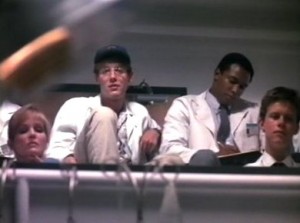 We meet Spader as John Westford, a public physician at an L.A. clinic. He has an attached interest in a prostitute he knew growing up, and he is chagrined when she is turned away by his own clinic administrator. On the news reports, the police are expecting a fifth murder by the end of the night. The cops are racing against the clock, and all John has to do is stay out of trouble. James Spader also plays Rick Westford, whose tell-apart physical distinction is a scar under his right eye.
We meet Spader as John Westford, a public physician at an L.A. clinic. He has an attached interest in a prostitute he knew growing up, and he is chagrined when she is turned away by his own clinic administrator. On the news reports, the police are expecting a fifth murder by the end of the night. The cops are racing against the clock, and all John has to do is stay out of trouble. James Spader also plays Rick Westford, whose tell-apart physical distinction is a scar under his right eye.
John hollers to eyewitnesses to call the cops, goes running with blood all over him, and is last seen at his clinic after-dark. Rick has telepathic visions of the murder, urgently gets involved in the inquiry, and then becomes a suspect. He is let go by police, but is tailed by detectives indefinitely. Cynthia Gibb plays John’s co-worker and then ally to Rick. Most average movies would make this relationship into a case of 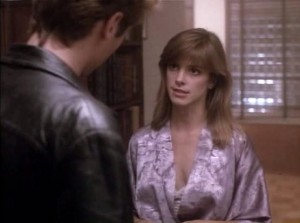 simple dressing (put in the film a sexy woman in distress!), but no, there is an interesting subtext going on here. Here’s a woman that was attracted to her colleague John, but now might find his brother Rick even more attractive in that dangerously alluring way (I mean he’s the dark side of James Spader, right?). She also has a convincing medical expertise that makes her very much a superior intelligence to match with Rick.
simple dressing (put in the film a sexy woman in distress!), but no, there is an interesting subtext going on here. Here’s a woman that was attracted to her colleague John, but now might find his brother Rick even more attractive in that dangerously alluring way (I mean he’s the dark side of James Spader, right?). She also has a convincing medical expertise that makes her very much a superior intelligence to match with Rick.
This is a real night owl’s movie. This is an L.A. street movie where the action, suspense and horror take place primarily after dark. Writer-director Rowdy Herrington puts in a faint, subtle fog in the nighttime scenes that give a tinge of extra peril. The melodrama is sometimes high melodrama. In other words, whatever clichéd stuff there is in the movie is done with a raucous, clamorous energy, i.e., high melodrama. But see it, at least, for the enigmatic layers of James Spader. He gave an underrated dual performance here. B+
97 Minutes. Rated R.
Film Cousins: “Pandora’s Box” (1929, Germany); “Time After Time” (1979); “Raising Cain” (1992); “From Hell” (2001).
BIG FISH
Big Fish (2003) is the last Tim Burton film that I can honestly say is magical. When I say “magical” to describe a movie, I’m not just talking about the technological gizmos employed to make fantastical elements come to life, I’m talking about the magical spell a good film can put on you to heighten your awareness and tickle you into high spirits. Ewan McGregor is also one of the nicest guys in the movies, and his performance as Edward Bloom, adventurer/nomadic misfit/storyteller, is the nicest guy he’s ever got to play. Romantic and unassuming, kind and thoughtful, he’s a regular Mr. Integrity.
Guys can take a lifetime of lessons in how to be a gentleman and never come out as naturally perfect. You girls out there must realize that guys as perfect as McGregor’s Edward Bloom are projected fantasies that only exist in the movies. We are successful as guys if we’re as good as he is for perhaps an hour at a time. But I digress.
The movie is a flashback of tall tales: circus giants and midgets, a southern gothic/carnival-esque village of moss and cobwebs and full of butterflies, a huge catfish with a personality, idyllic daffodil fields where love is declared, parachuting out onto Red China during the war, plus more. The flashbacks are told by dying Edward (played by Albert Finney), who tells these stories with literal earnestness.
You’re more in love with McGregor being in love with the act of love, than anything else. Alison Lohman is pretty and fine as the unattainable Sandra, but something about her performance smacks of disbelief. What touches you is McGregor’s dedicated, transfixed heart – he tracks her over large lands to find her again and again – he’s into the undying, do anything for love thing. And the whimsy of the film, so bright and cheery, with a magnified flair for the storybook mystical, is one that is a dazzler and a delight. This was the last time Burton truly had self-discipline on a film. Heck, it’s the last time Burton seemed to be in love with the art of making film. He’s been lost in murk and gunk since then (“Alice in Wonderland,” the current “Dark Shadows,” or how about the jaded whackness of “Charlie and the Chocolate Factory”?).
If the otherwise glorious “Big Fish” significantly faults in any given way, it’s that Finney’s Edward Bloom is a way too crabby old man in contrast to McGregor’s unflappable interpretation of optimist Edward. The older Sandra is played just right by lovely woman/nurturing mother/caregiver/heart-mender Jessica Lange. Their grown-up son is played by Billy Crudup, tired of his old man’s story-webbing and just wants the blunt truth for once. I could have done without this. Because when Burton sets his film in an alternate reality, I am forever charmed and lost in its fantasia. A-
125 Minutes. Rated PG-13.
Film Cousins: “The Princess Bride” (1987); “Forrest Gump” (1994); “O Brother, Where Art Thou?” (2000); “The Life Aquatic with Steve Zissou” (2004).
MUMFORD
Filed under Mild & Charming as well as Feel-Good Delights, Mumford (1999) was an unfortunate box office casualty the year of its release. It is perhaps the only comedy about a popular psychologist in a small Norman Rockwell-esque town called Mumford. Here’s a list of actors who play patients: Jason Lee, Hope Davis, Mary McDonnell, Pruitt Taylor Vince, Martin Short, and Zooey Deschanel in an early role. One of them is a billionaire and another is a patient whom the doc falls in love with. This is such a sunny movie and yet he’s into this one patient with a case of depression. He lifts it out of her.
I haven’t mentioned the actor who plays Doc Mumford. He’s played by the baby-faced, and unassuming Loren Dean. Here’s a meek, unthreatening but pleasant chameleon actor who had small bit parts in “Apollo 13” (1995) and “Enemy of the State” (1998) before being cast here. Later on, he took more TV roles in shows like “Bones” and “Terriers.” Perhaps the movie would have made a heap more money with a more popular name in the role, but Dean is pliable. Dean is perfect.
Mumford mentioned that from as long as he could remember, strangers loved opening up and telling their life story to him. He just had one of those faces. He gets unsolicited randoms coming off the street and asking him for an appointment.
You might have noticed that the character Mumford is the same as the town Mumford. That turns out to not be an accident. Only one of his patients has the pluck to ask Doc Mumford about his name, and in return, gets a mouthful of confession from the doc’s mouth. Mumford becomes best friends with this particular billionaire patient, with coffee shop owner (Alfre Woodard), and then… with just about everyone else in town.
Doc Mumford is the most popular psychologist, and the most approachable fellow. Mostly he just listens, makes the most simplest remarks, and has his patients figure out what’s wrong with themselves. He also plays matchmaker without hardly trying. He is an effortless Mr. Integrity. Two people in town do become jealous of him: David Paymer and Jane Adams play the other two shrinks who have lost business because of Mumford. And even then, one of them becomes Mumford’s patient.
Some brief topless nudity (surprise!) will keep this from being for complete family viewing. Everybody else above the appropriate audience will be endeared. This is one of the most reassuring and life-affirming movies I’ve ever seen – a treasure. I will probably see it another fifteen times in my life. Written and directed by Lawrence Kasdan, whose current film in theaters is the amiable, if less successful, “Darling Companion” about the search for the family dog lost in the Rockies. A
112 Minutes. Rated R.
Film Cousins: “The Purple Rose of Cairo” (1985); “Joe vs. the Volcano” (1990); “It Could Happen To You” (1994); “Dan in Real Life” (2007).
PLANET OF THE APES
Planet of the Apes (1968), set upon a journey through the galaxy, had a fantastic space and sleep hibernation opening, followed by a crash landing onto an unknown planet with three surviving astronauts led by Charlton Heston that has visual wallop. They lose much of their supplies in the drowning of their spacecraft and head onto an unknown trek first for water. There are signs of other life on the planet but are uncertain as to where any habitable region could be. Regardless, the astronauts are stuck with no way home. The breathlessness of the film can be credited to Franklin J. Schaffner who directed the Oscar-winning “Patton” two years later.
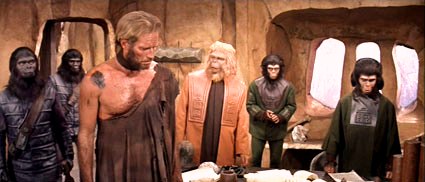
A dominant society has cultivated topsoil to create a province similar to those of the ancient Greek in our history. The central talking apes – conveniently speaking English (not French, but thankfully not Russian or Slavic) – were led by human sympathizers Cornelius and Dr. Zira (Roddy McDowall and Kim Hunter), with the doubting Ministerof Science Dr. Zaius (Maurice Evans) as an opponent to the  captured Taylor (Heston), his vocal chords shot to @#!*% . Humans are the stupid and primitive ones, but Heston does get a sensuous companion with Nova (Linda Harrison, left) who is a dream girl mute.
captured Taylor (Heston), his vocal chords shot to @#!*% . Humans are the stupid and primitive ones, but Heston does get a sensuous companion with Nova (Linda Harrison, left) who is a dream girl mute.
“Take your stinking paws off me, you @#!*% dirty ape,” the one human plea that is an anti-establishment threat. Dr. Zaius and the other governing body of apes immediately want to shut up a talking human because it’s a threat to the pyramid of life. If humans are treated with dignity then they would no longer be able to dissect them. You can’t suppress Homosapien rights forever, so leave it to Heston to emancipate from the zoo menagerie and set on a hopeful embark on his own quest for human civility if there is any beyond the outreaches of the Forbidden Zone.
A box office hit in its release ($32 million on a $6 million budget), it not only was a stand-out science fiction film then but stands up as brawny entertainment today. The French novel it was based upon by Pierre Boulle in 1963 was adapted to the screen by Rod Serling of “The Twilight Zone,” one of the great classic television series. Serling’s trademark method was to hook his audience with sociological issues, build his plots around paradoxes, and then hit us with a final discovery that had your mind winding back to its beginning to reconsider the whole story in a brand new light. He was the right man for the job.
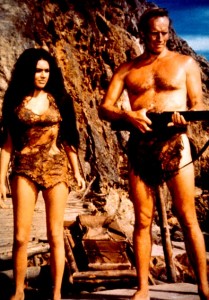 “Apes” was so thrilling and ripe for possibilities that it seemed absolutely right to spawn more sequels to give us more adventures and revelations. The possibilities seemed endless, but the four sequels that followed managed to slip up again and again handicapped mostly by poor filmmaking. If you look at the years of succession you can see the quick follow-up was rushed on each installment to cash in on a fevered fast buck.
“Apes” was so thrilling and ripe for possibilities that it seemed absolutely right to spawn more sequels to give us more adventures and revelations. The possibilities seemed endless, but the four sequels that followed managed to slip up again and again handicapped mostly by poor filmmaking. If you look at the years of succession you can see the quick follow-up was rushed on each installment to cash in on a fevered fast buck.
“Beneath the Planet of the Apes” (1970), the second in the series, ventured to explore underground societies that might occupy human resistance but basically stunk up a promising plot. “Escape from the Planet of the Apes” (1971), the third in the series, was closest to delivering a story with depth. “Conquest for the Planet of the Apes” (1972), the fourth in the series, was the worst of them with measly story development. “Battle for the Planet of the Apes” (1973), the final chapter, had series burnout and a predictable and soggy finish. “Planet of the Apes” (2001) was the first reboot done by Tim Burton, but was a pointless and terribly made exercise that clumped along and was photographed with dreary murkiness – so bad it stands in abandonment. Grade: A-
The current “Rise of the Planet of the Apes,” with its San Francisco Golden Gate bridge climax, is the reboot done right managing to construct interesting sci-fi origins in such a way that has us psyched for upcoming sequels. Four sequels would be too much, but a trilogy would be my idea to cap the saga justly.
112 Minutes. Rated G.
Film Cousins: “Beneath the Planet of the Apes” (1970); “Escape from the Planet of the Apes” (1971); “Planet of the Apes” (2001); “Rise of the Planet of the Apes” (2011).
DARKMAN
While the highly exposed “Avengers” are tearing it up currently at the multiplex, are you in the mood for more unconventional superheroes this season? Sam Raimi’s Darkman (1990, 96 Minutes, R) is the rarest comic book style movie in that it was not based on any previous publication – it was an adventure created directly for the screen. Liam Neeson, in strangely one the best performances he ever gave, plays the tragic Dr. Peyton Westlake. He’s a cosmetic dermatologist, i.e. scientist, who develops a new type of synthetic skin to help acid burn victims. Doc’s creation isn’t full-proof – the skin disintegrates after 99 minutes after application. Yes, there’s action: The Doc is beaten to hell, loses the love of his life, and goes into concentrated revenge mode to go after the gangsters that destroyed his life.
“Darkman” is one of the few movies ever made that’s a full-blown operatic Action Symphony. The restless music is by the indomitable Danny Elfman (“Batman,” “Edward Scissorhands”) – he creates implacable notes that are a soulful caliber to “Phantom of the Opera,” and has alternate themes that are rhapsodically vengeful. We’re behind the disfigured Doc because the theme is so forcefully obsessed, propulsive in its frenzy, so needy in the quest to set things right. The score is an emotional drumbeat throughout every scene.
 Of course, Neeson is so ripped apart emotionally – with such conviction – that it’s easy to feel sympathetic. When he uses an expressive high-pitch to connote his feelings, you are moved by the cracks in his voice (He’s a big man attempting not to cry). There’s a reason though why Neeson has carved out a career of playing men that can withstand pain (“Rob Roy,” “Taken,” “The Grey”). It all started with how he demonstrated resilience and indefatigability as Dr. Peyton in “Darkman.”
Of course, Neeson is so ripped apart emotionally – with such conviction – that it’s easy to feel sympathetic. When he uses an expressive high-pitch to connote his feelings, you are moved by the cracks in his voice (He’s a big man attempting not to cry). There’s a reason though why Neeson has carved out a career of playing men that can withstand pain (“Rob Roy,” “Taken,” “The Grey”). It all started with how he demonstrated resilience and indefatigability as Dr. Peyton in “Darkman.”
The woman of his life is attorney Julie who is played by Frances McDormand (“Fargo”), not one of the film’s strengths. She’s not much of a feminine damsel, and never has been in any movie. Her character Julie here, a hardened and independent woman, turns down the Peyton’s proposal of marriage only to yearn for it after he vanishes from his accident. Andie MacDowell (“sex, lies and videotape”), for instance, would have been a good choice. She’s one of the better actresses to project beauty within the traits of lament and remorse.
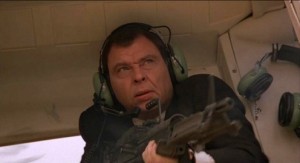 The bad guy is mobster Robert Durant (Larry Drake, a great misogynist pig), who is responsible for much destruction and ruined lives. Part of the reason why Peyton’s revenge is so inflamed is because he hates and despises Durant’s misogyny. Peyton hates this misogynist that hates women so much. A villain this heartless that cannot understand the kind of love he has for his own Julie deserves a merciless death. If McDormand isn’t much of a damsel, then at least Neeson’s beseech to endless love rings true.
The bad guy is mobster Robert Durant (Larry Drake, a great misogynist pig), who is responsible for much destruction and ruined lives. Part of the reason why Peyton’s revenge is so inflamed is because he hates and despises Durant’s misogyny. Peyton hates this misogynist that hates women so much. A villain this heartless that cannot understand the kind of love he has for his own Julie deserves a merciless death. If McDormand isn’t much of a damsel, then at least Neeson’s beseech to endless love rings true.
Once disfigured, Peyton is less than human. The incident that he survived has made him impervious to pain (means he can’t feel any whacks). Neeson is a tall, hulking presence as it is – stalwart and able to throw a punch. To scale his comeback, Peyton uses his science to create masks, to change his face and mimic others, thus he is Darkman. With this, Darkman goes out on the streets and fight diligently, and cunningly, for 99 minutes at a time. He can use his masks to even look like Robert Durant, which means, impersonate him and fire up a rival mob war. Opposing mobs will destroy each other.
 It dismays me to report that the early scenes, particularly when the bad guys whop and smash up our hero, are a little too obnoxiously violent. Semi-gruesome, loud and coarse. This fetishistic nihilism keeps it from being appropriate viewing for pre-teens. That, and the fact that without bandages he’s as hideous in appearance as Freddy Krueger from “A Nightmare on Elm Street.” Somehow though, the work on this film, I’m quite sure of, is what got director Raimi his gig to make “Spiderman” (2002) and its sequels a decade later.
It dismays me to report that the early scenes, particularly when the bad guys whop and smash up our hero, are a little too obnoxiously violent. Semi-gruesome, loud and coarse. This fetishistic nihilism keeps it from being appropriate viewing for pre-teens. That, and the fact that without bandages he’s as hideous in appearance as Freddy Krueger from “A Nightmare on Elm Street.” Somehow though, the work on this film, I’m quite sure of, is what got director Raimi his gig to make “Spiderman” (2002) and its sequels a decade later.
At its best, “Darkman” is complex enough to compare with Christopher Nolan’s “Batman” series, the 2005 “Batman Begins,” I’m thinking, but on a smaller scale. Like Batman, this Darkman acts out of a combination of shame and fury. He hungers for vengeance and at the same time feels like nothing he accomplishes will ever be good enough to have things go back to the way things were. Batman, i.e. Bruce Wayne, never forgave himself for losing his parents, for instance.
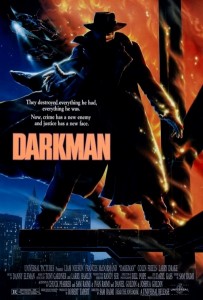 Great sequences, fueled by that angry Elfman music, push the envelope in “Darkman.” Fights atop a skyscraper in construction, or a nifty one where our hero hangs by cable from a moving helicopter, are more than just action set-pieces. They contain an inflamed lyrical passion. What makes Darkman different from the Avengers, is that he’s mortal, unlike them. And he’s willing to die to set things right, even though things never will be. It never really was, but “Darkman” truly is one of the darkest comic book adventures ever. B+
Great sequences, fueled by that angry Elfman music, push the envelope in “Darkman.” Fights atop a skyscraper in construction, or a nifty one where our hero hangs by cable from a moving helicopter, are more than just action set-pieces. They contain an inflamed lyrical passion. What makes Darkman different from the Avengers, is that he’s mortal, unlike them. And he’s willing to die to set things right, even though things never will be. It never really was, but “Darkman” truly is one of the darkest comic book adventures ever. B+
Film Cousins: “Robocop” (1987); “The Crow” (1994); “Batman Begins” (2005); “V for Vendetta” (2006).
BRAINSTORM
Douglas Trumbull brings a beserk visual extravagance to Brainstorm (1983, 106 Minutes, PG). This early 1980’s movie, a first crack at virtual reality possibilities, puts itself through too many hurdles of imagining concepts without explaining them. The movie dazzles regardless, only rarely dawdles. Christopher Walken and Natalie Wood play computer scientists that develop a helmet that transmits telepathic images and memories of other peoples’ experiences and channels them into your own. At first it can be seen for recreational good – there’s a number of sensation videos simulating after burner flight, bobsleds, horse-riding, and sex (they must beware the overload). But then its potential is offered for military application and negative vibes on the helmet feed could theoretically be utilized for mental torture and brainwashing techniques.
Walken is in thoughtful, intelligent mode here but he is allowed a few flights to act nutty. This was Wood’s last film, and she comes across as brilliant but earthy. Louise Fletcher is one of the chain-smoking scientists, she gets a long heart attack scene. From behind the camera, Trumbull finds stunning locations and is a wizard with the tech lab stuff. The virtual reality stuff is confusingly done when it jumps between both first-person and third-person formats, which loses some degree of credibility – don’t people remember through their own first-person eyes, not a third person projection? Trumbull goes for broke in the conclusion – too much lab robotics gone haywire stuff, but he attempts to bring back Star Gate (echoing his special effects technical design on “2001: A Space Odyssey”), leaping to the gates of heaven – turning heaven into some kind of space vacuum – as an ultimate catharsis. Also neat as a kaleidoscopic precursor to the ideas of “Avatar” and “Inception” brought some 26-years later. B
106 Minutes. Rated PG.
Film Cousins: “2001: A Space Odyssey” (1968); “Dreamscape” (1984); “Virtuosity” (1995); “Inception” (2010).
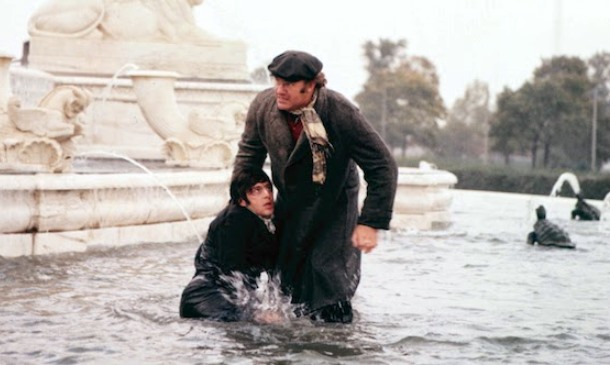
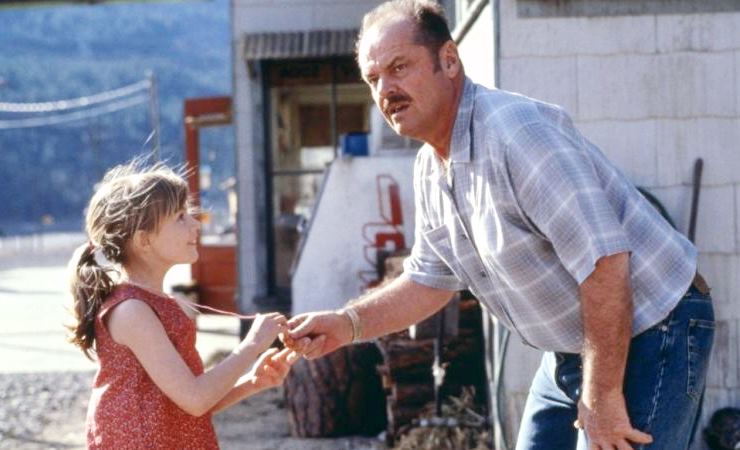
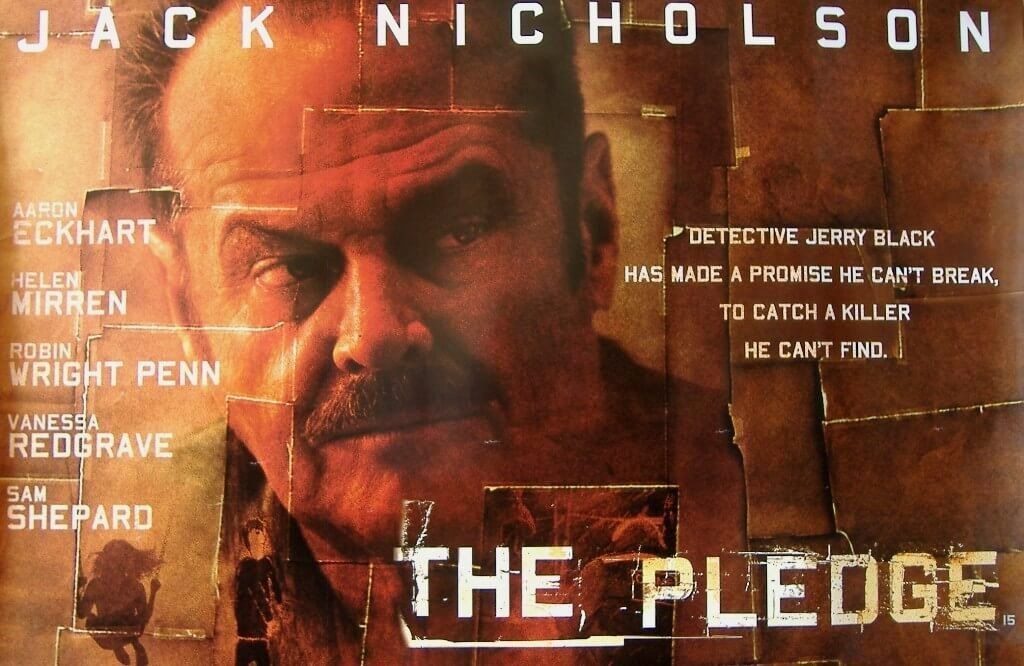

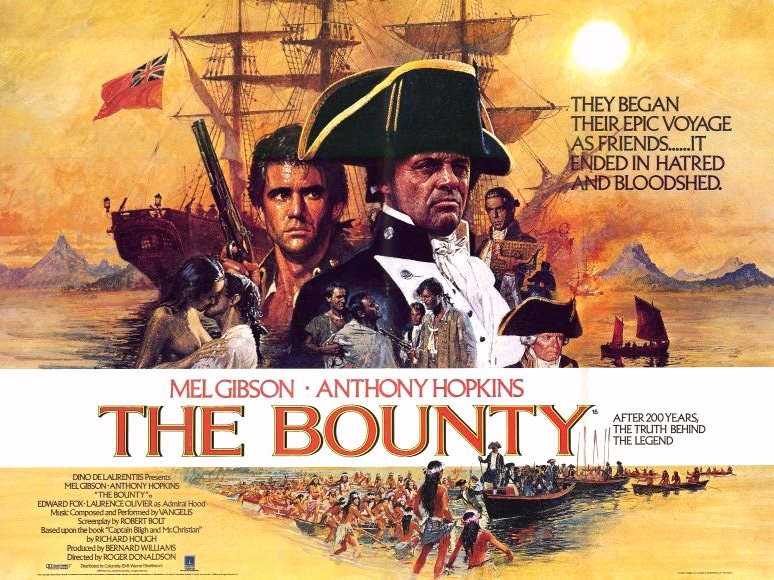
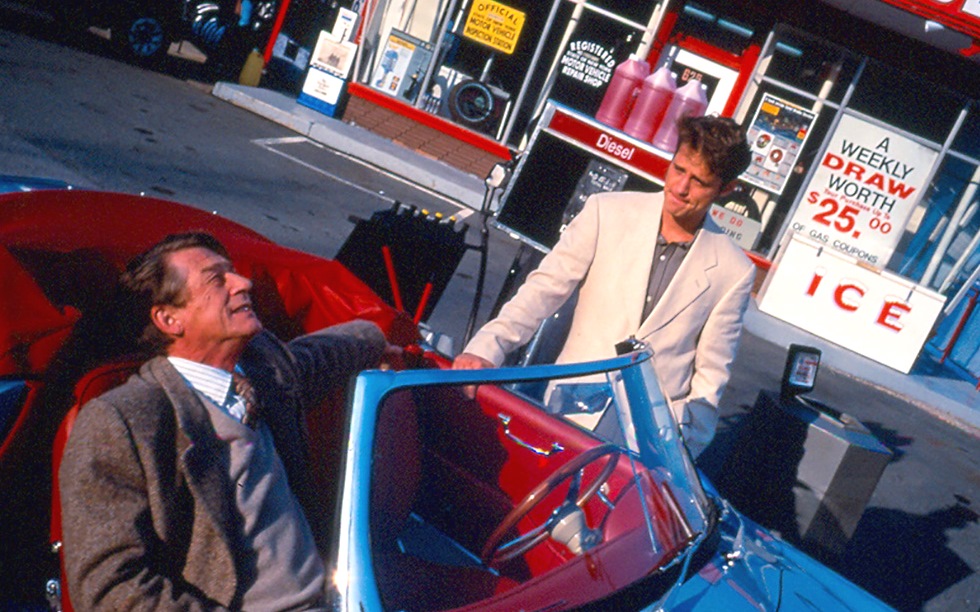

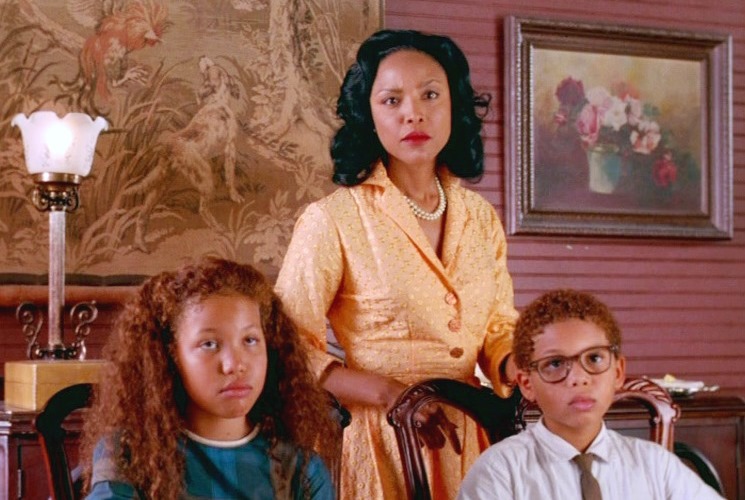
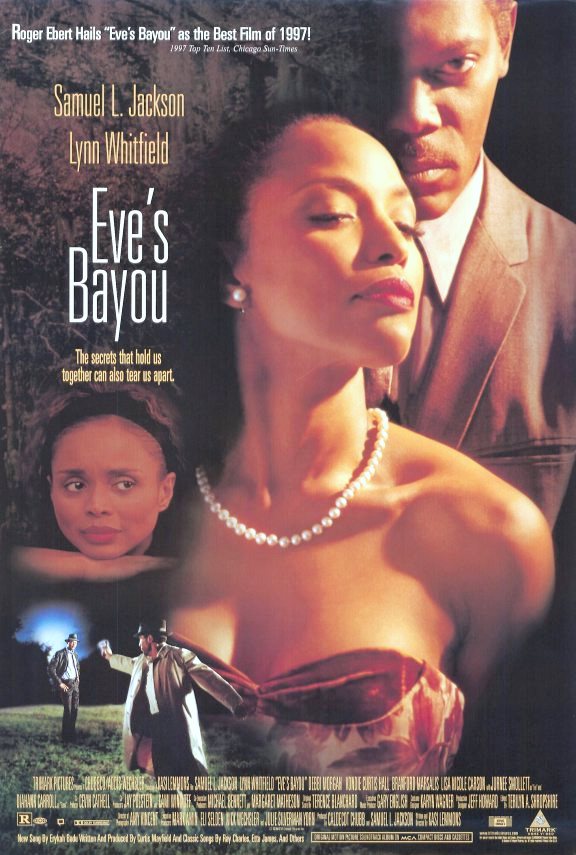
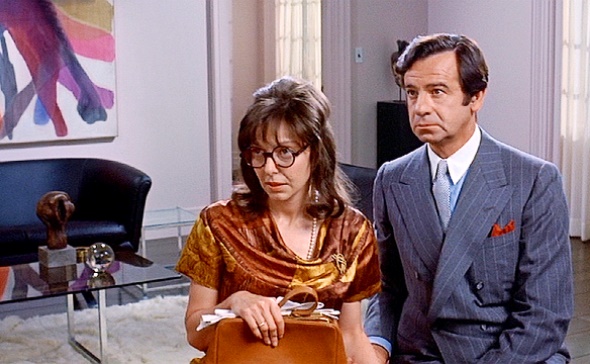
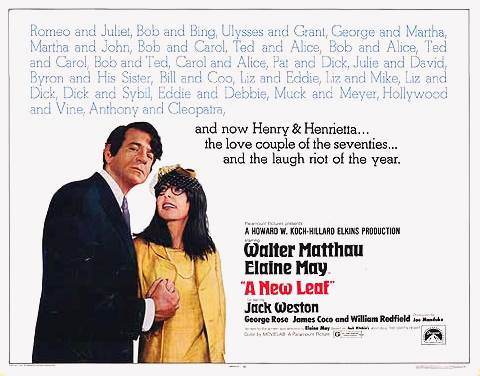
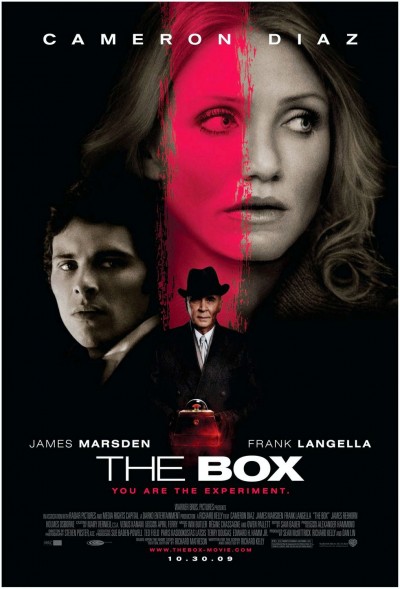
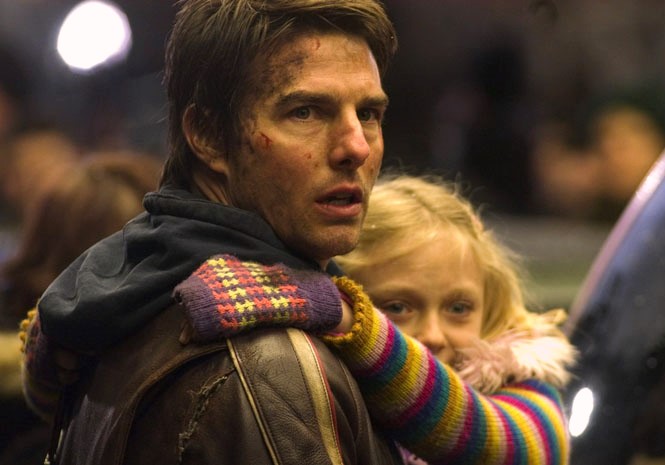

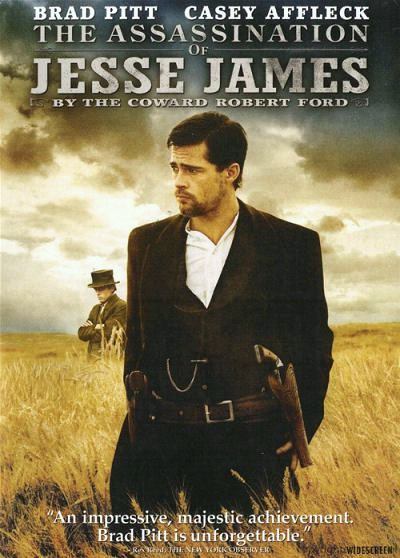


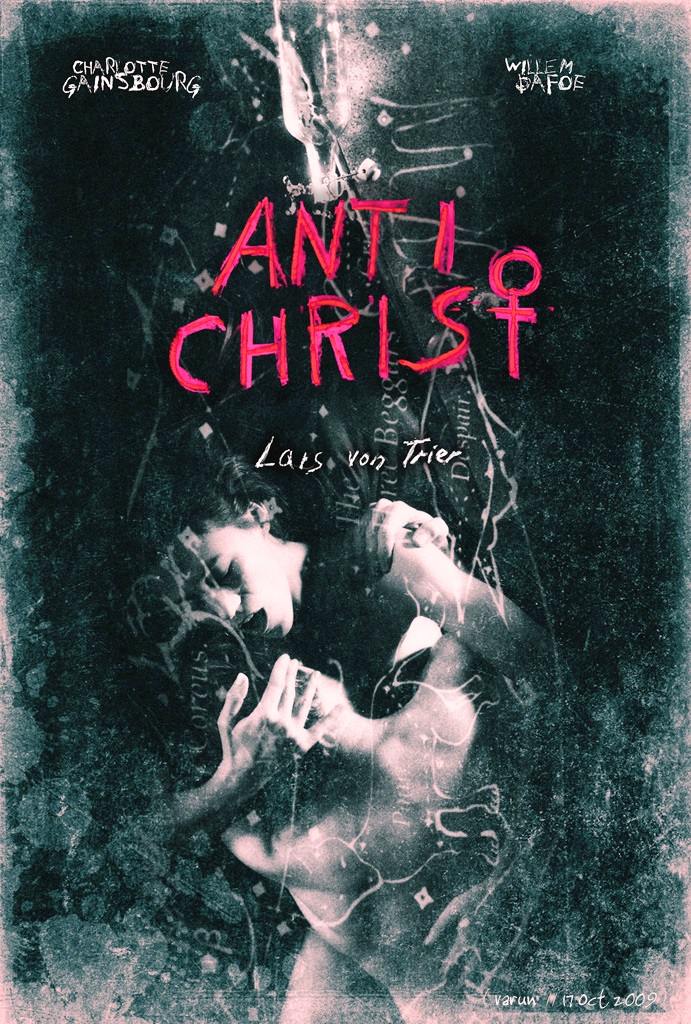

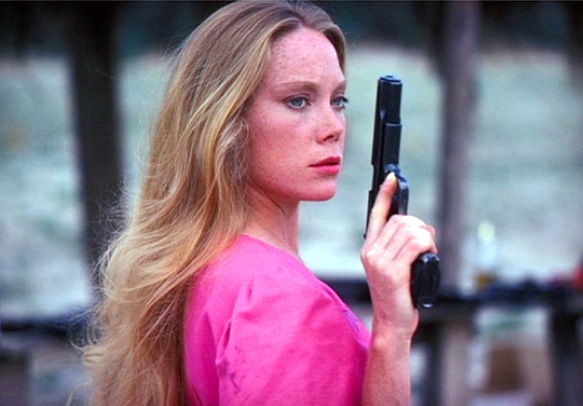
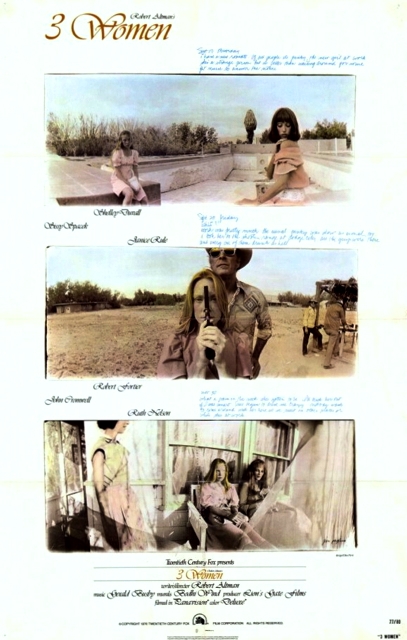
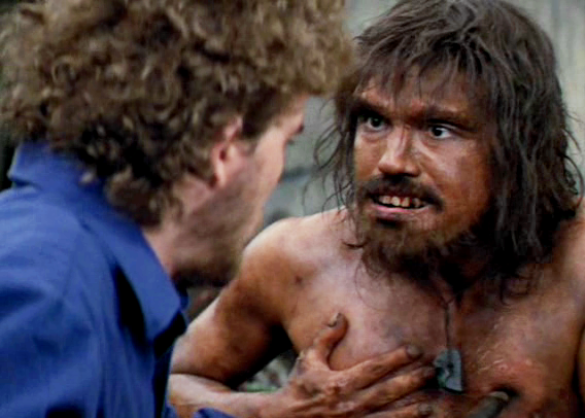


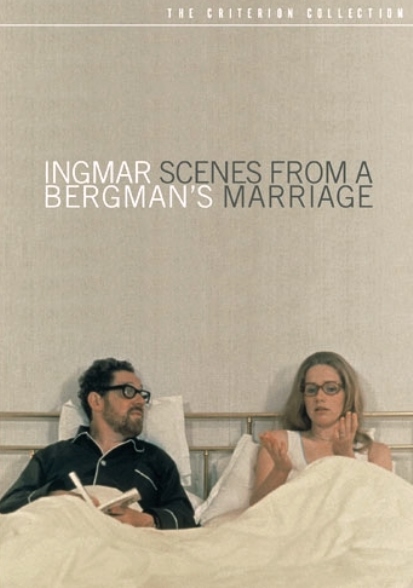

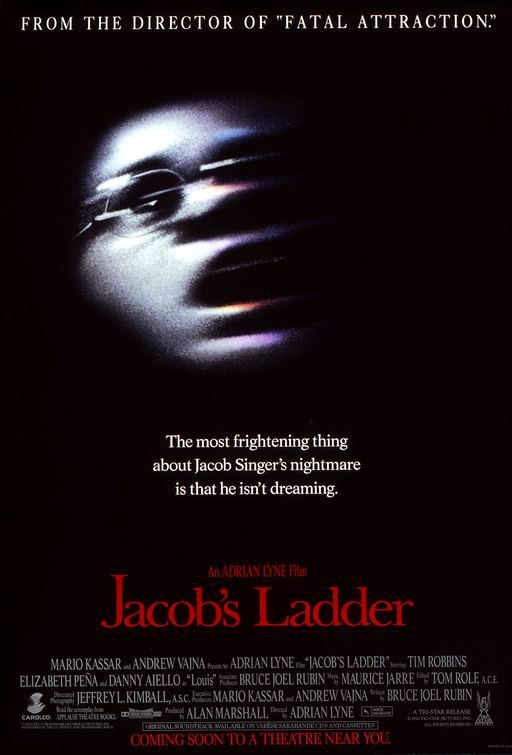


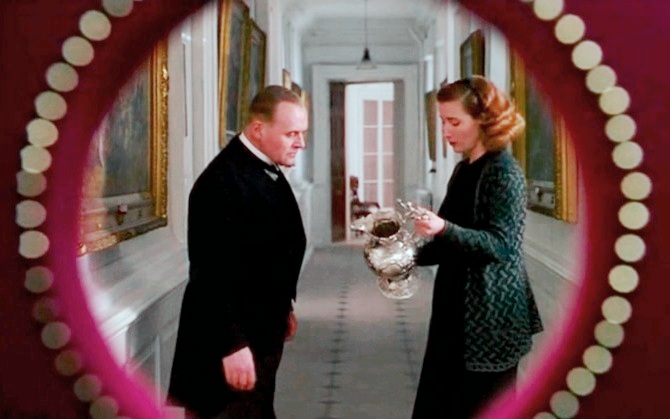
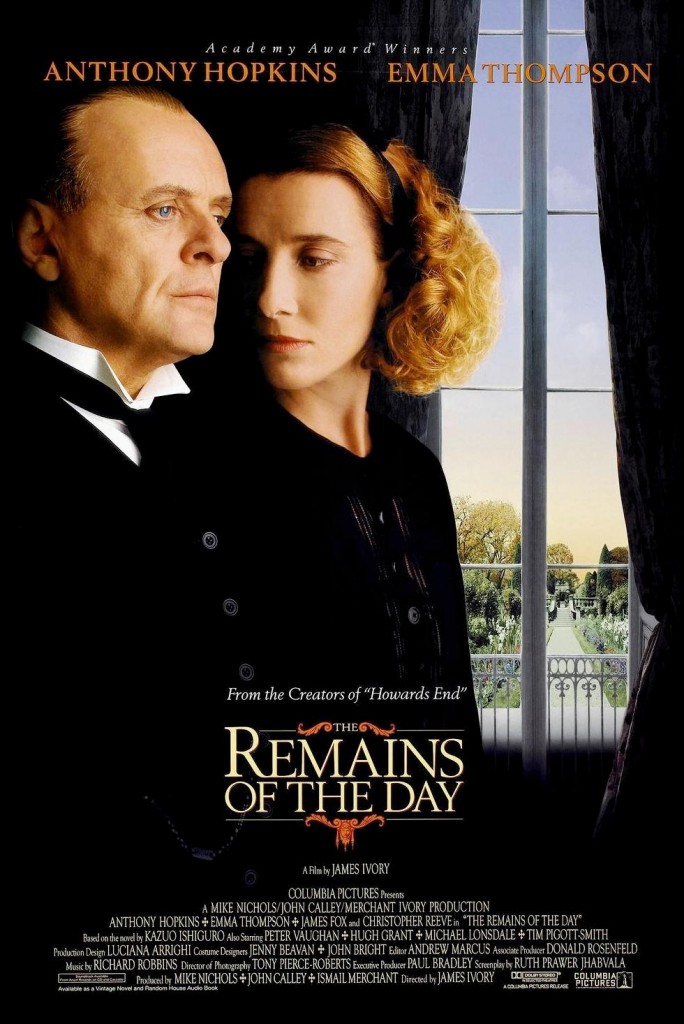



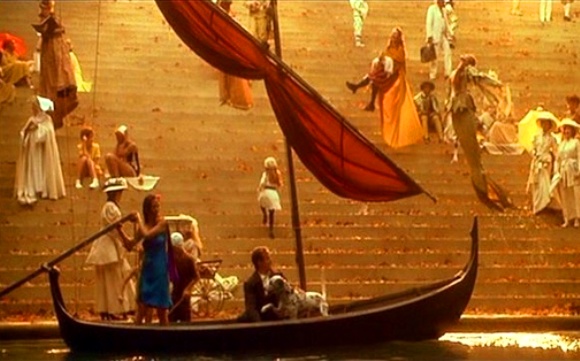
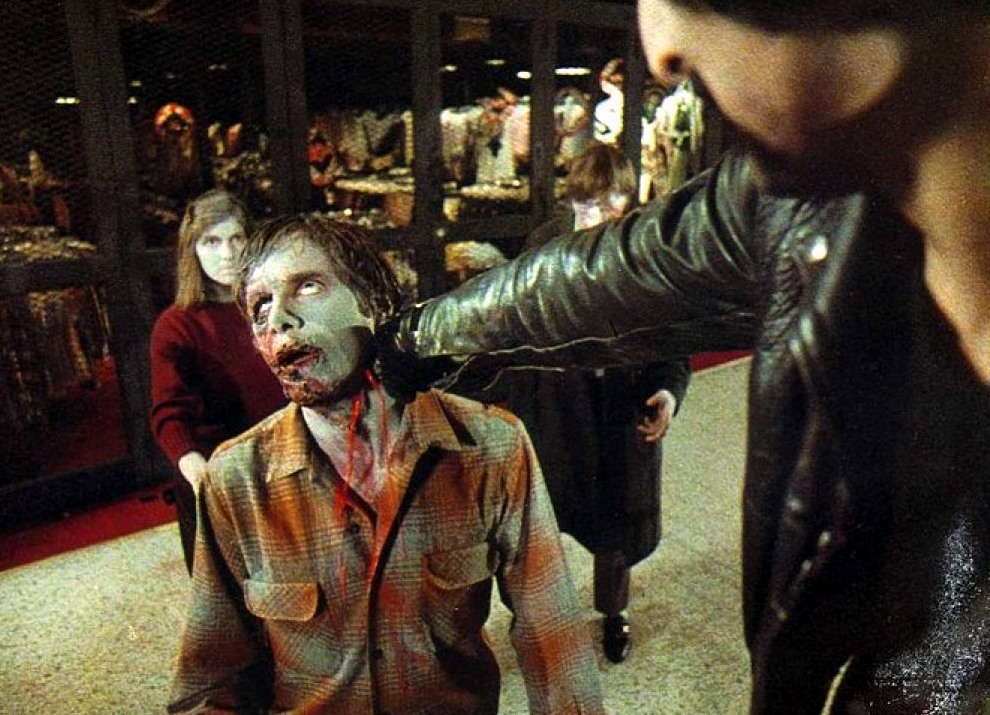

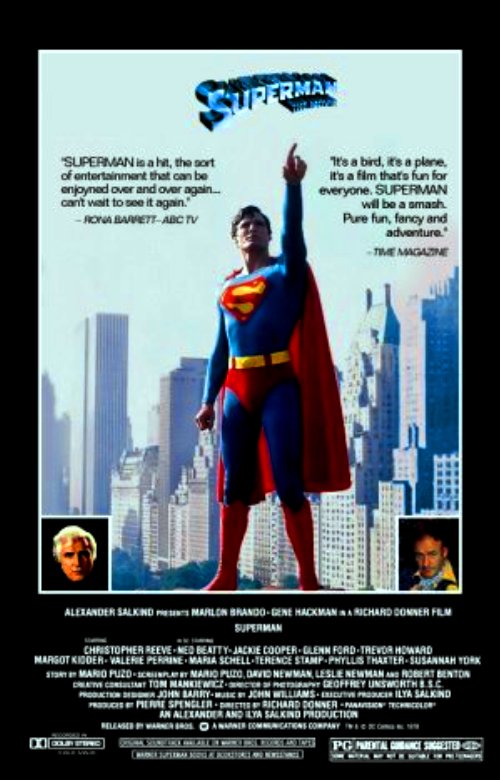
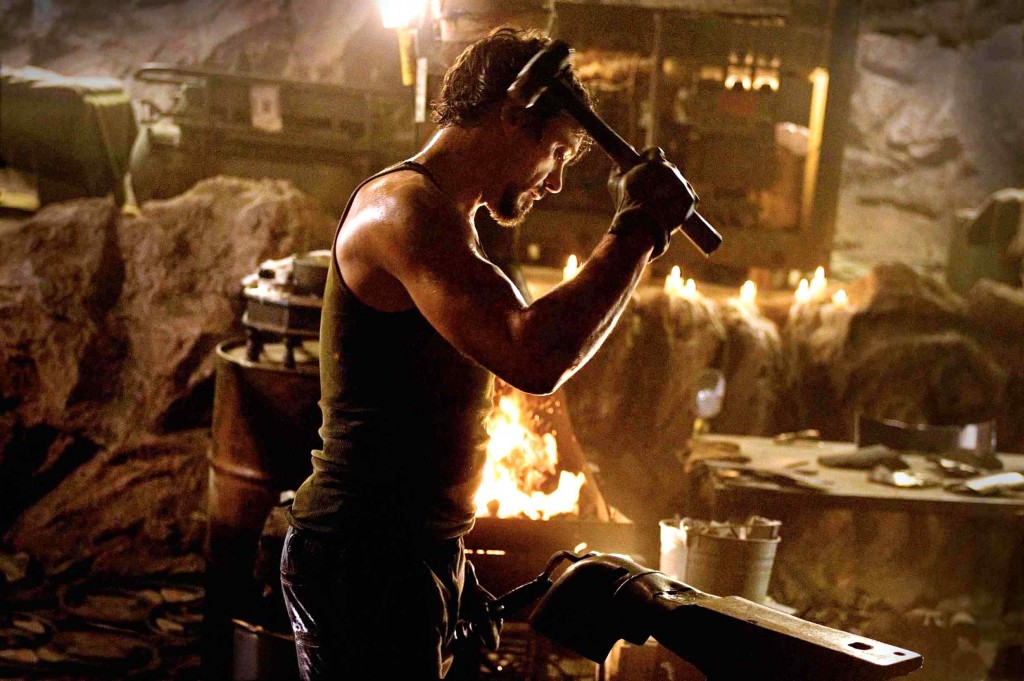
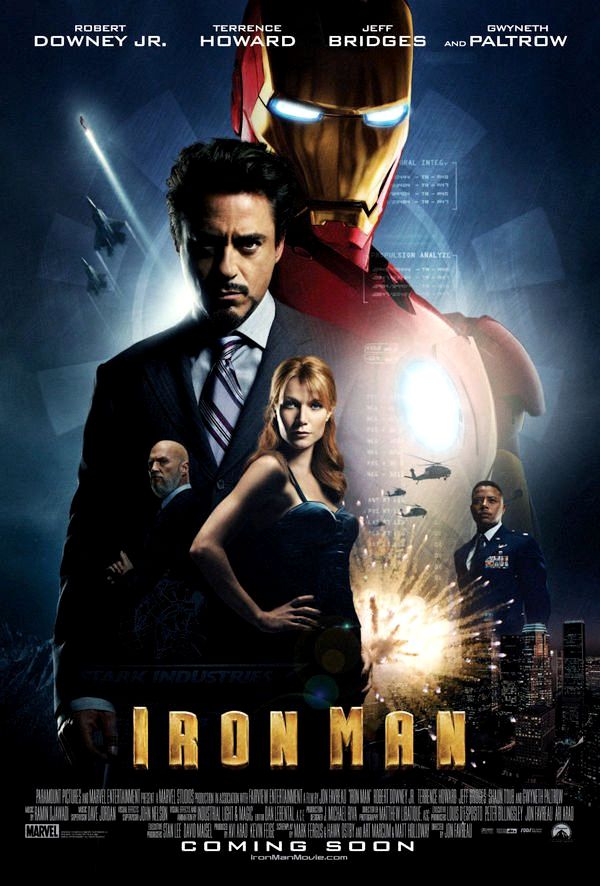
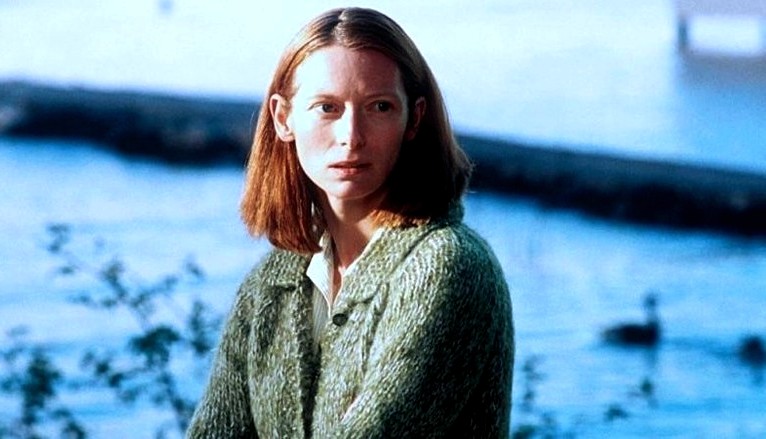
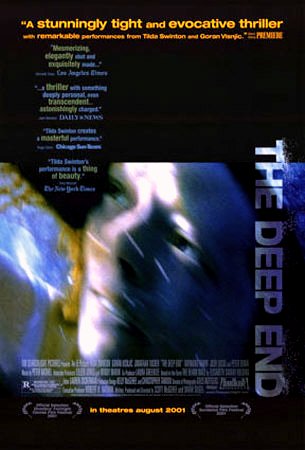
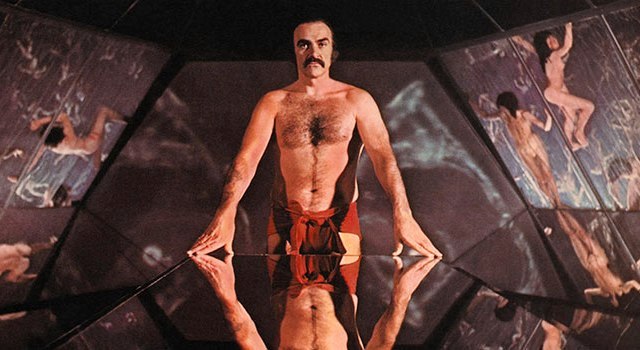



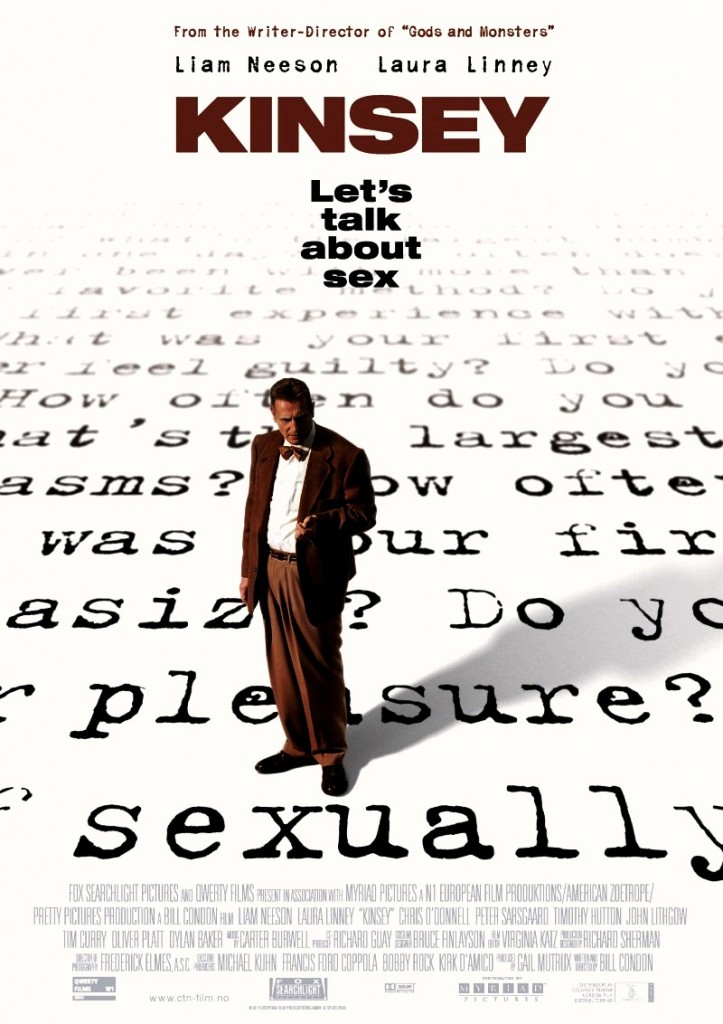


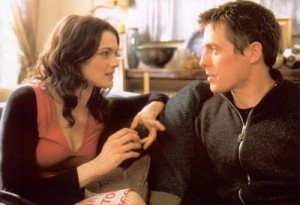
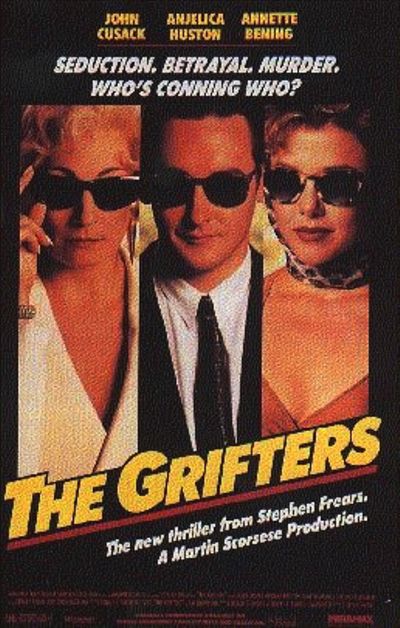
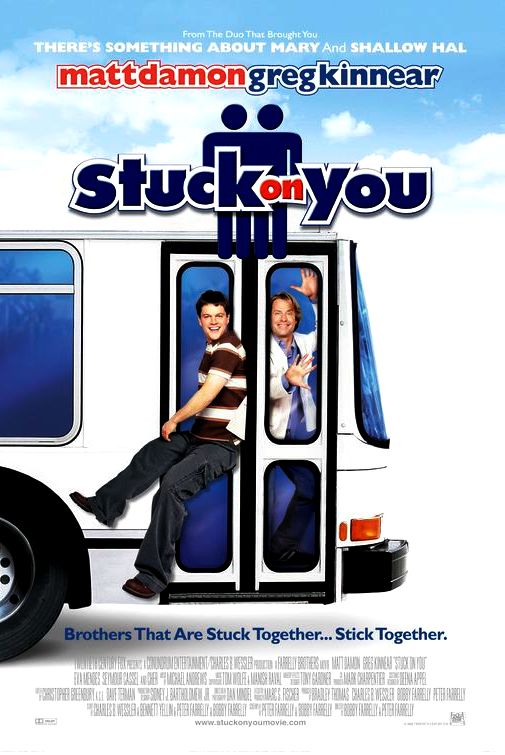

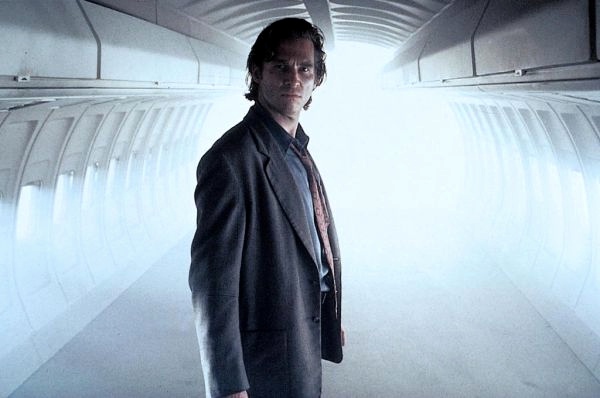

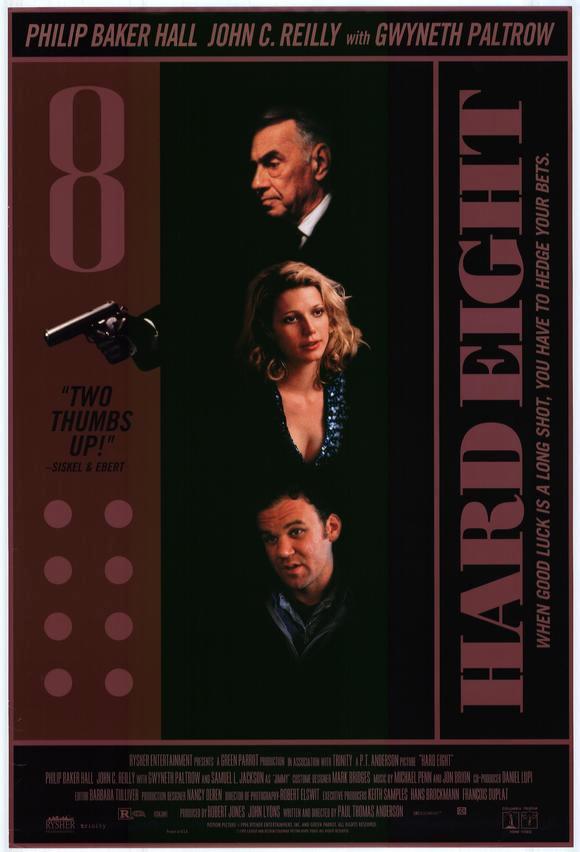
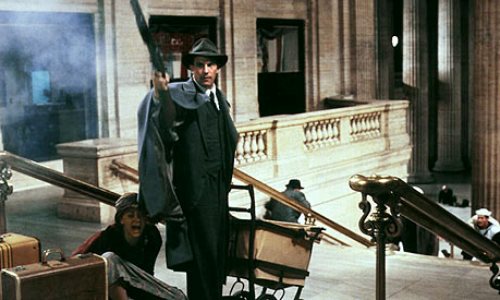

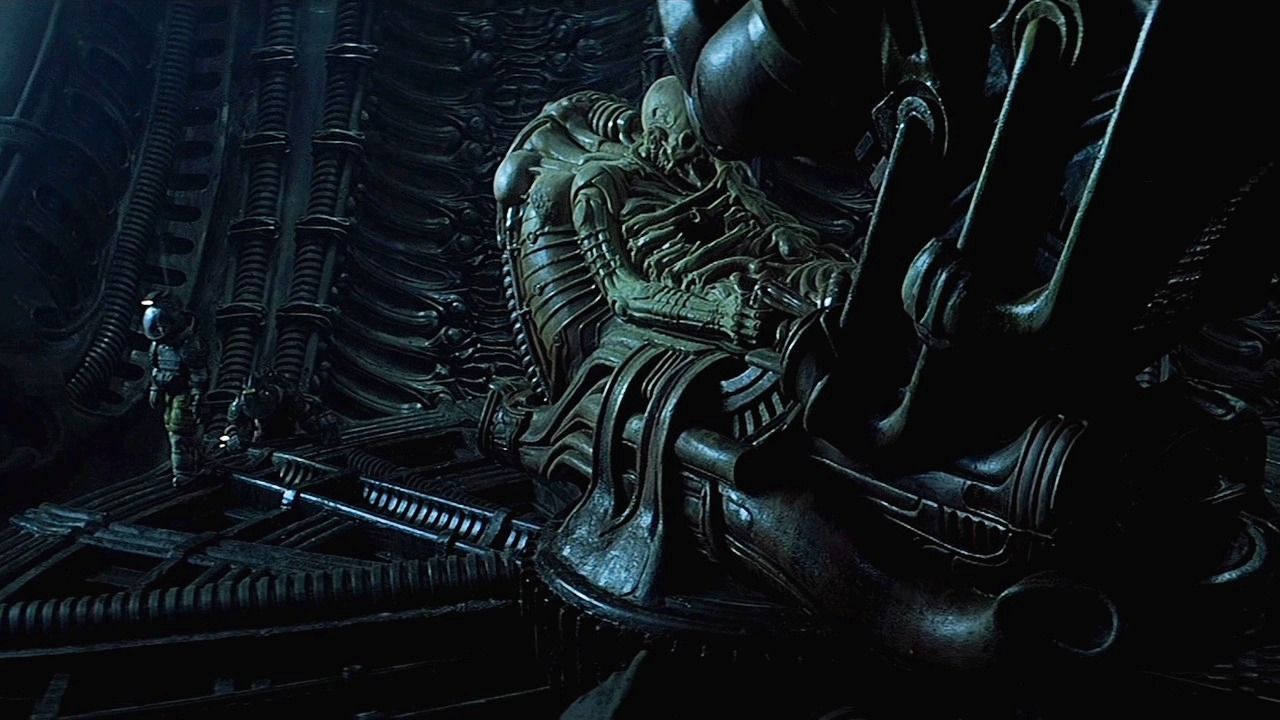
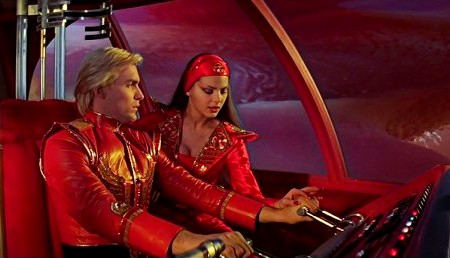
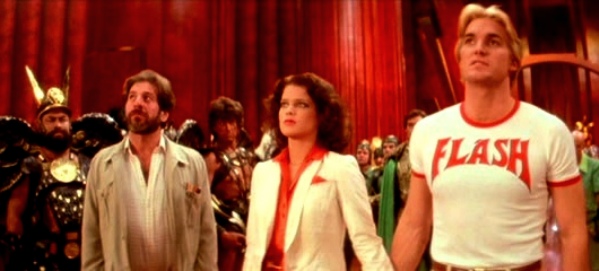


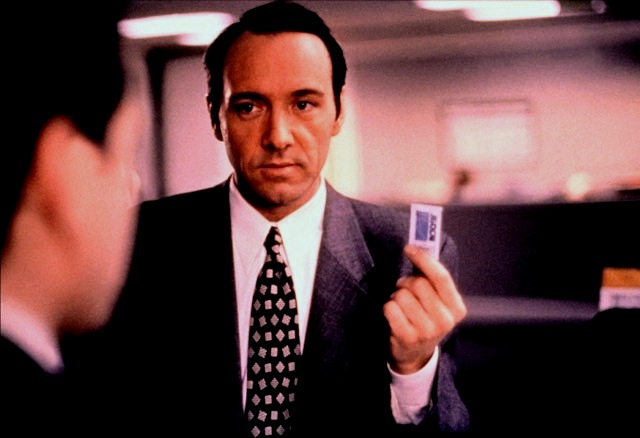
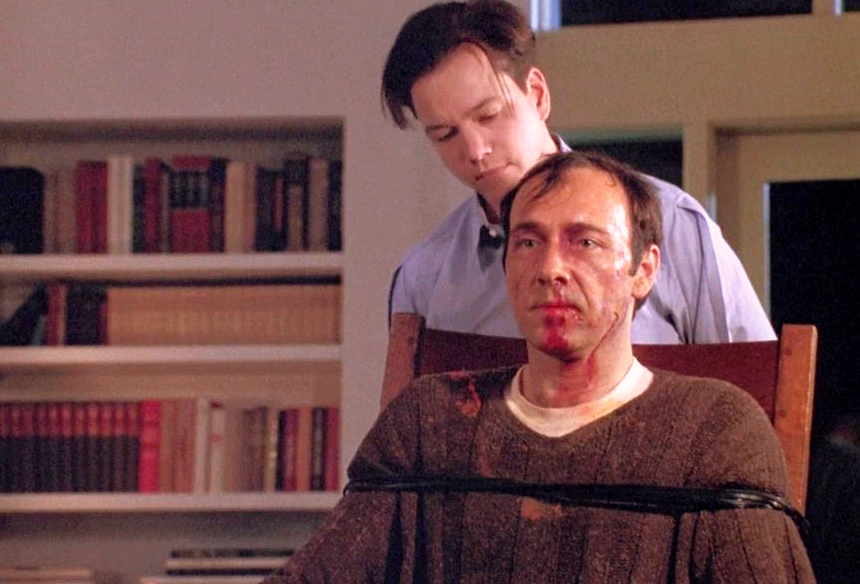
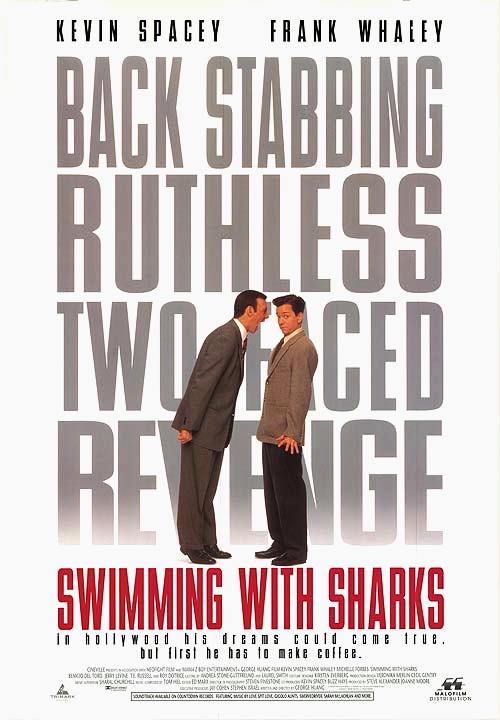
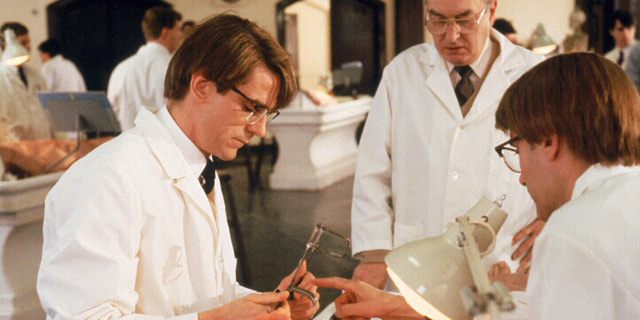
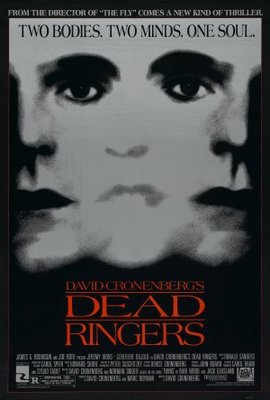
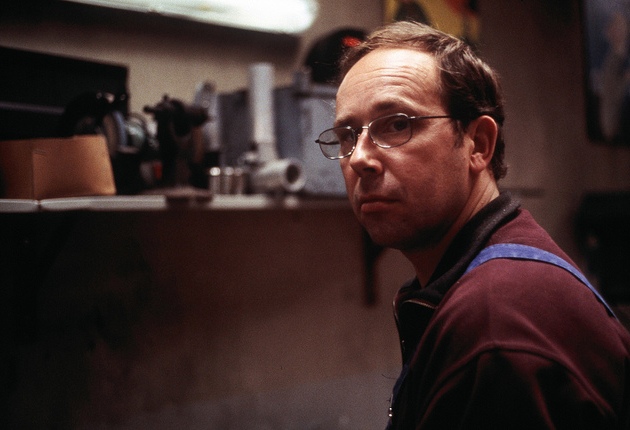

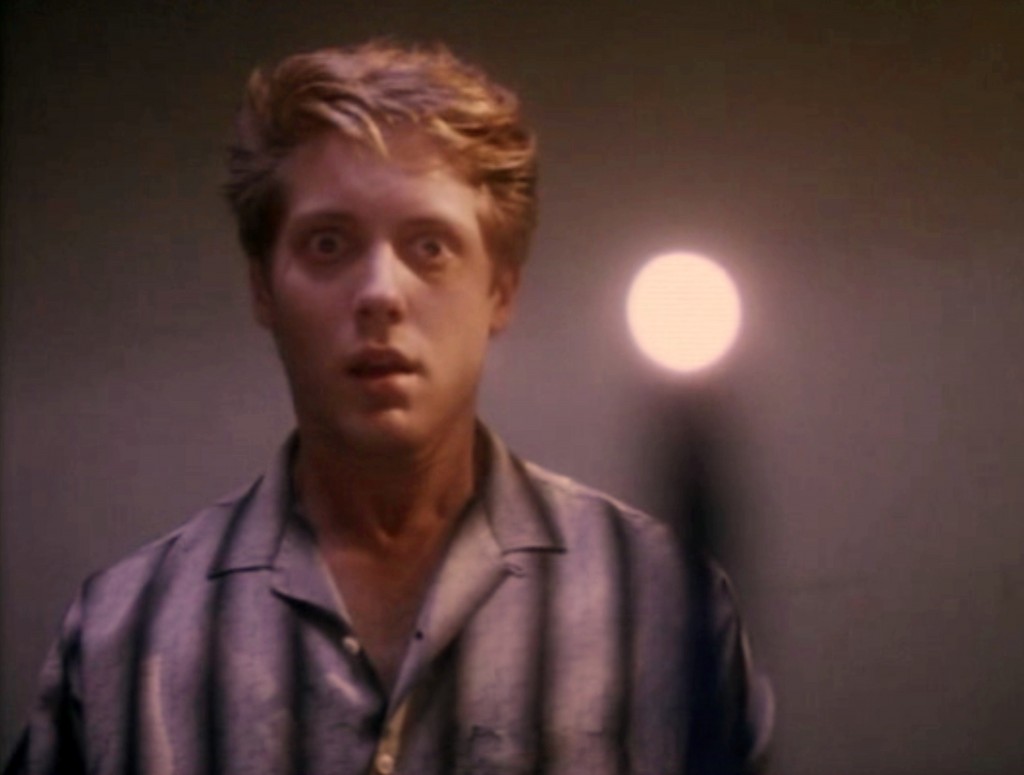
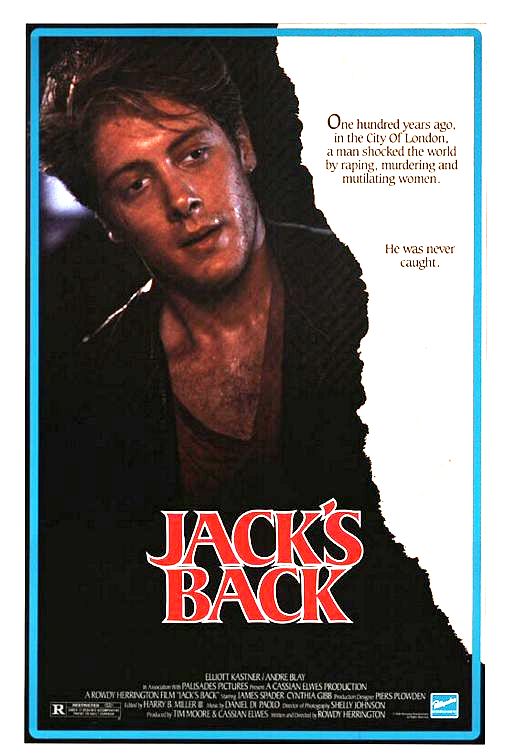

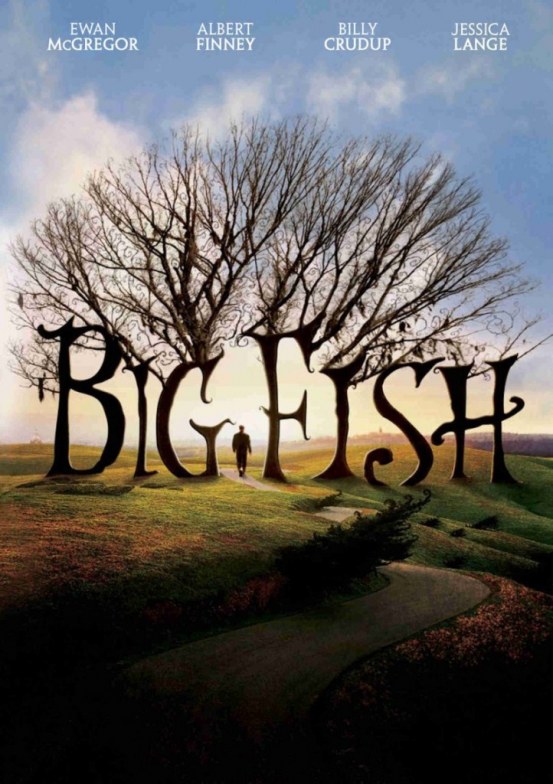

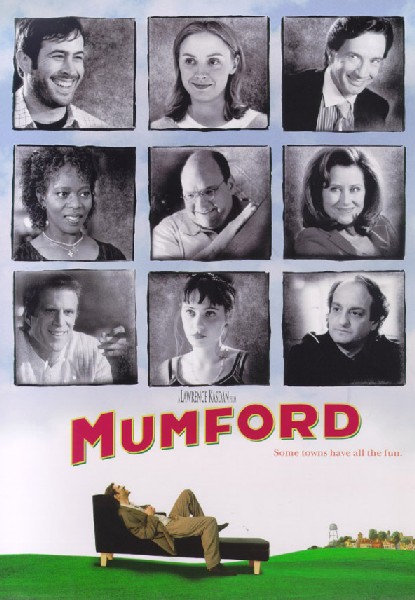

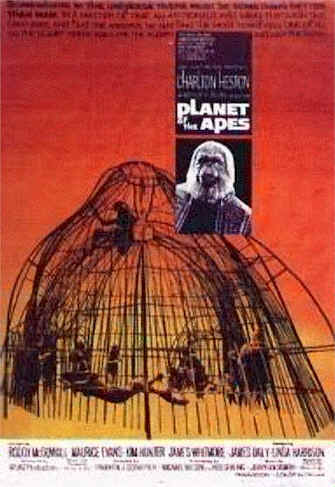
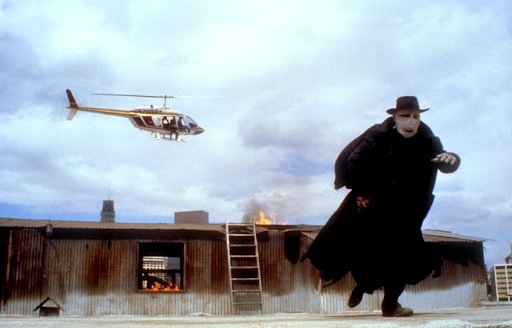
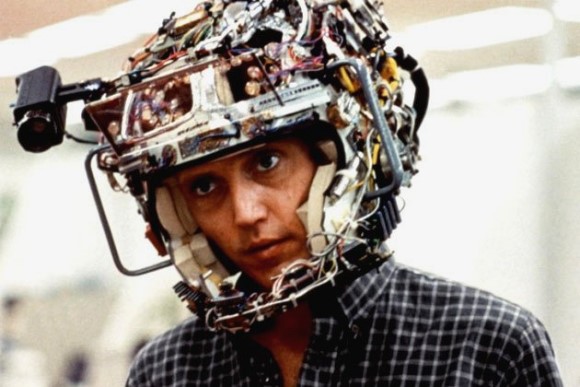



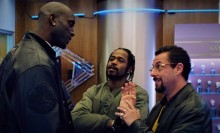

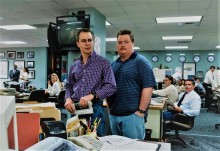




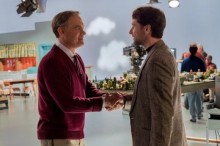






Recent Comments
rudolfmenon Says,
Totally agree. And we left the cinema really disappointed.
rudolfmenon Says,
Really? Wow, then im going to watch this! I could watch District 9 ...
soulreaver99 Says,
The trailer to the movie itself was half-assed. Totally not surprising that ...
hashbrowny Says,
Great family movie...I disagree with your view. Maybe you've lost your ...
calipoppy Says,
Man of Steel is a Hunk of Kryptonite.I enjoyed the movie.